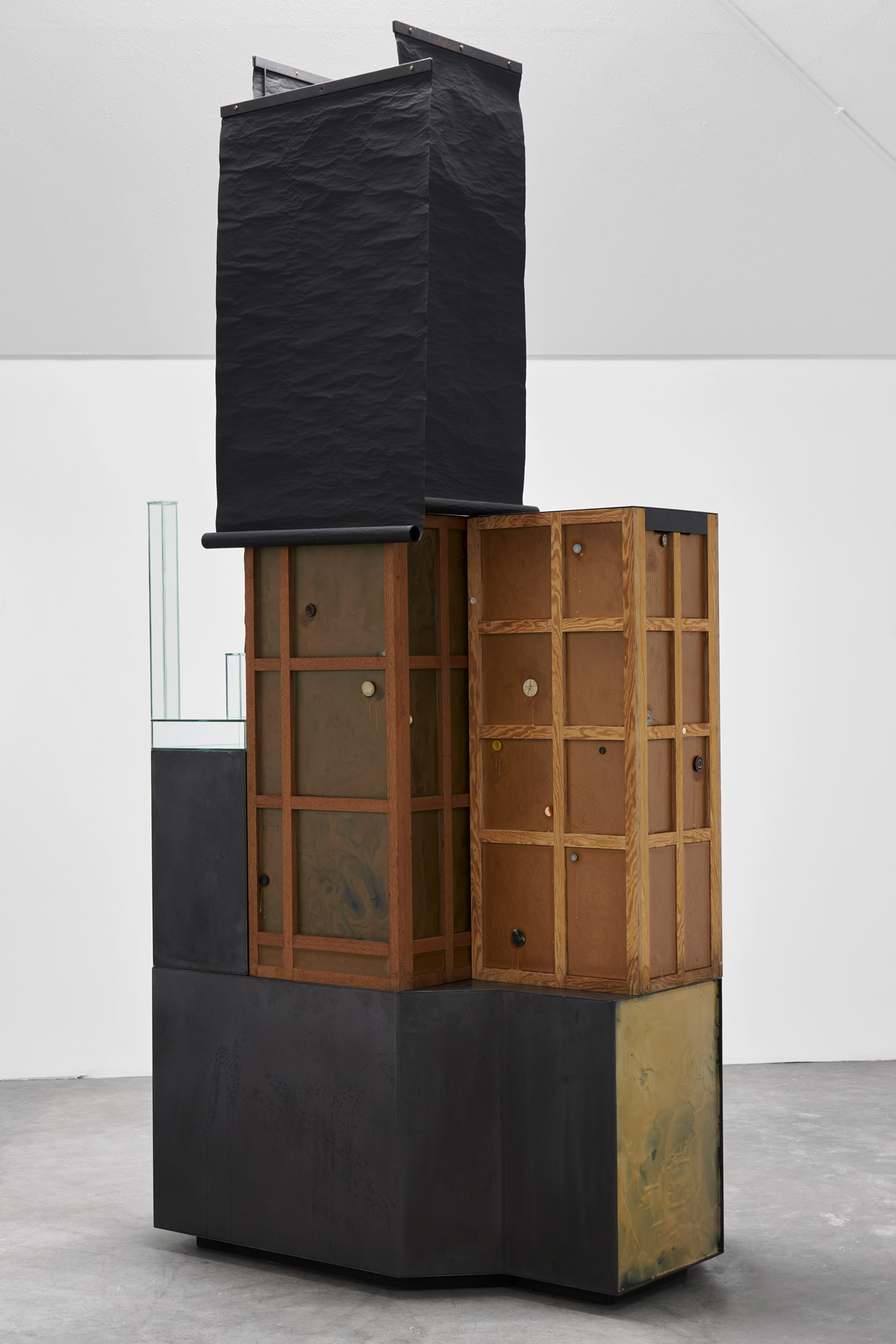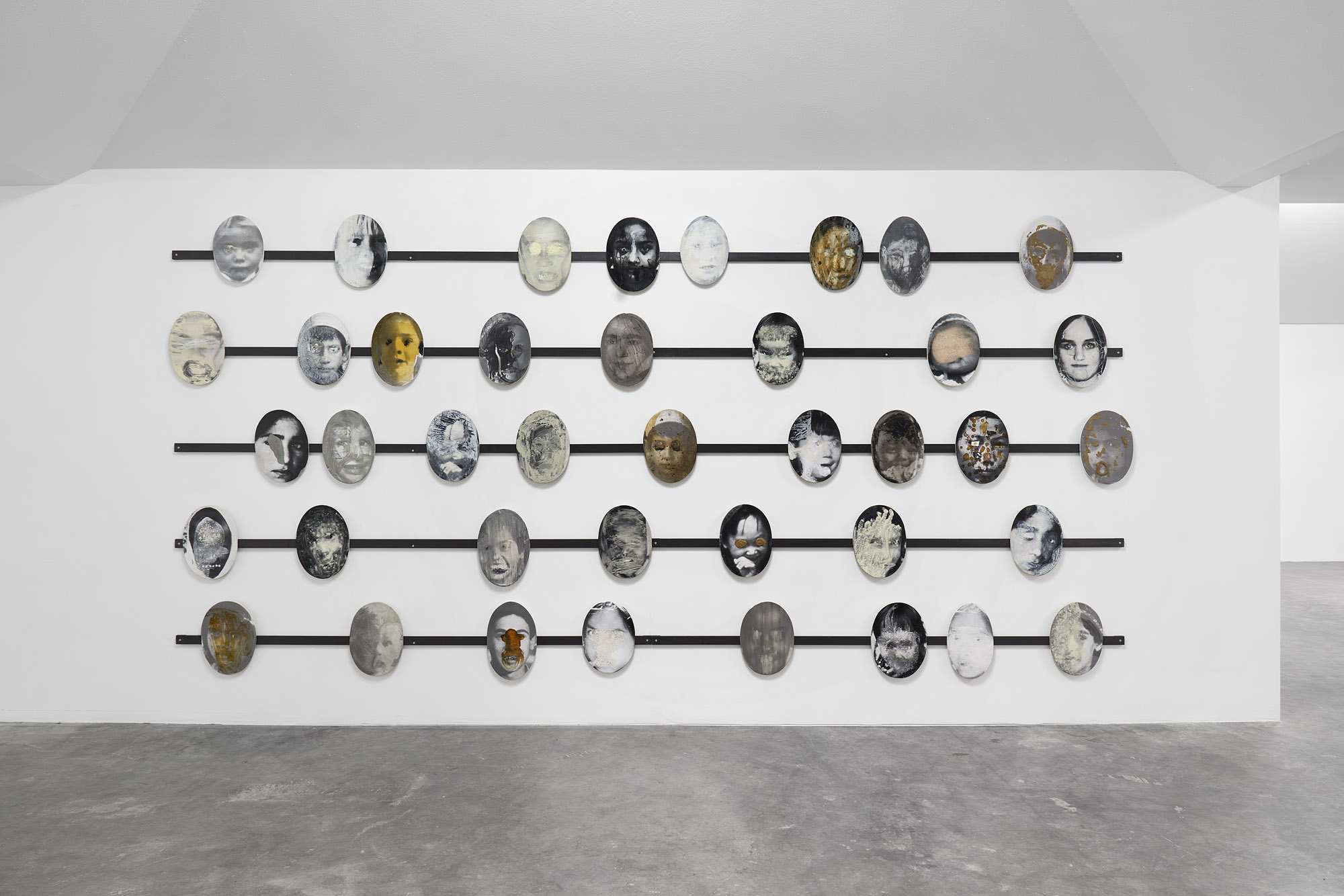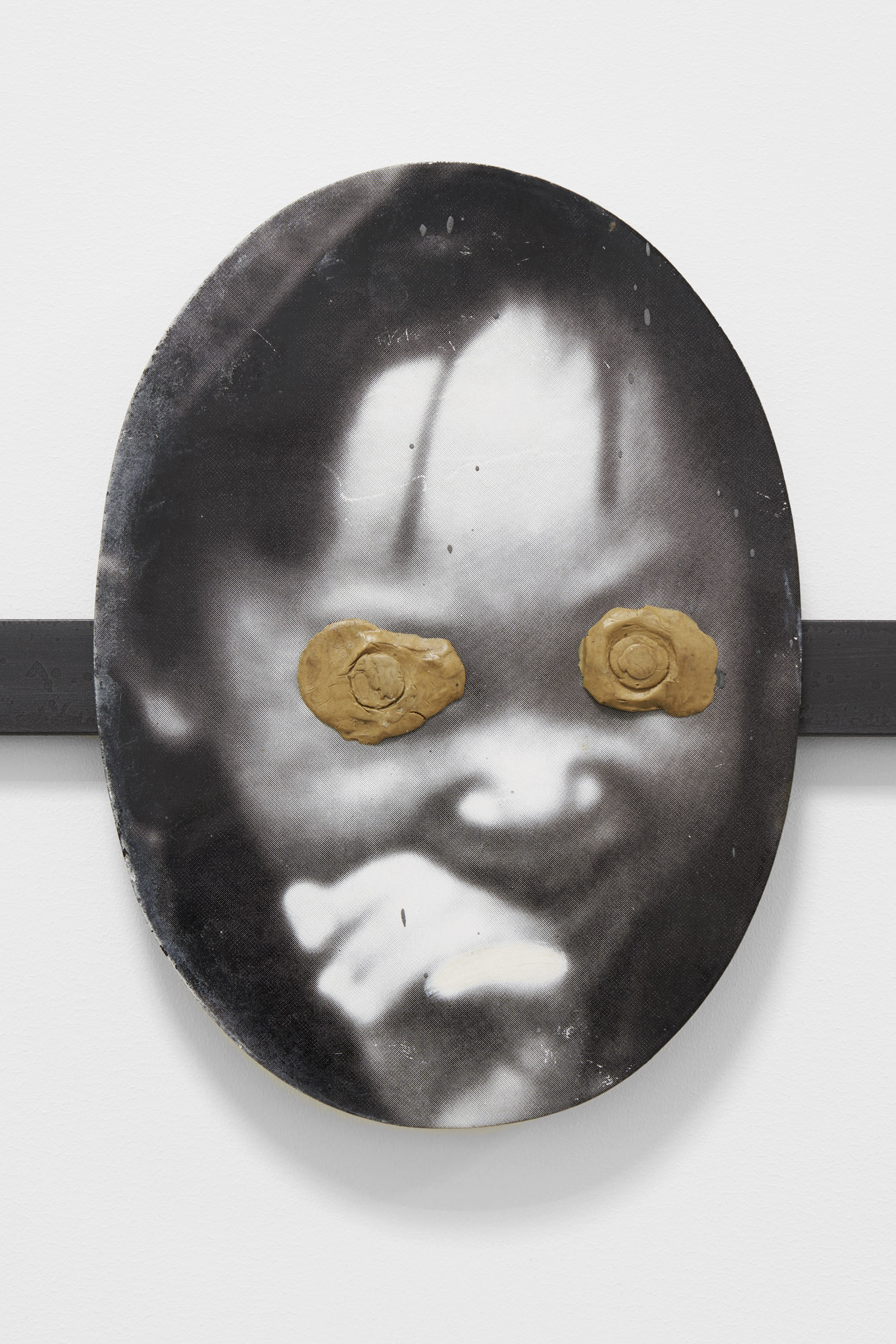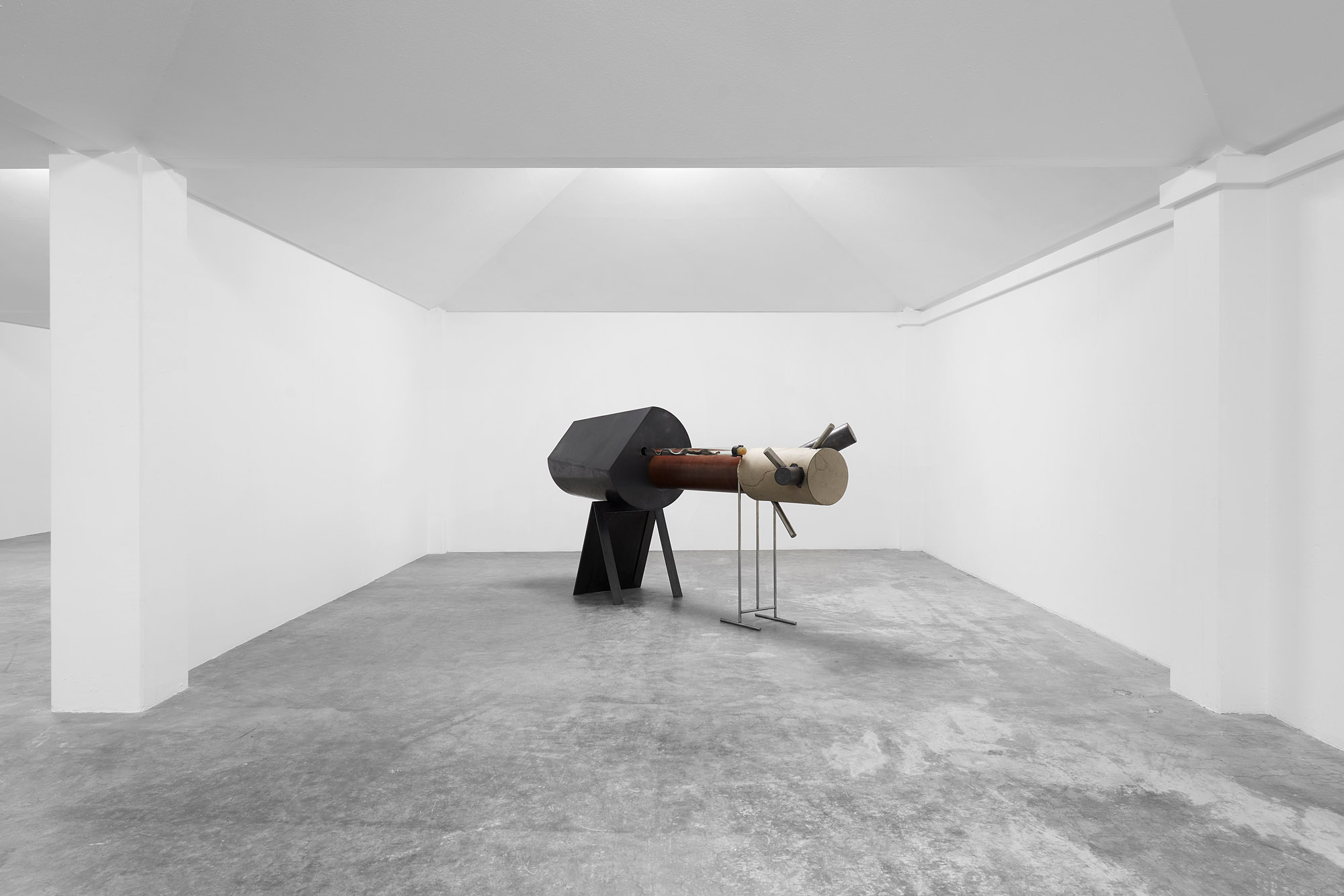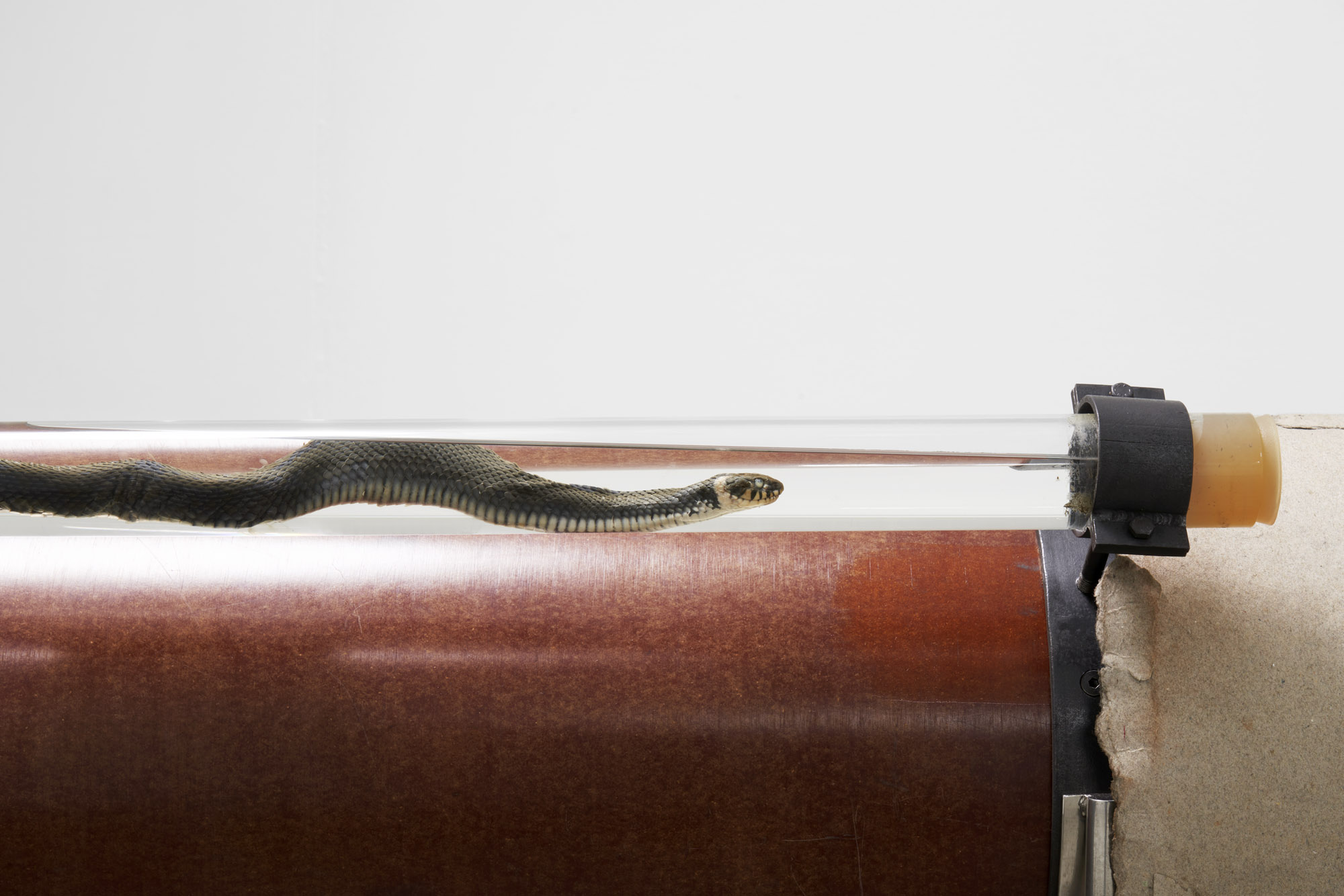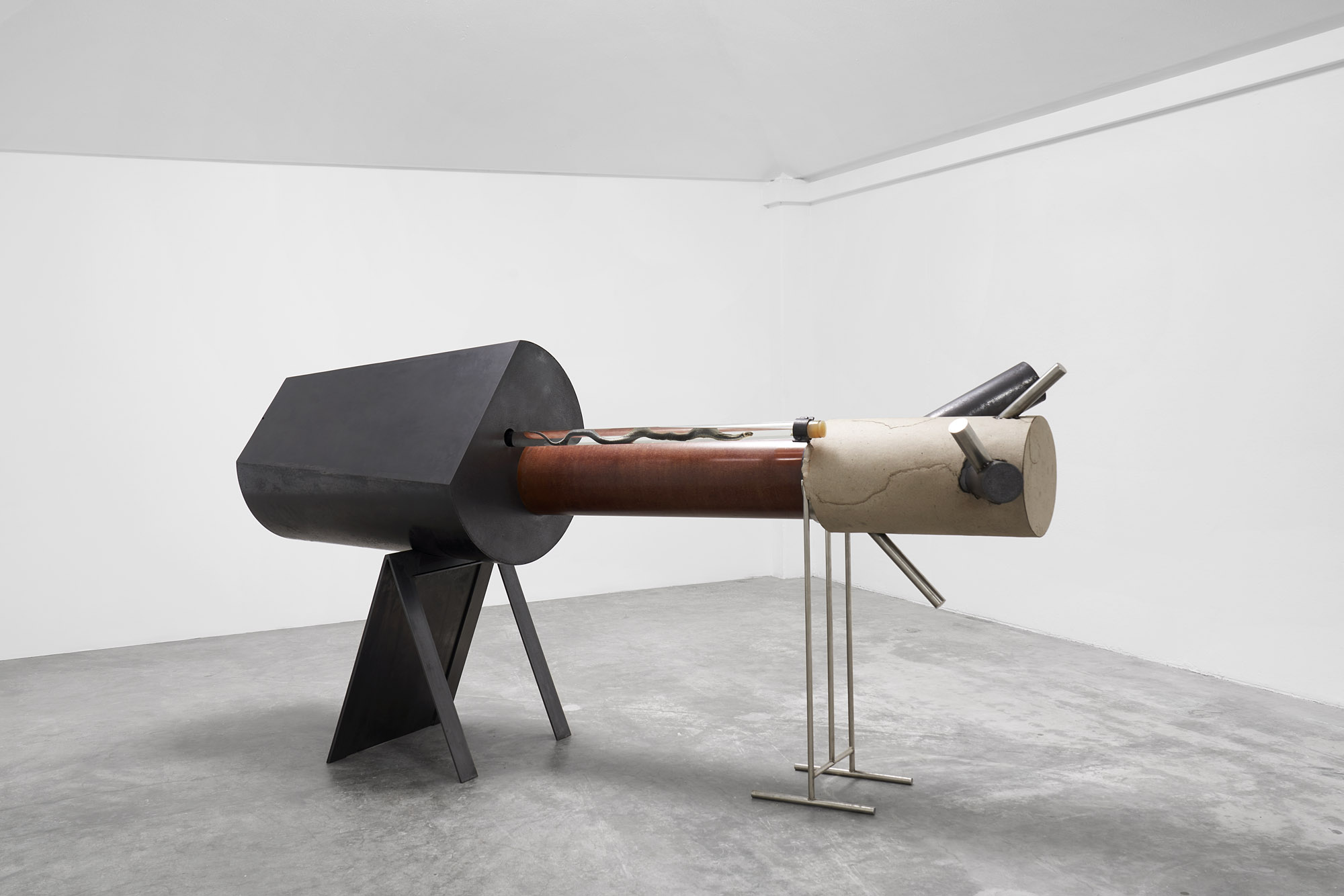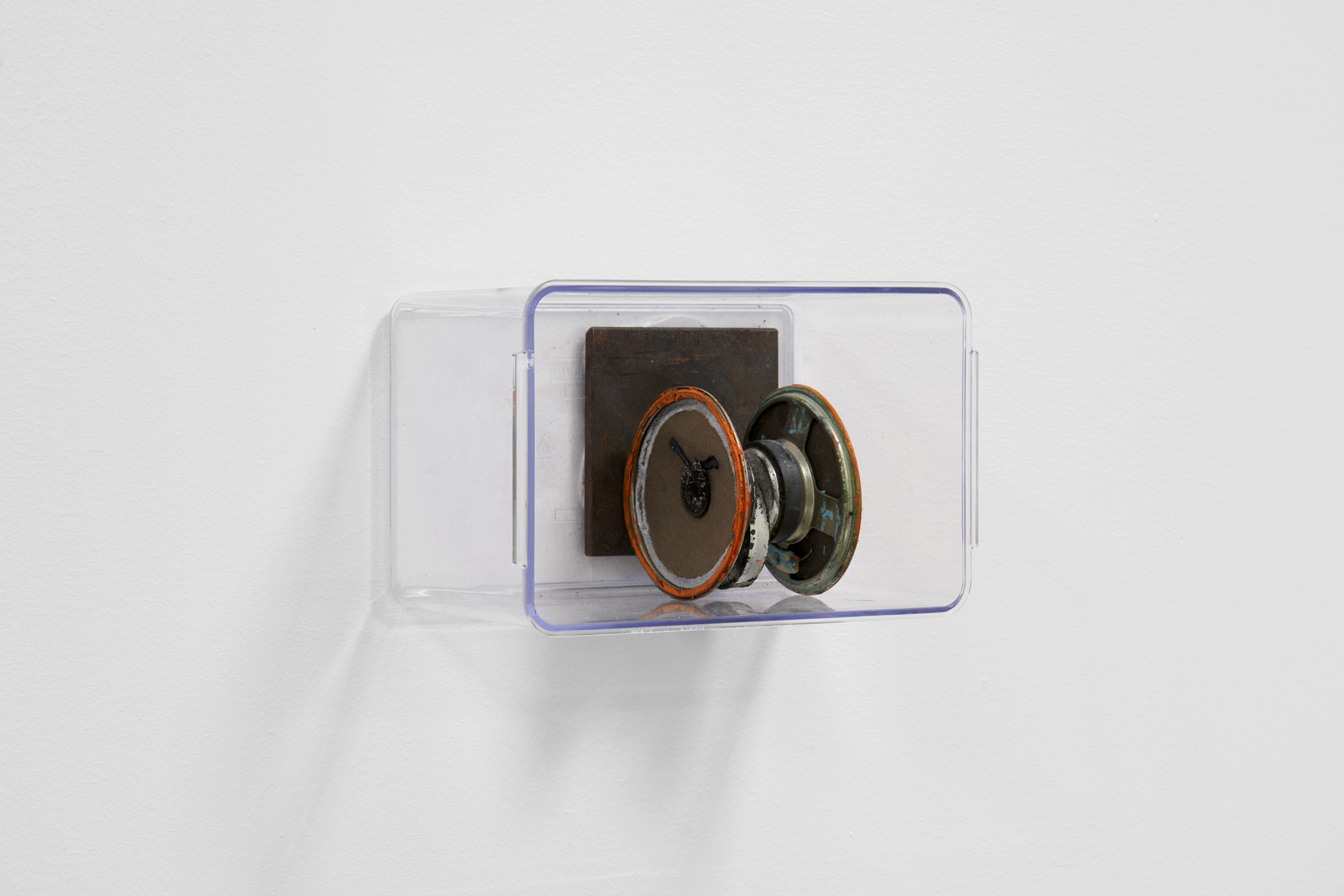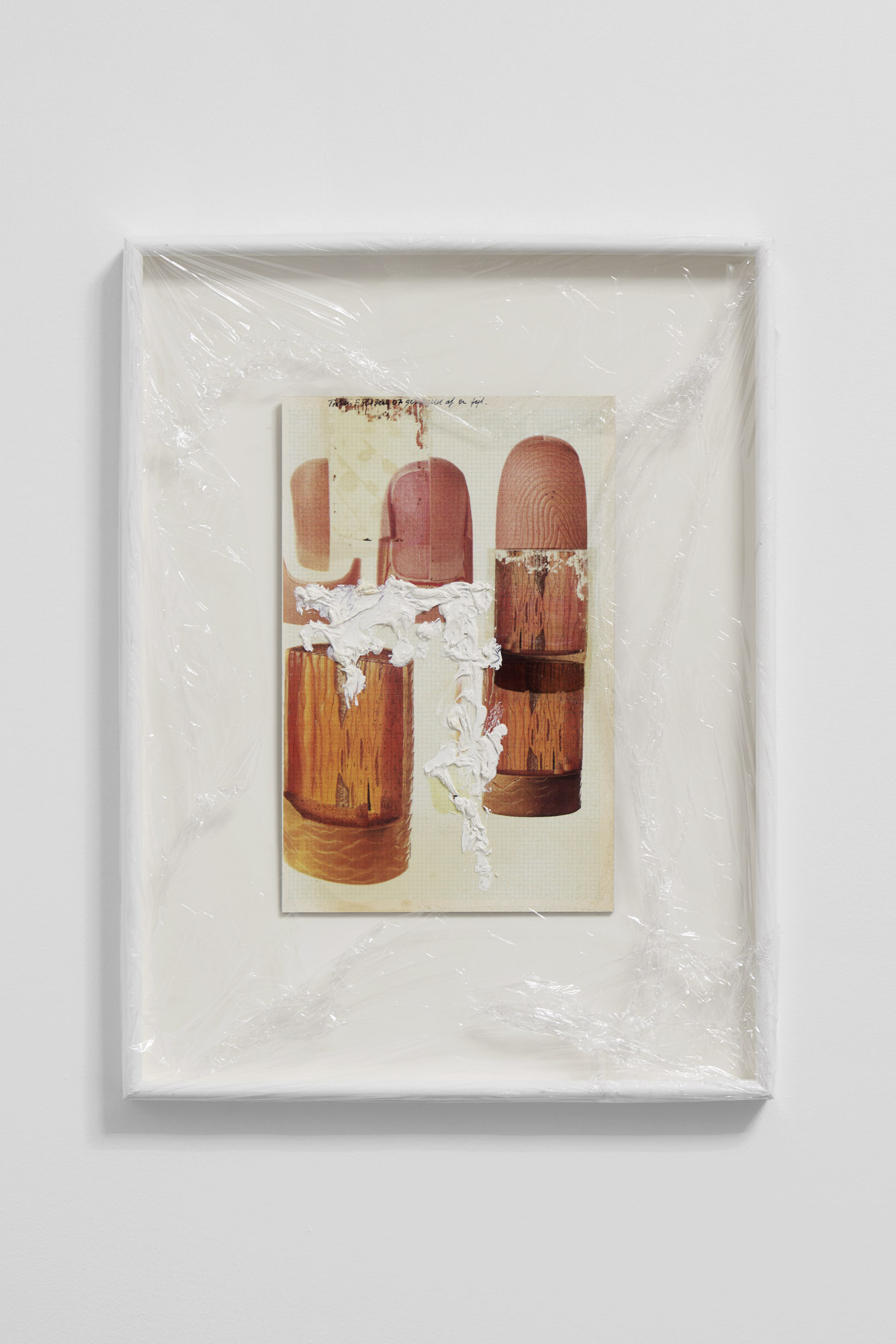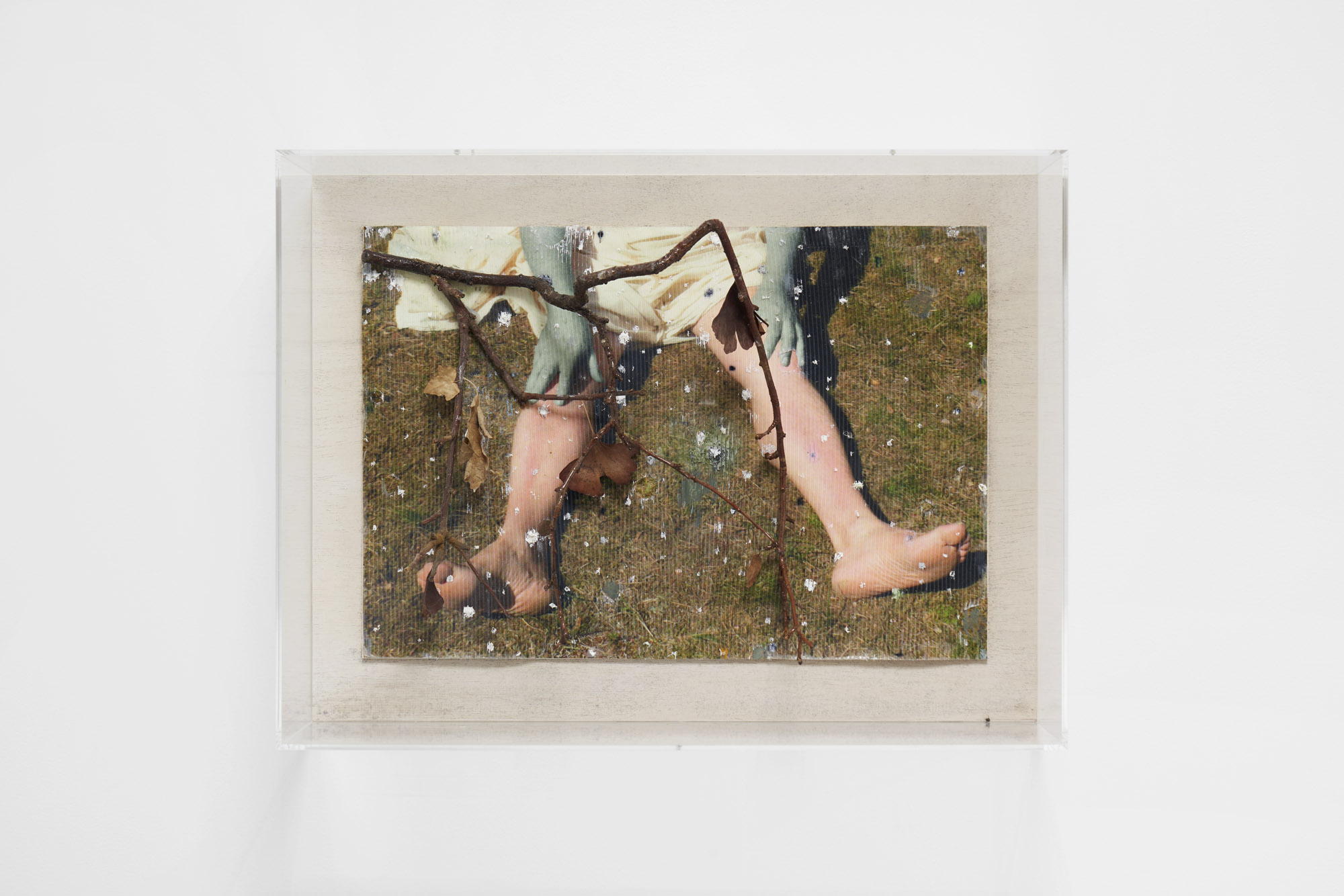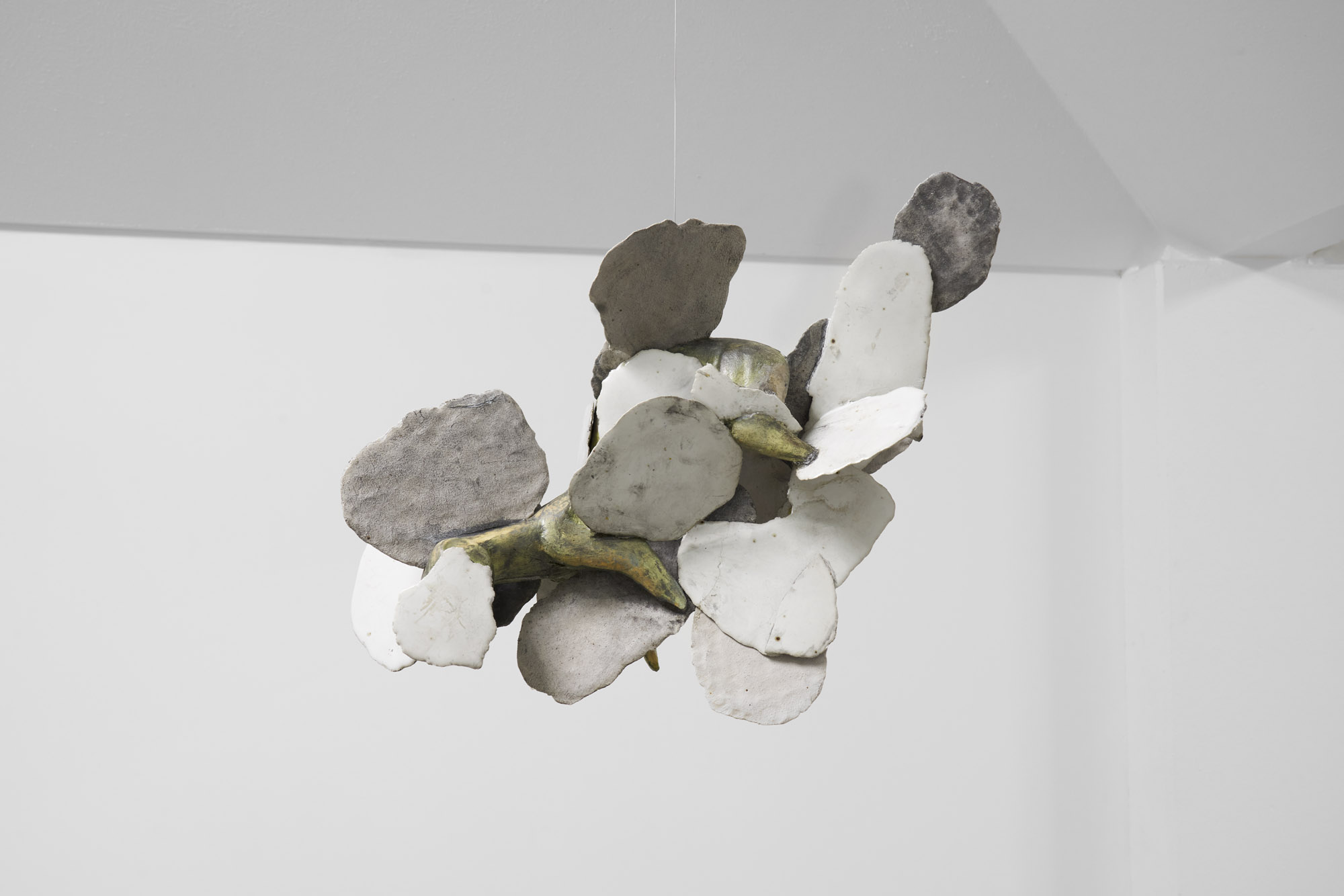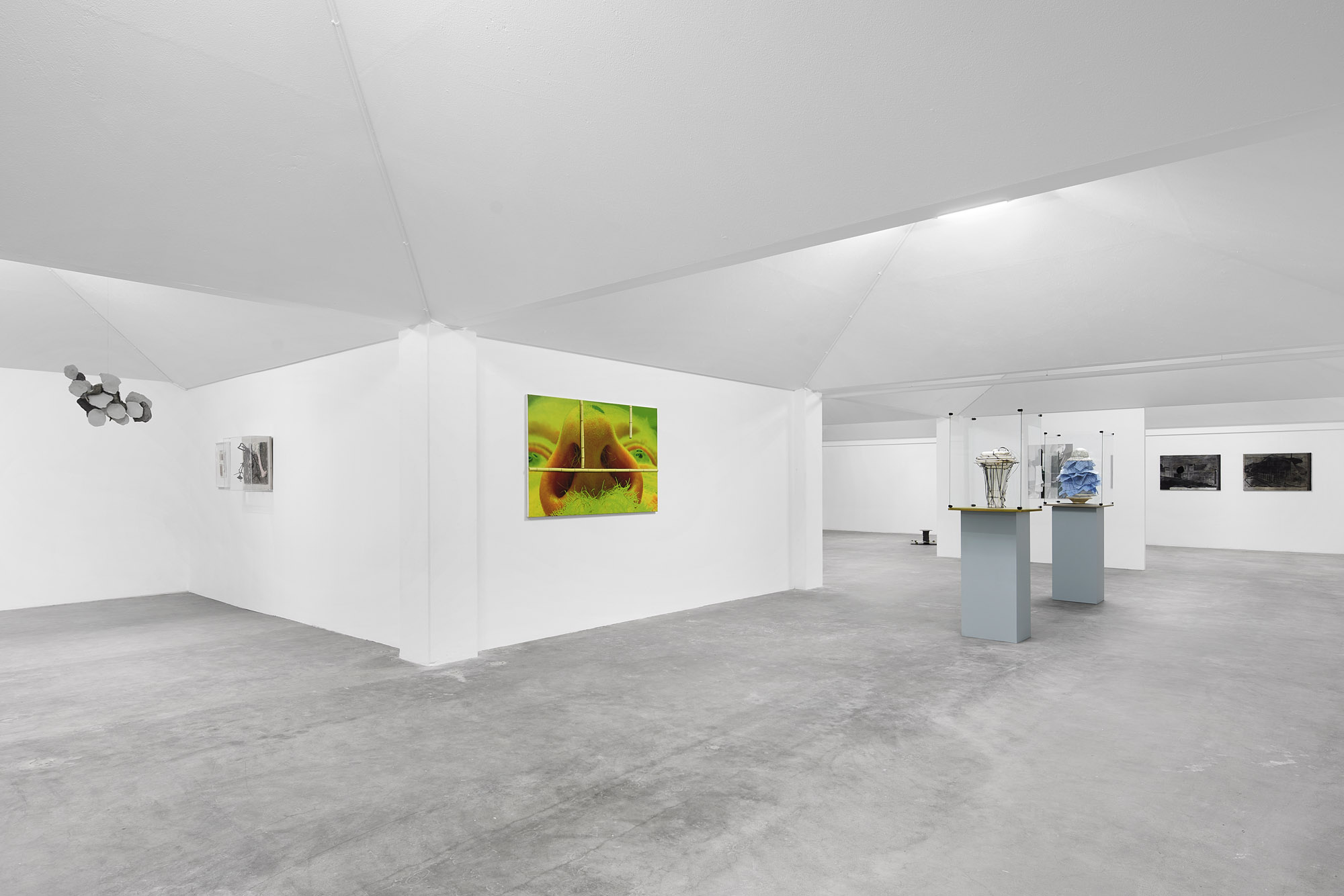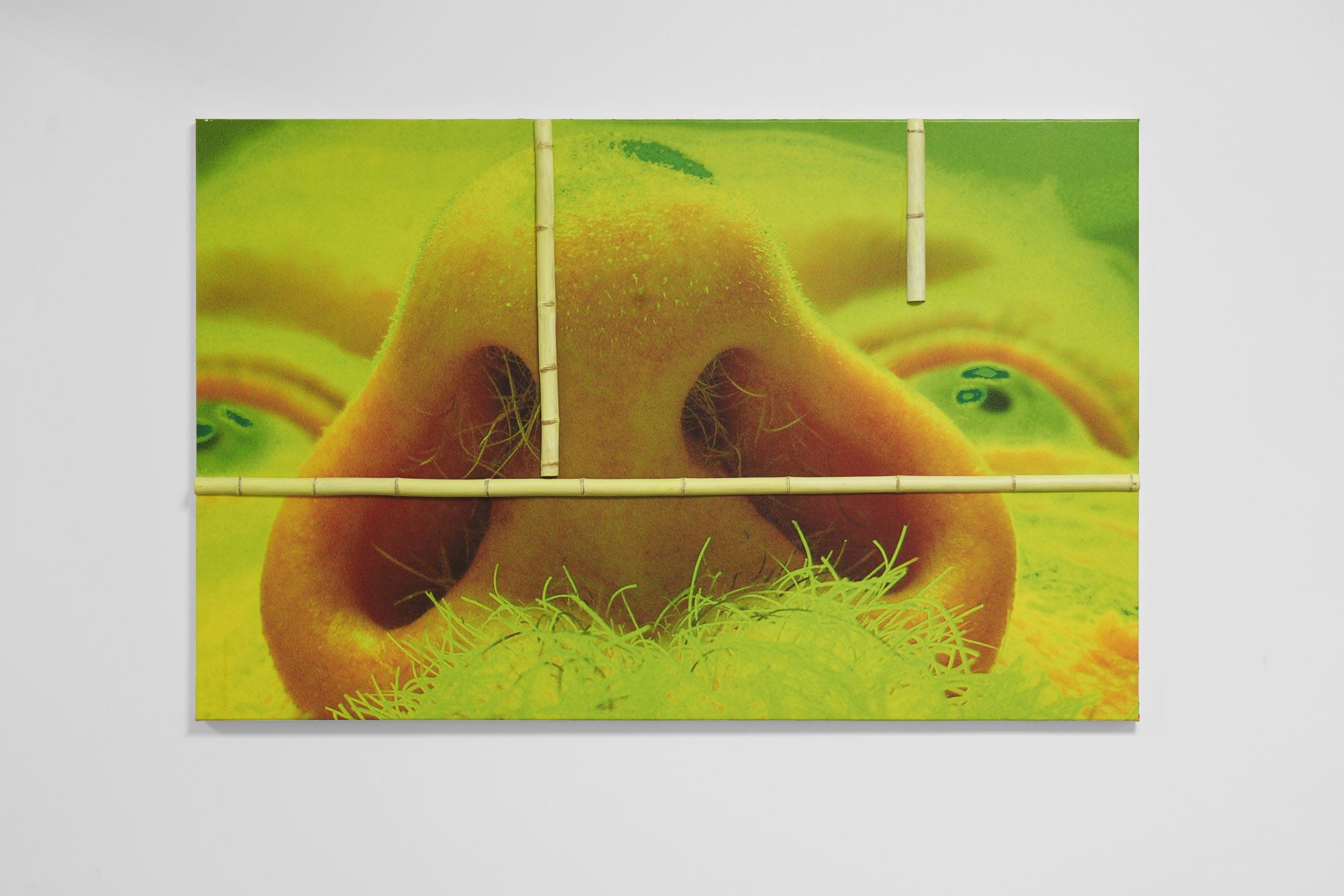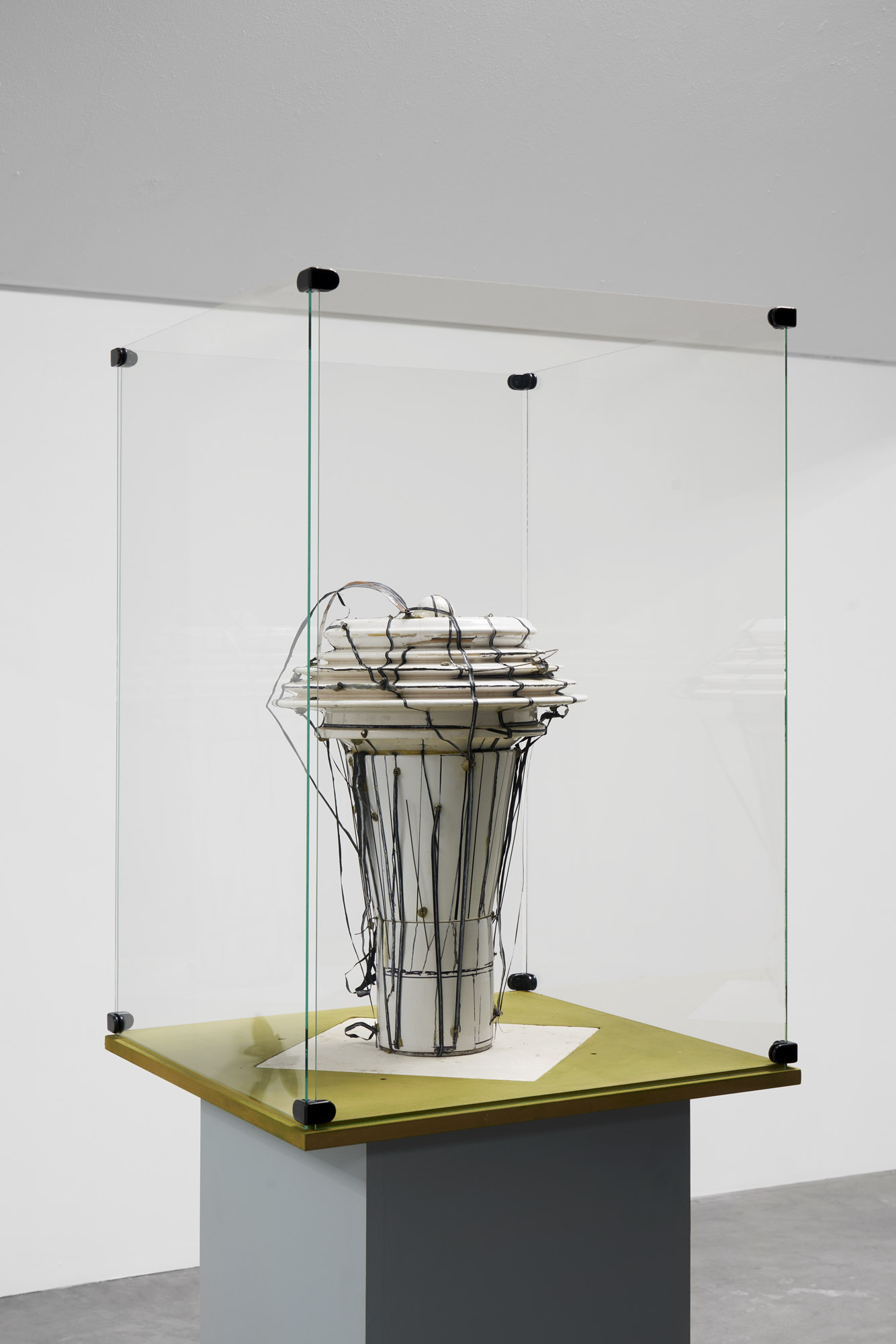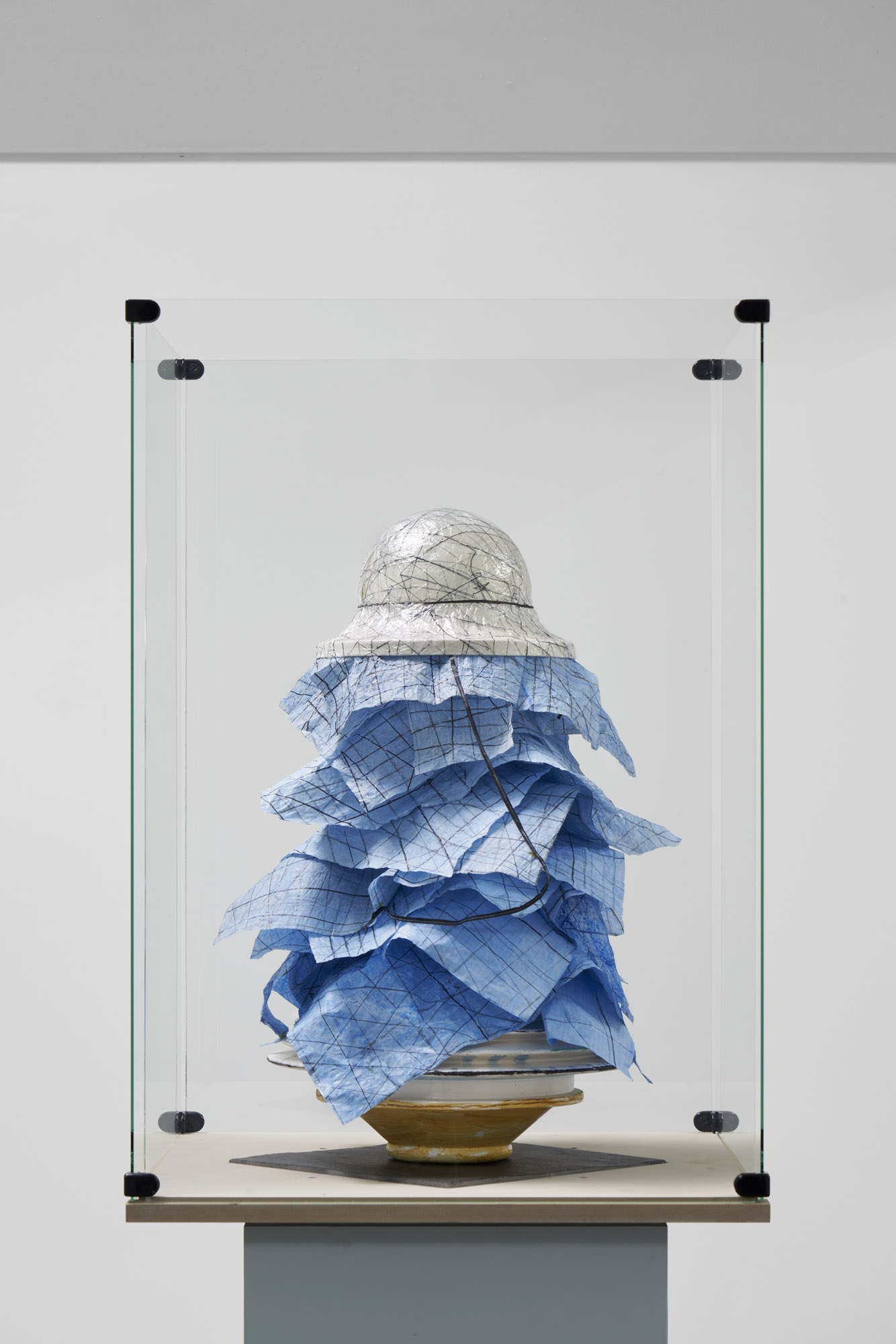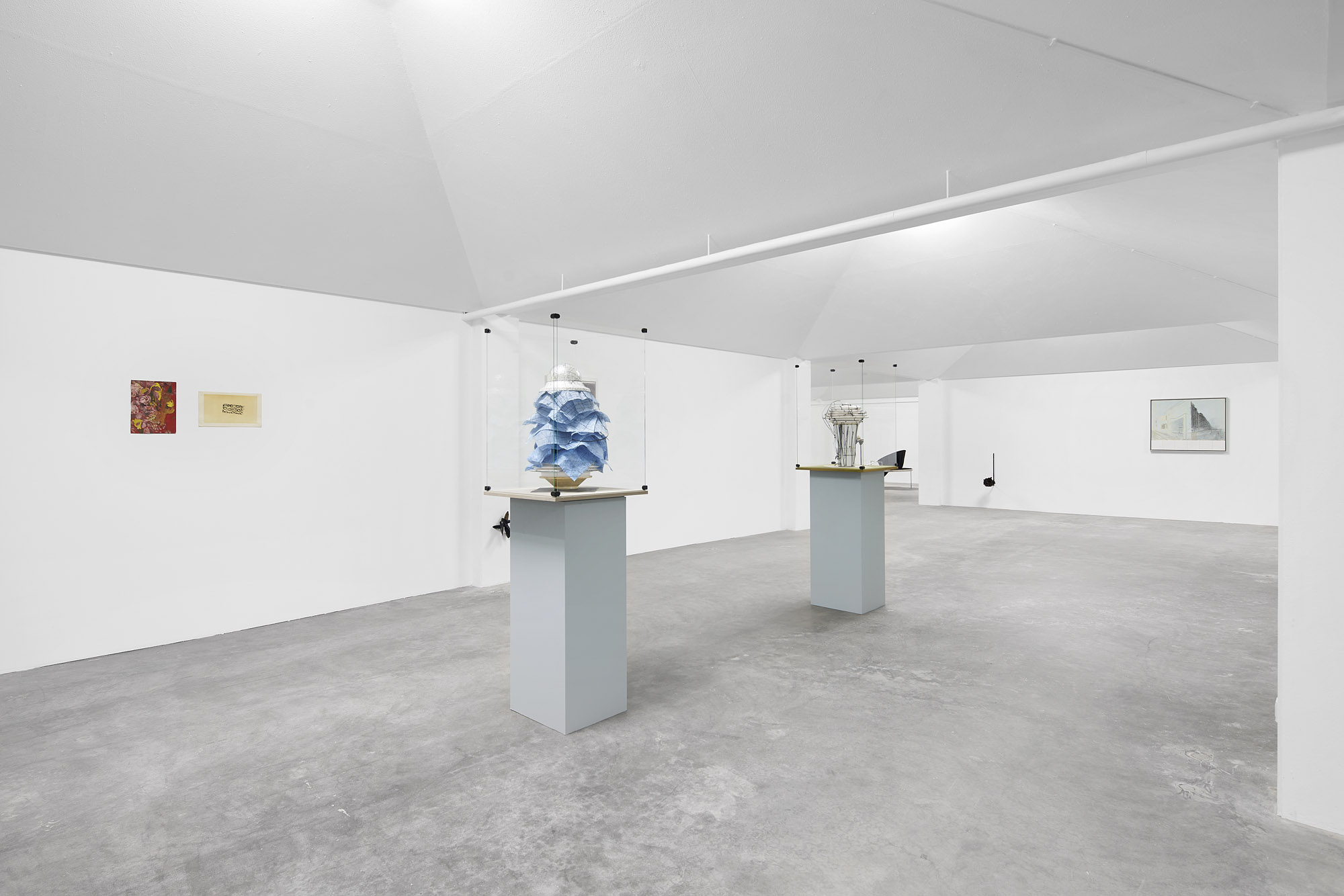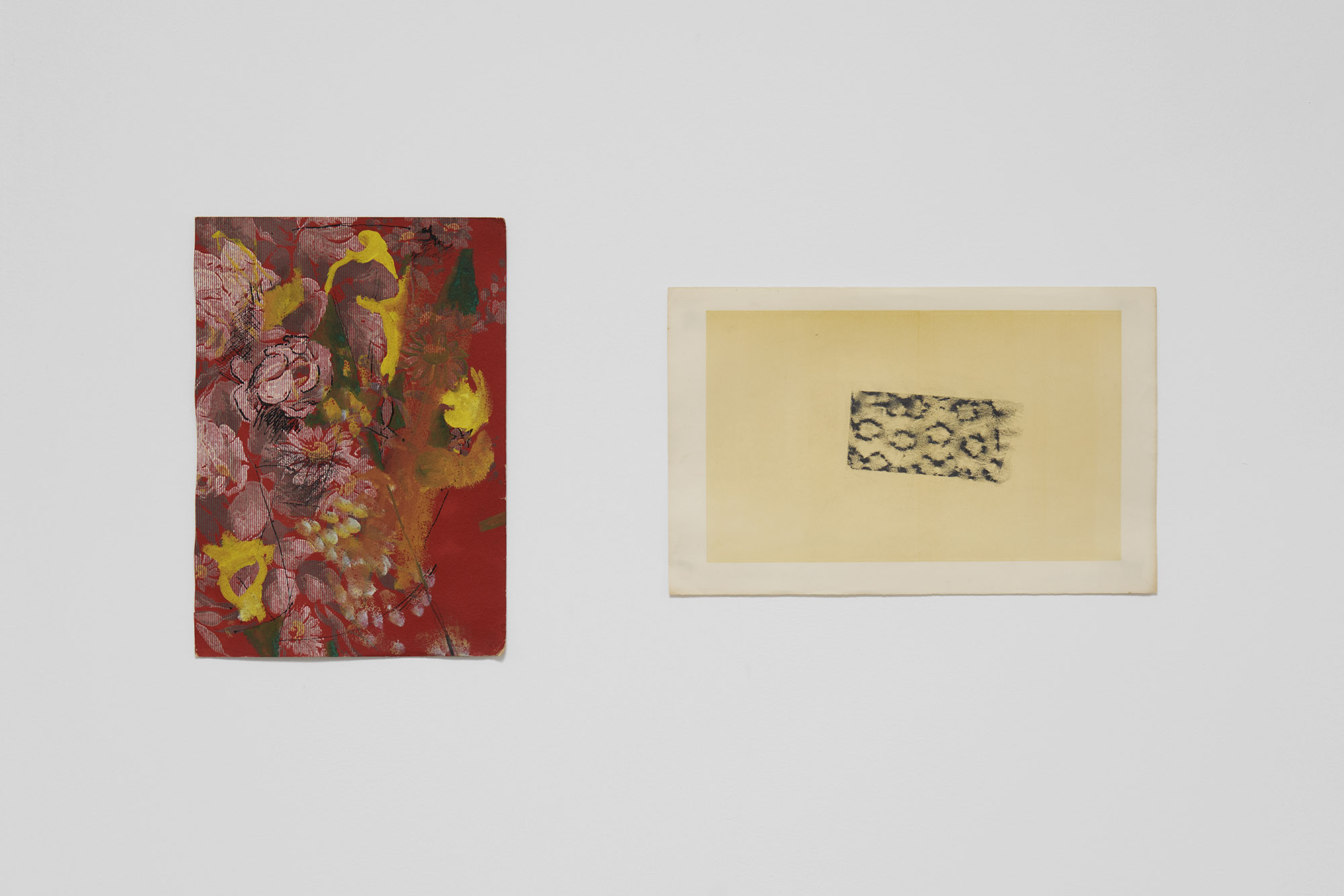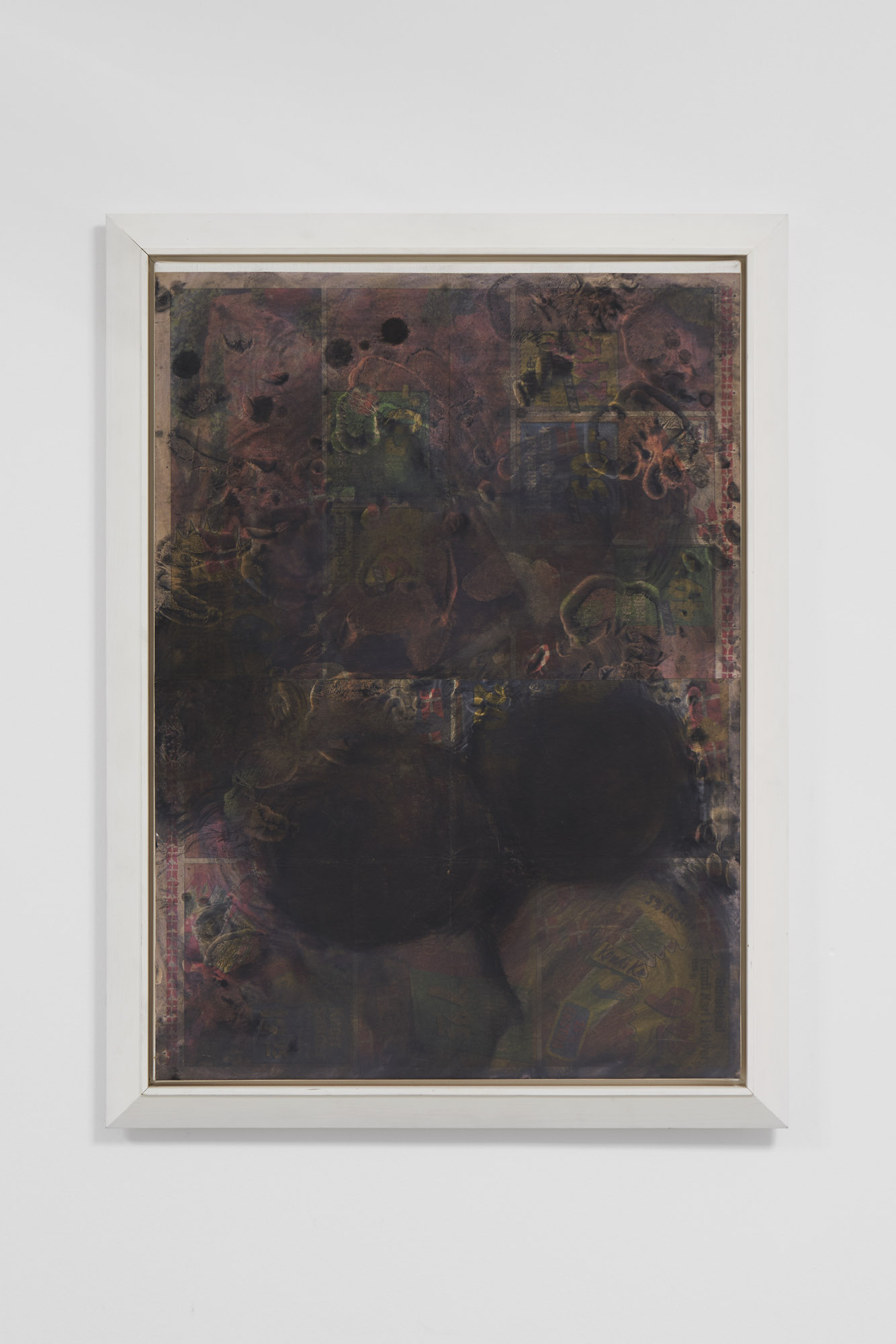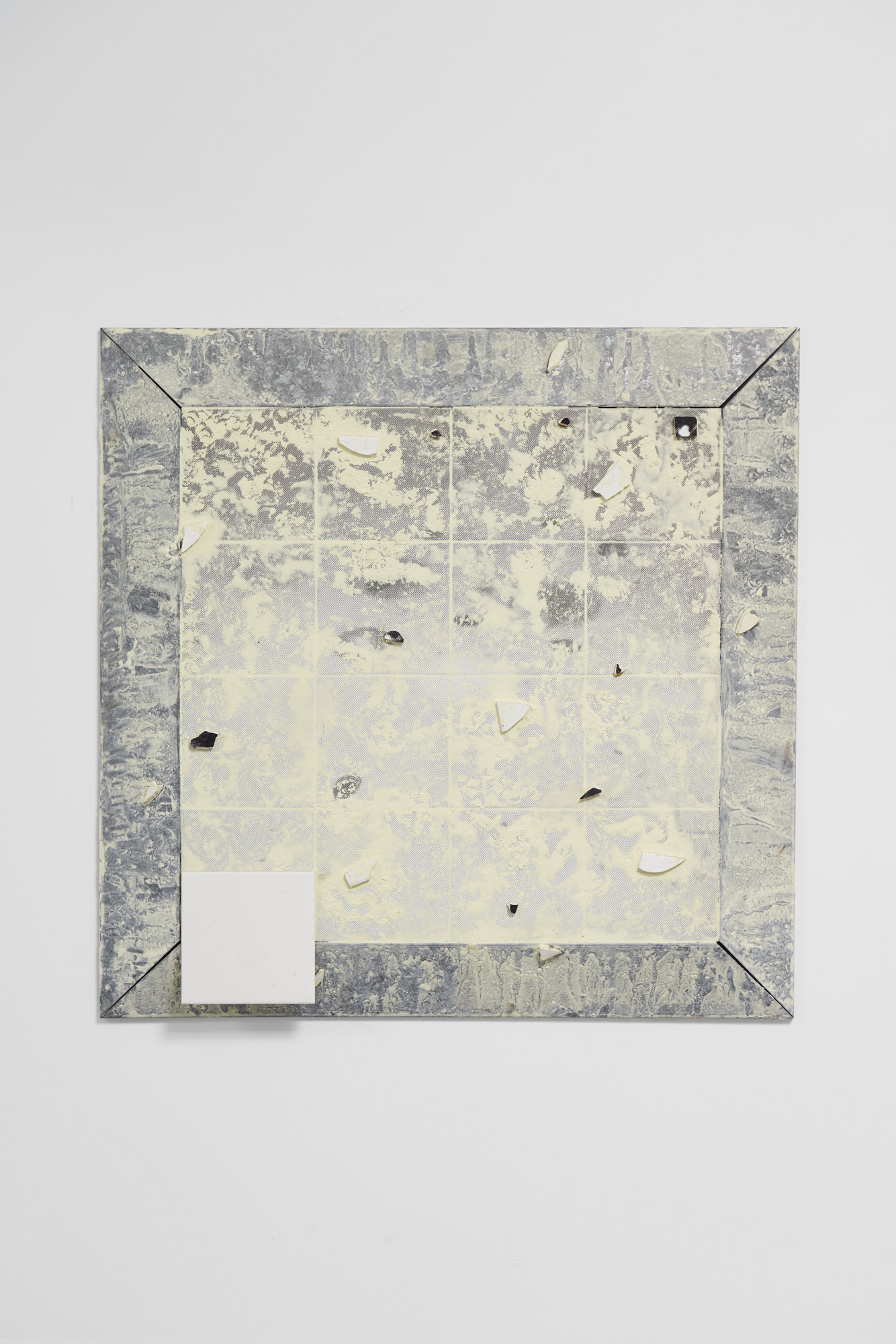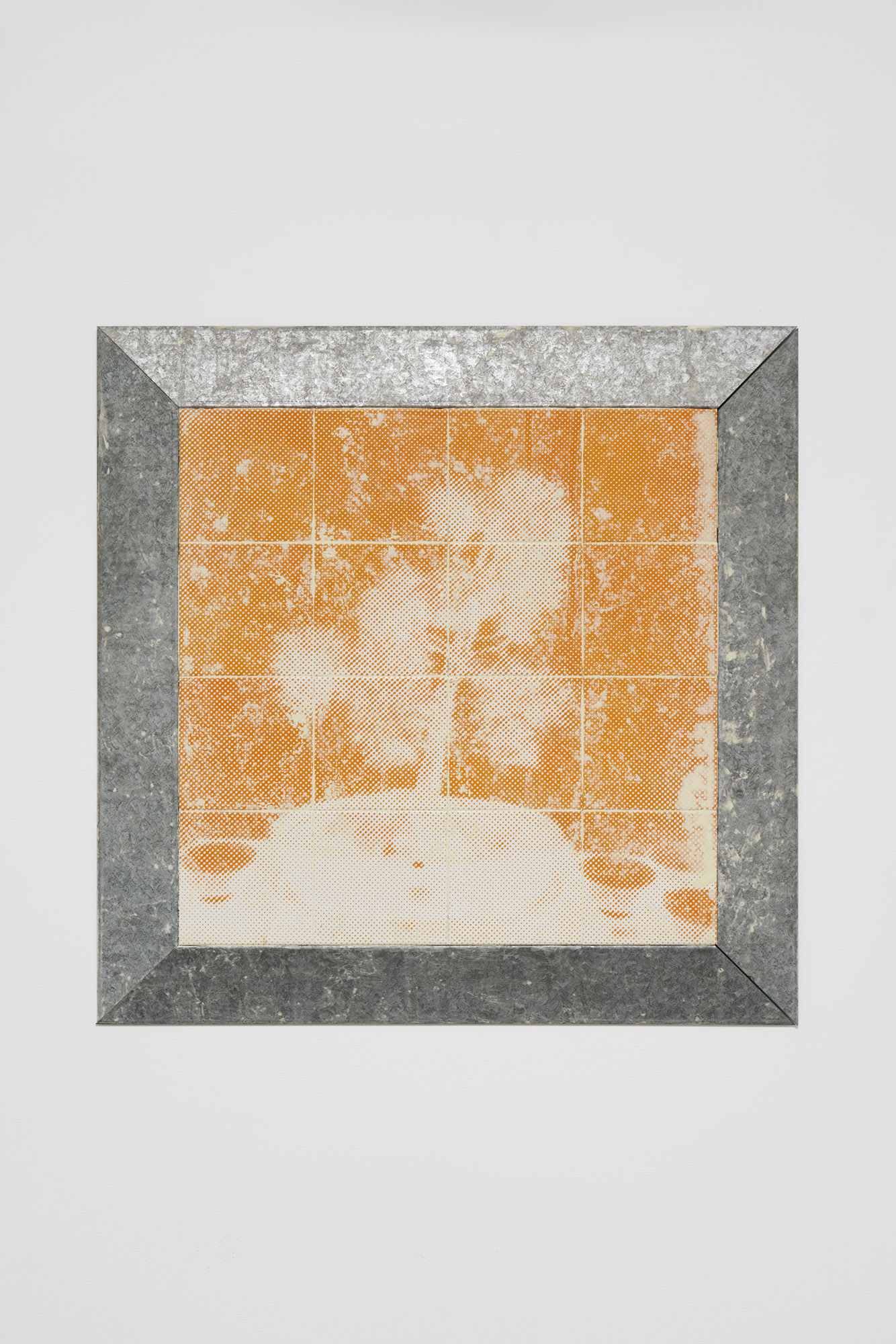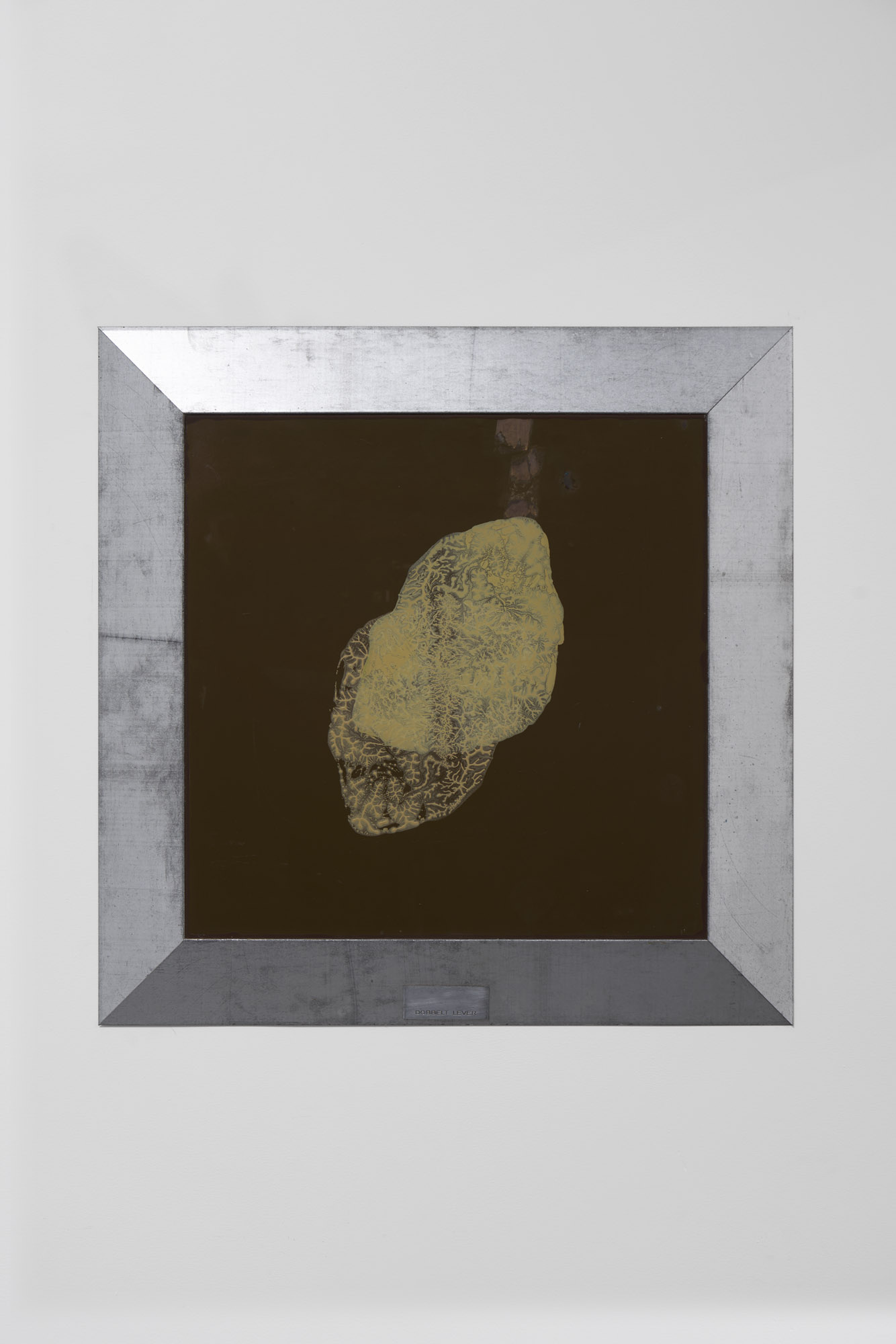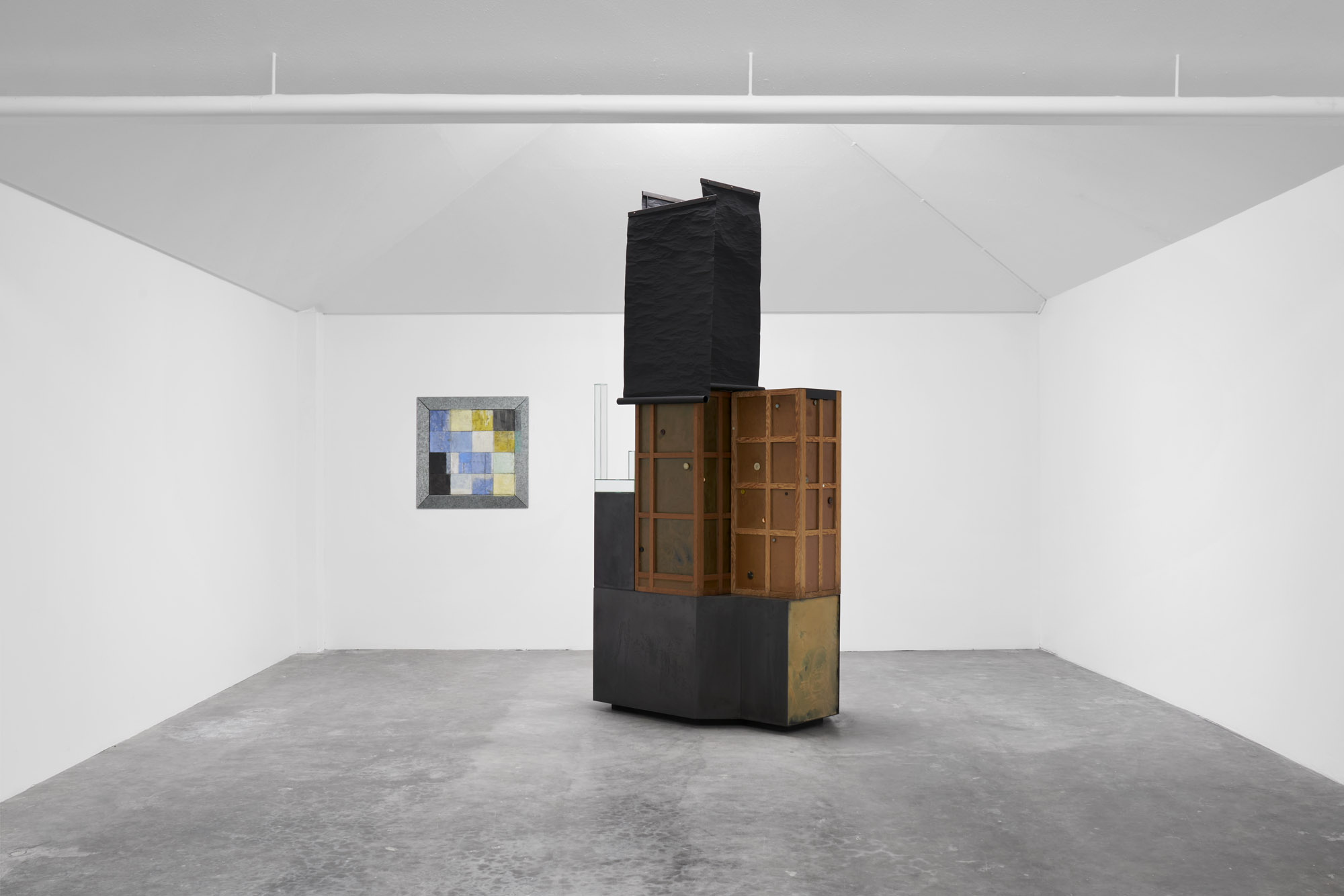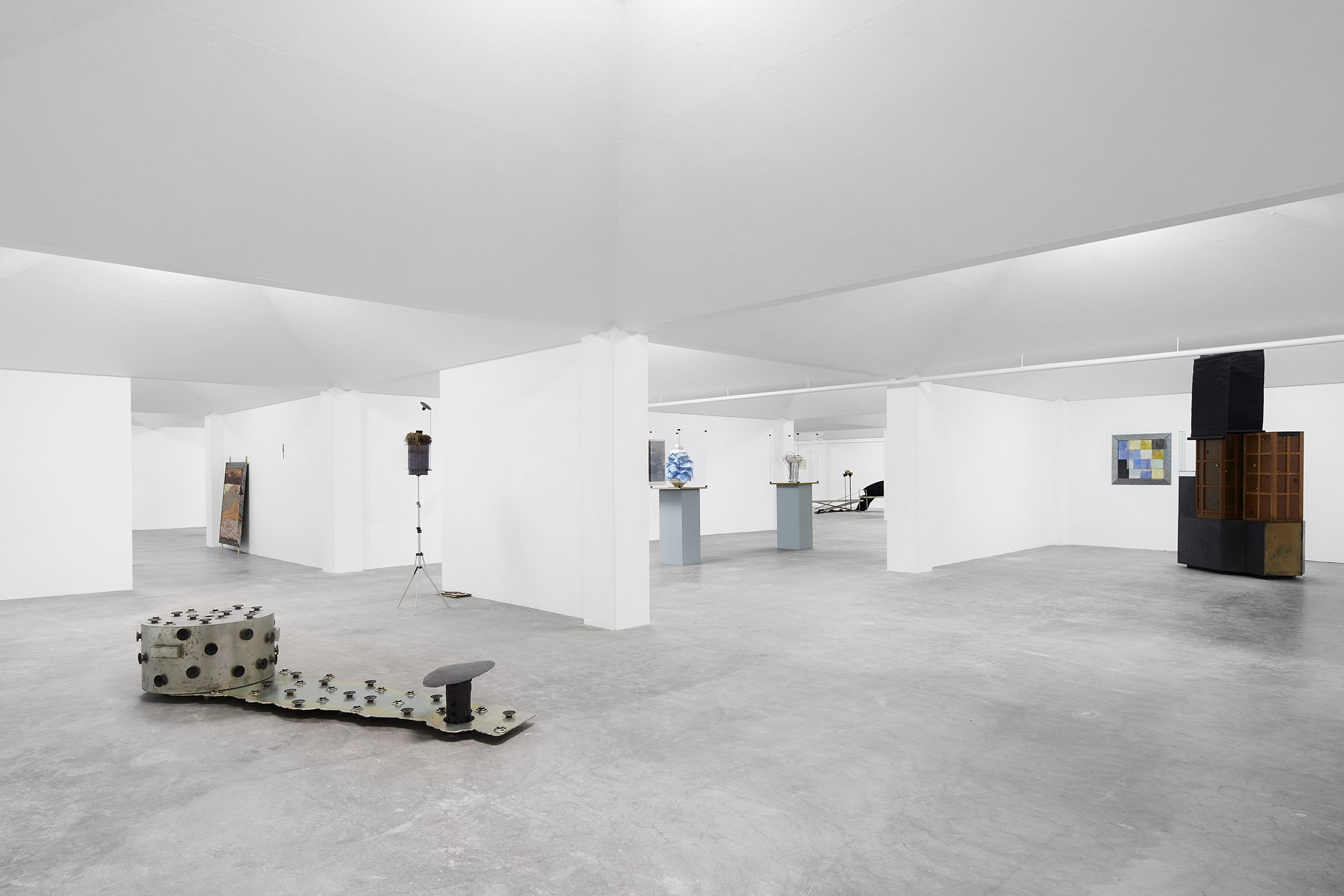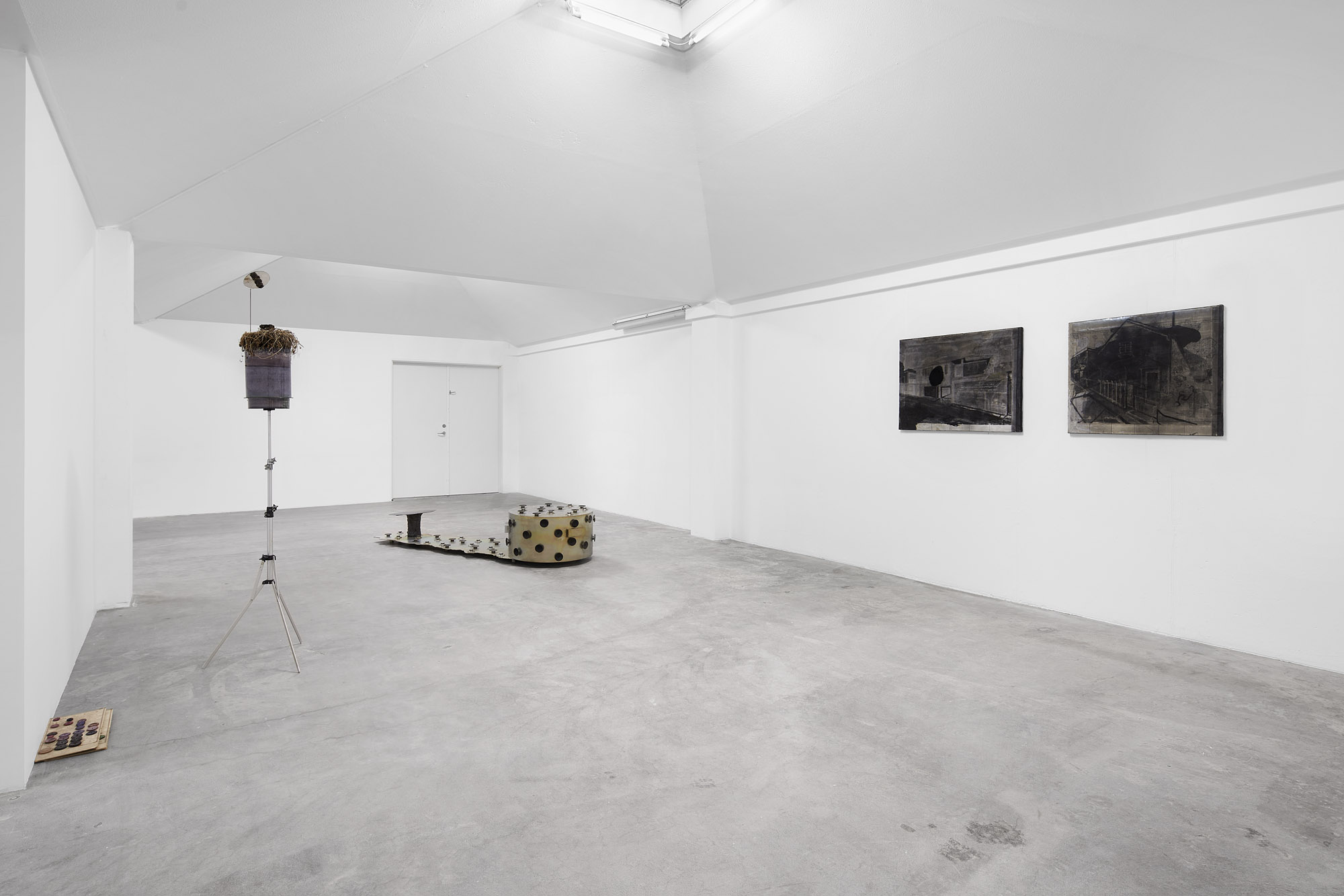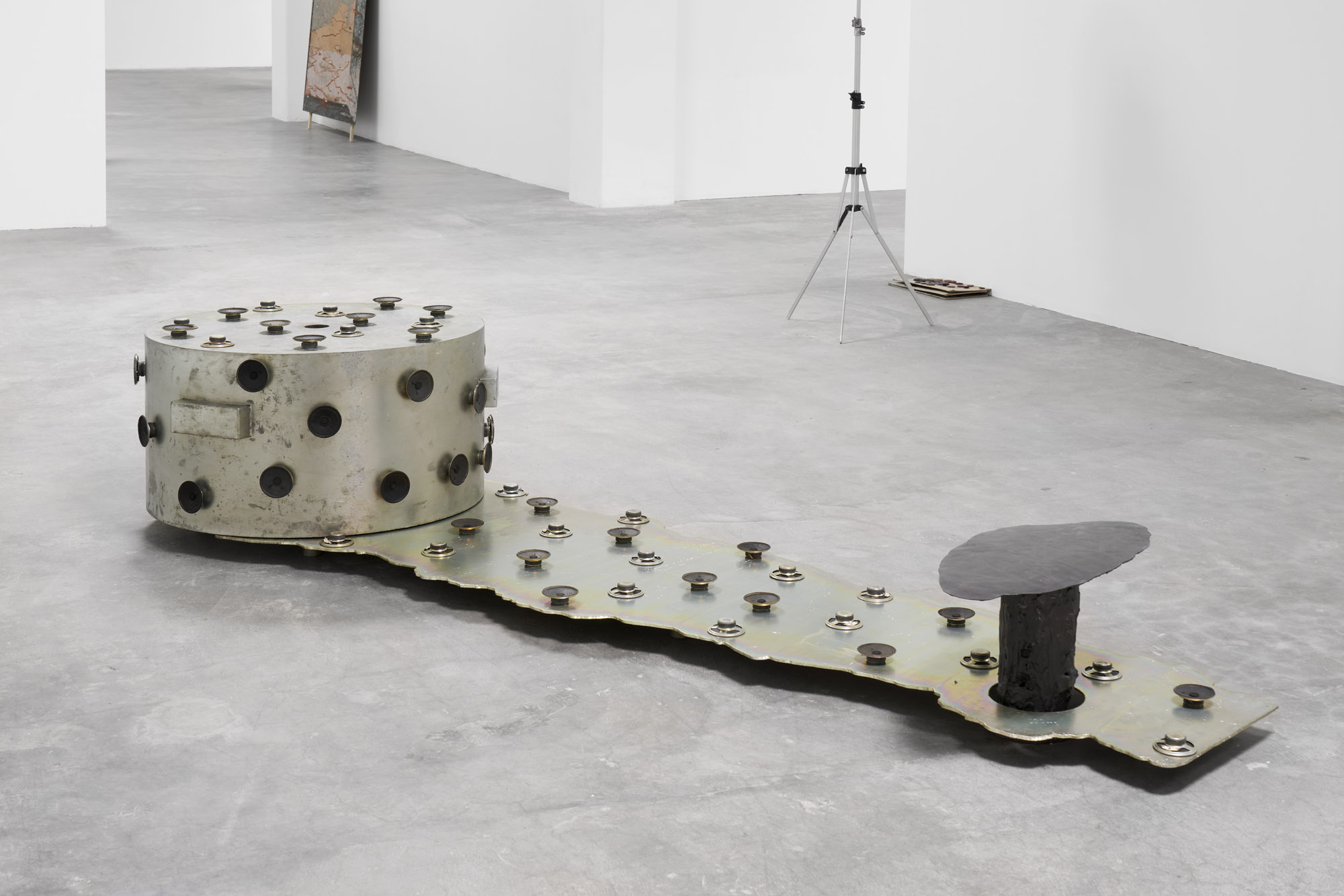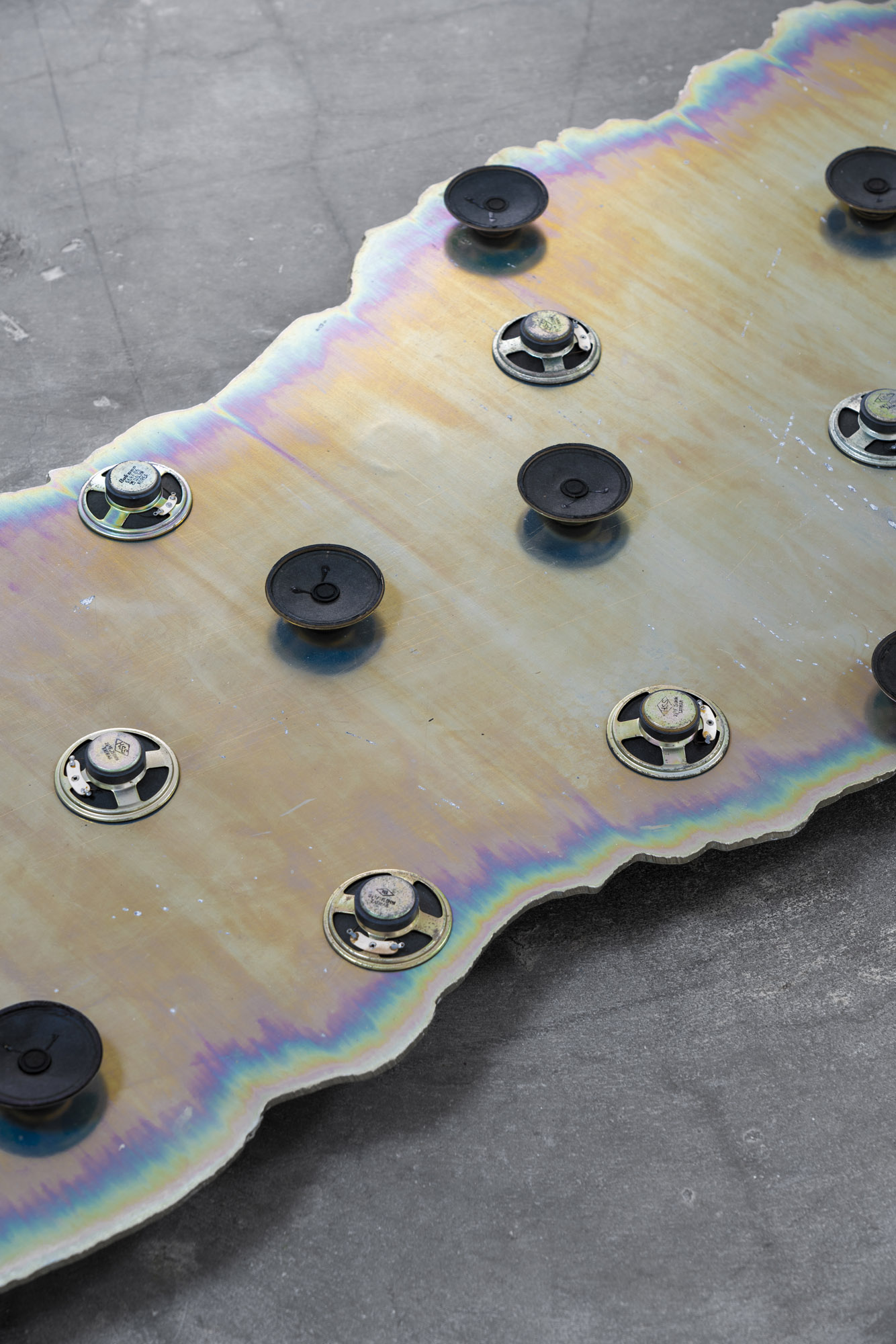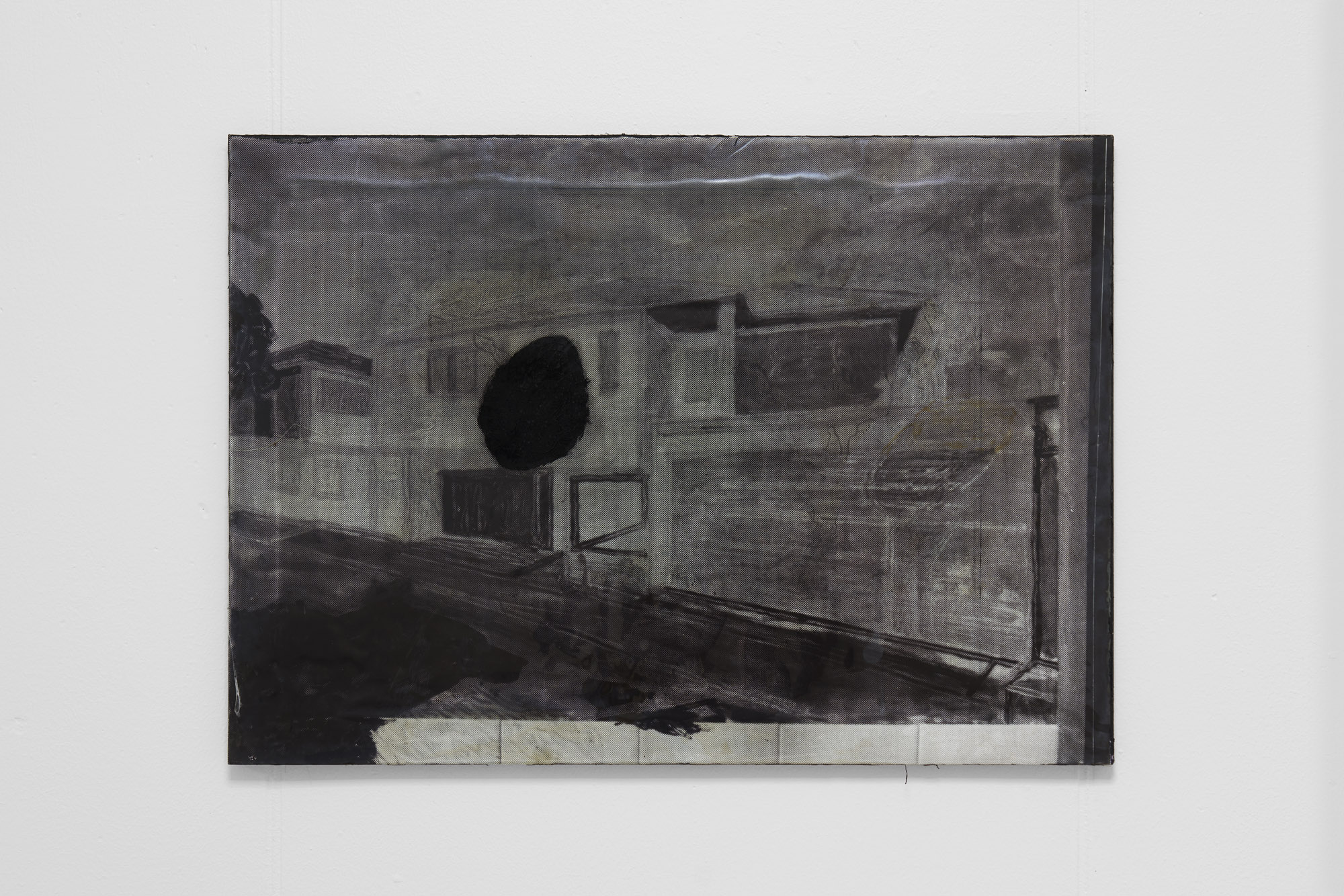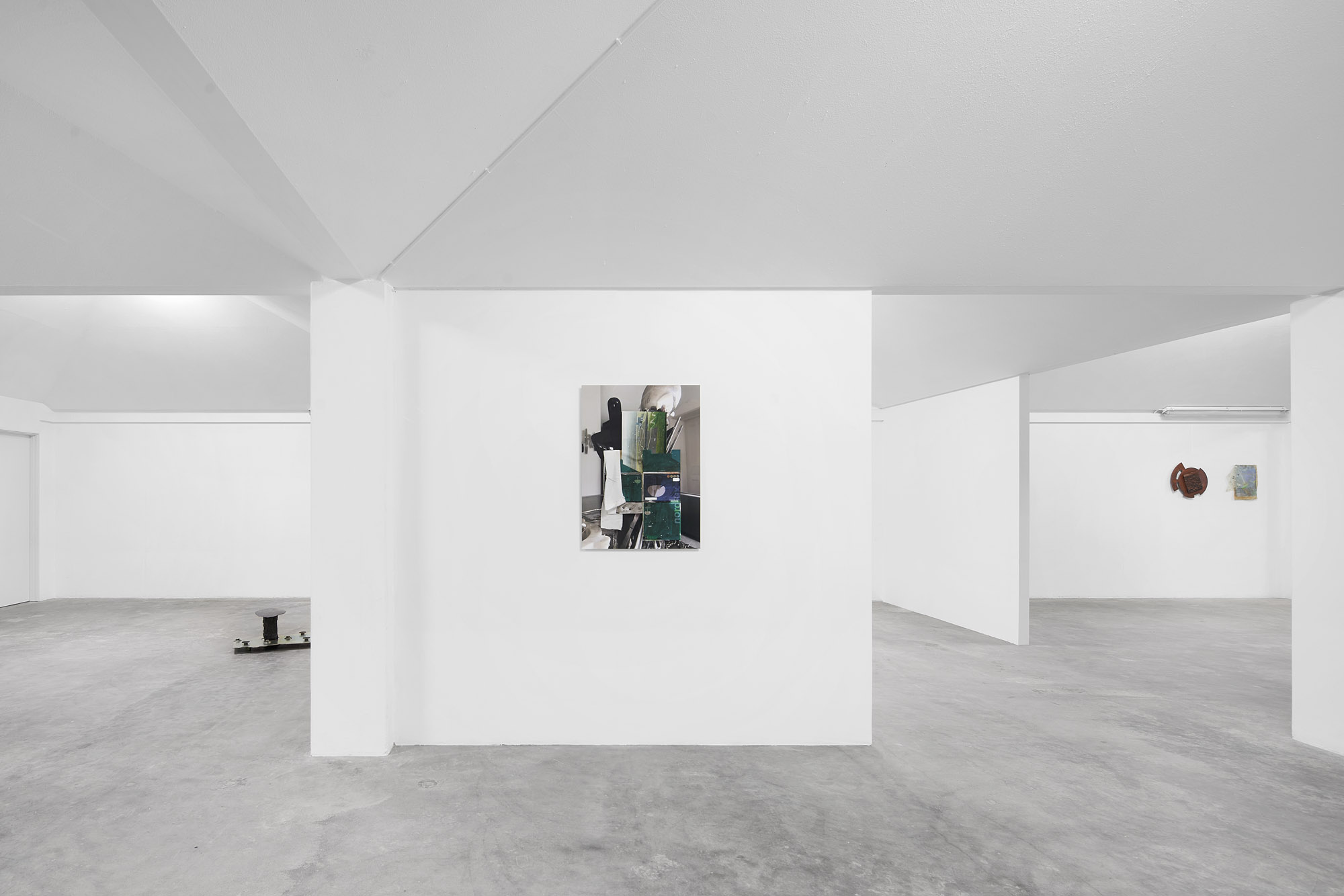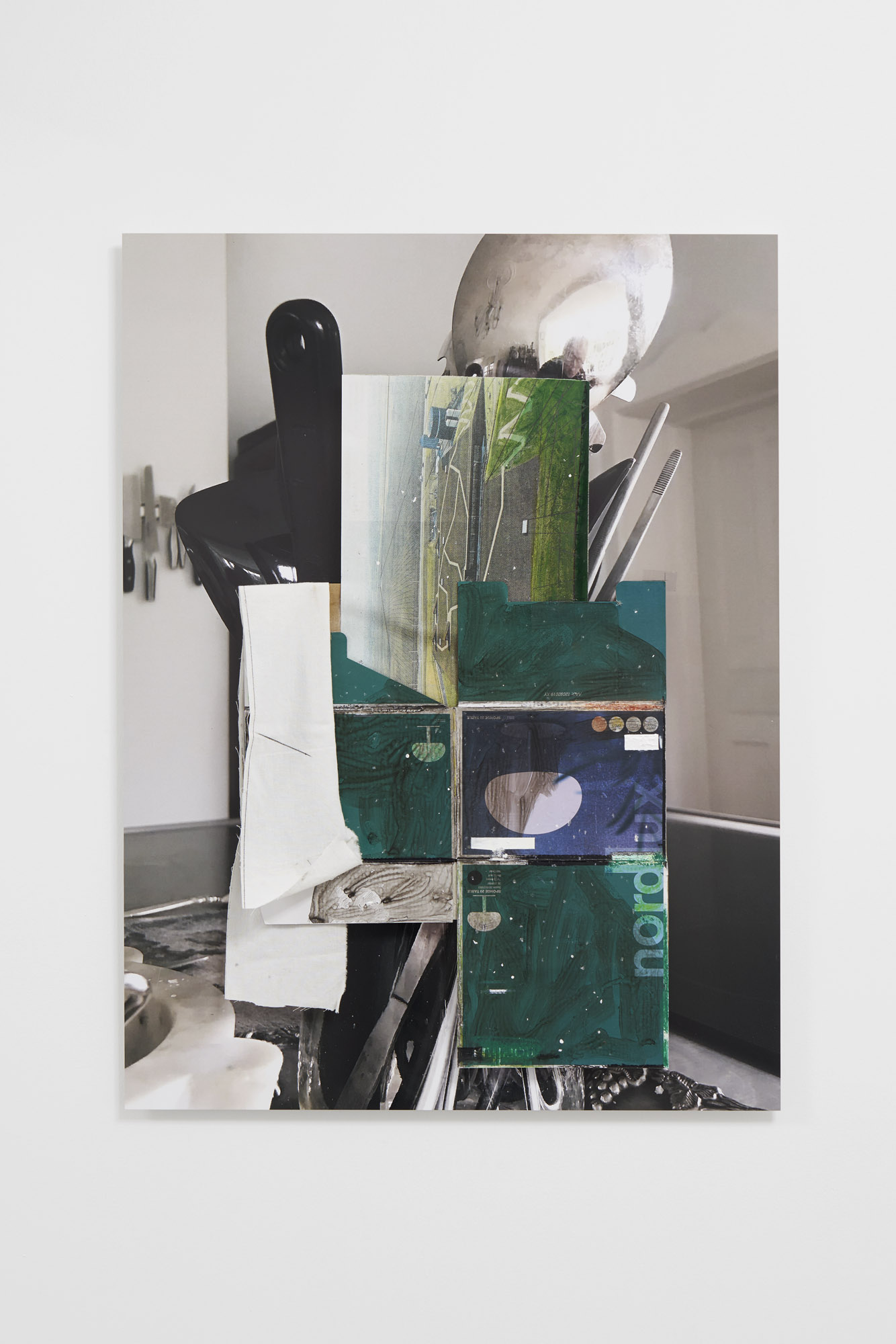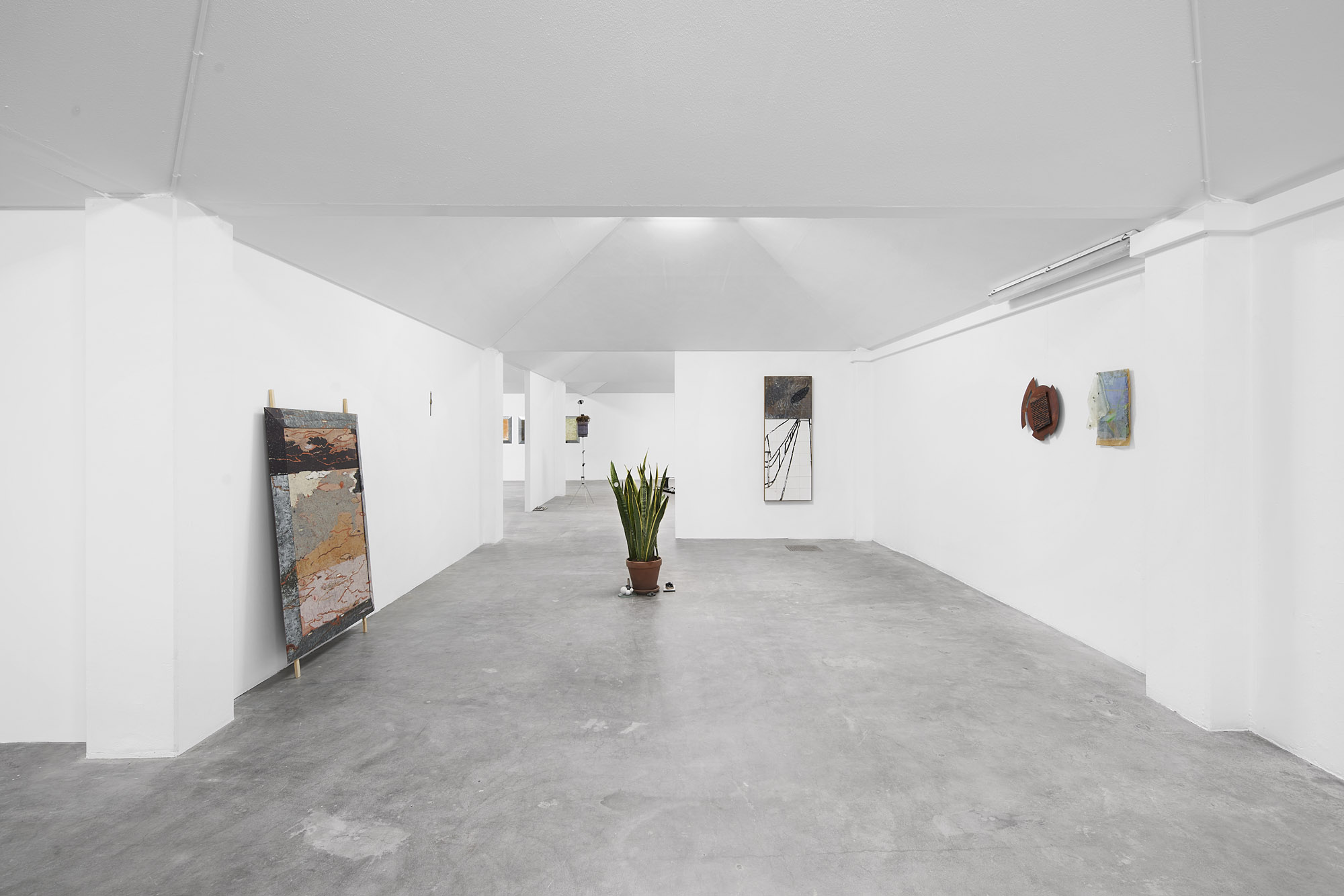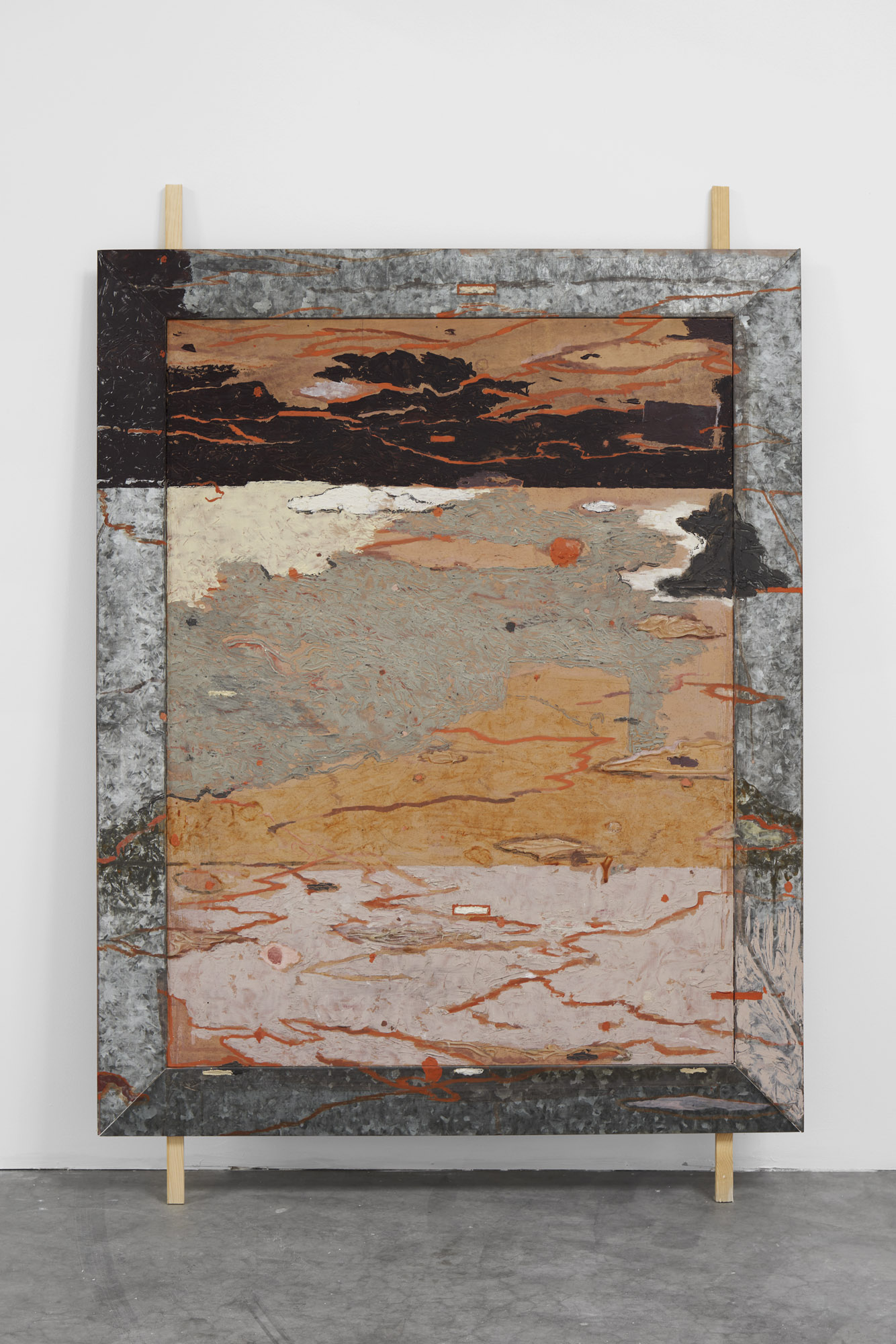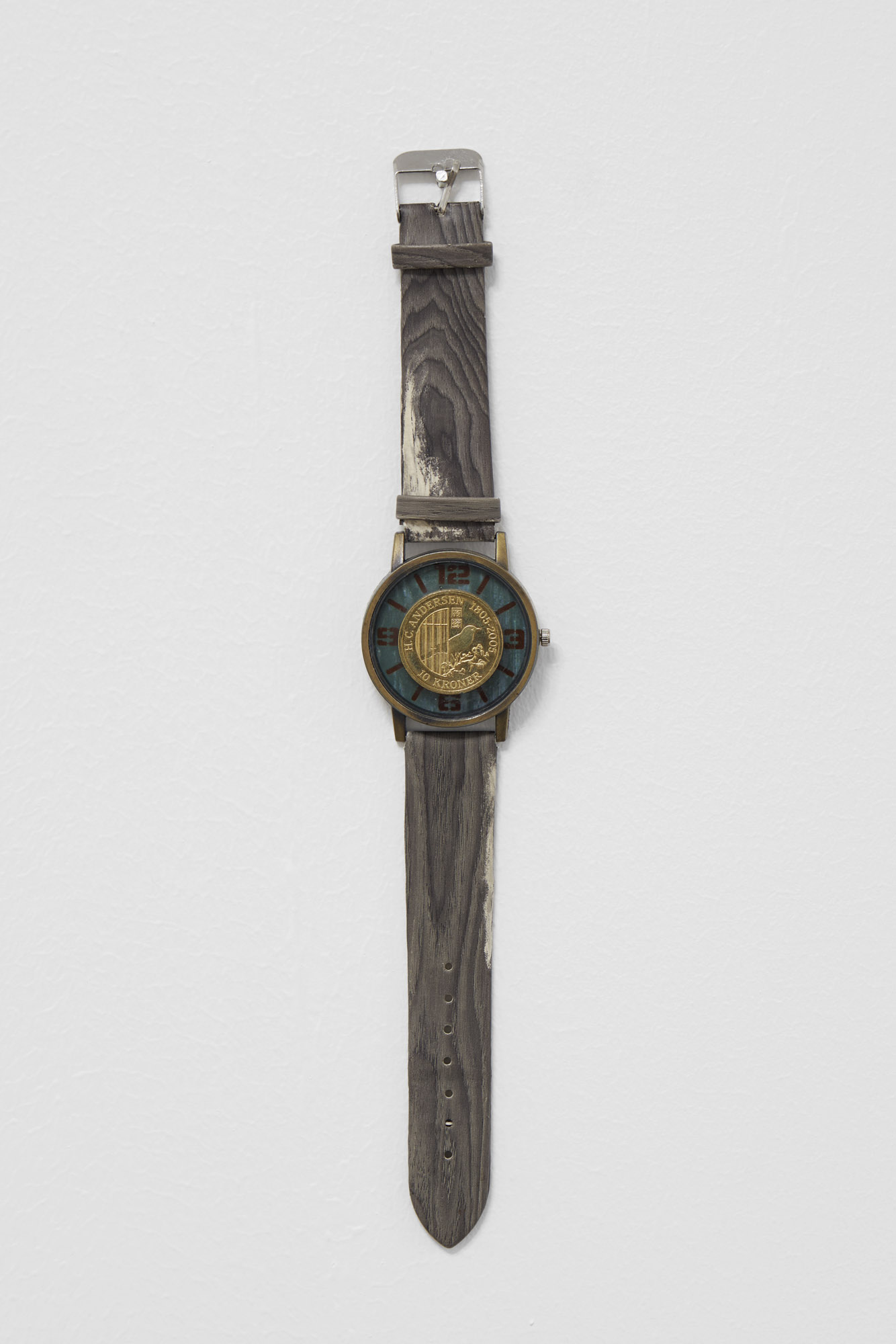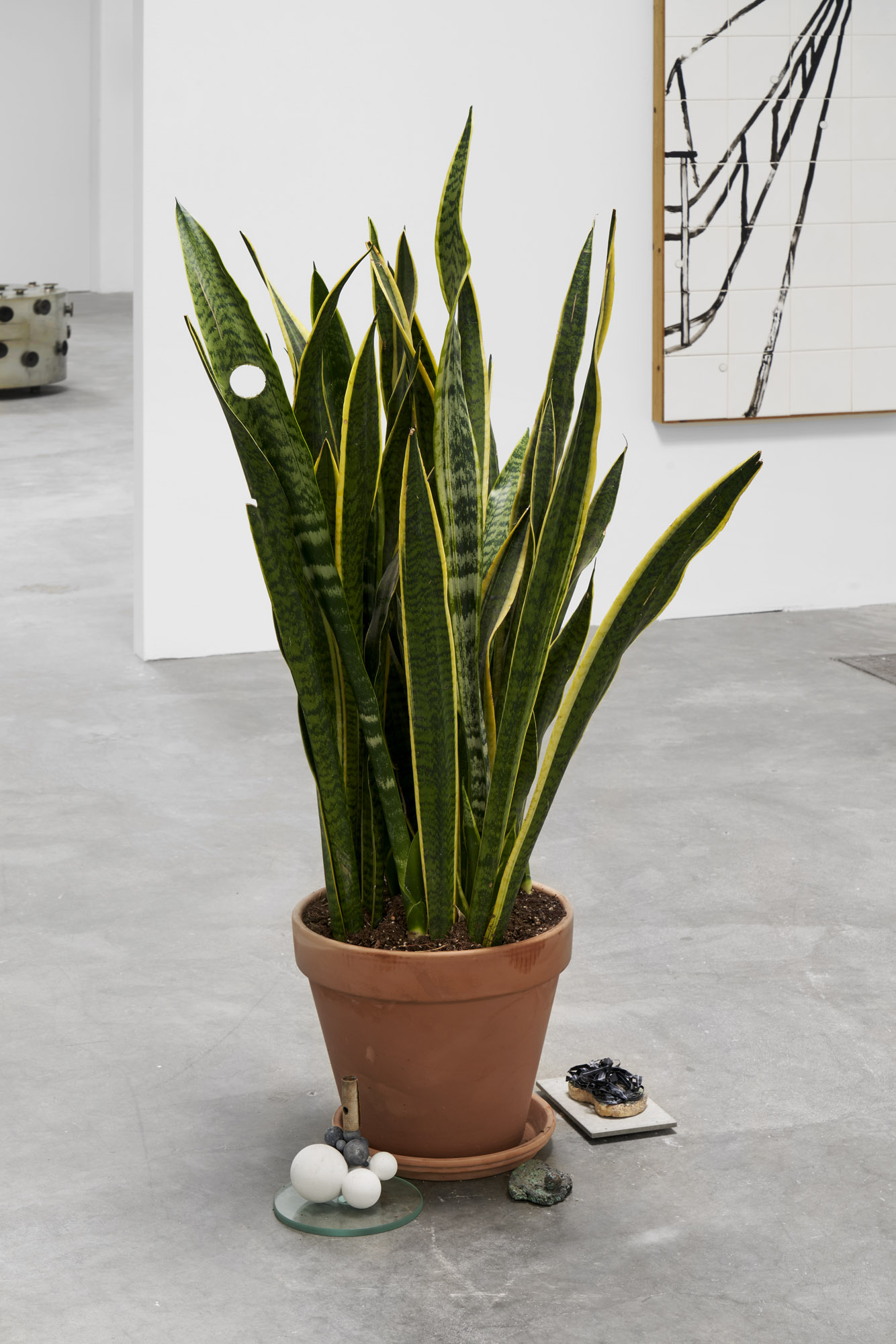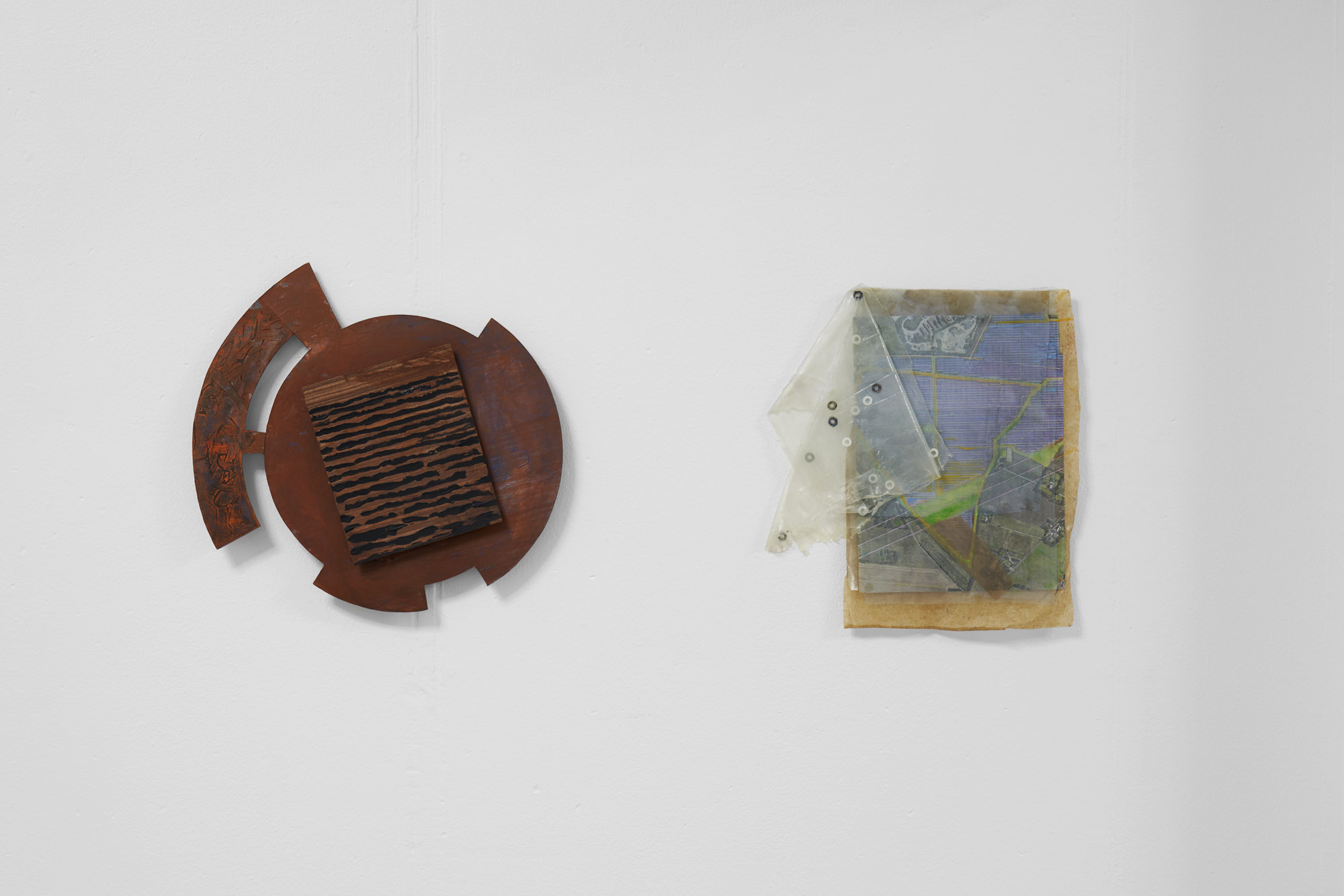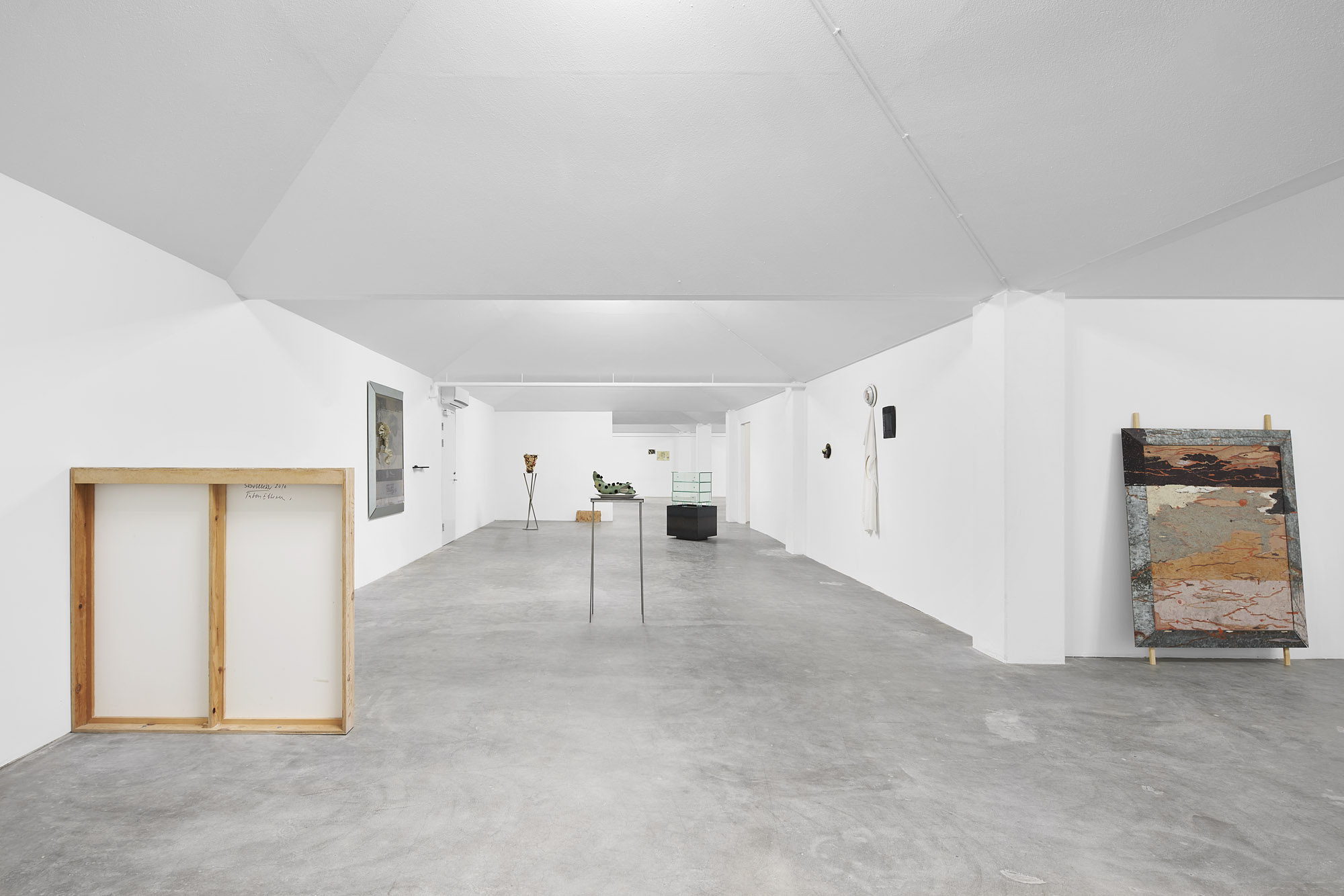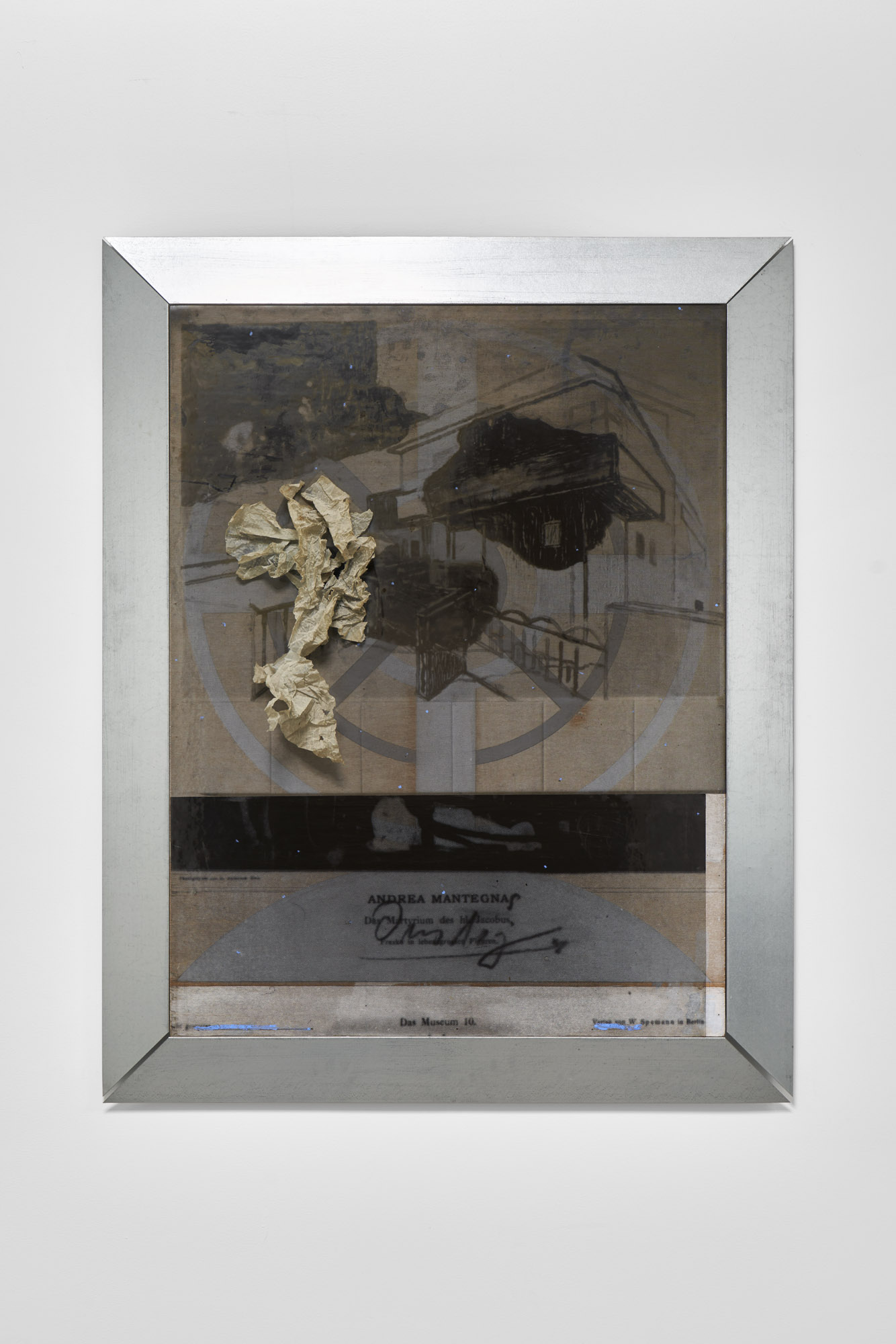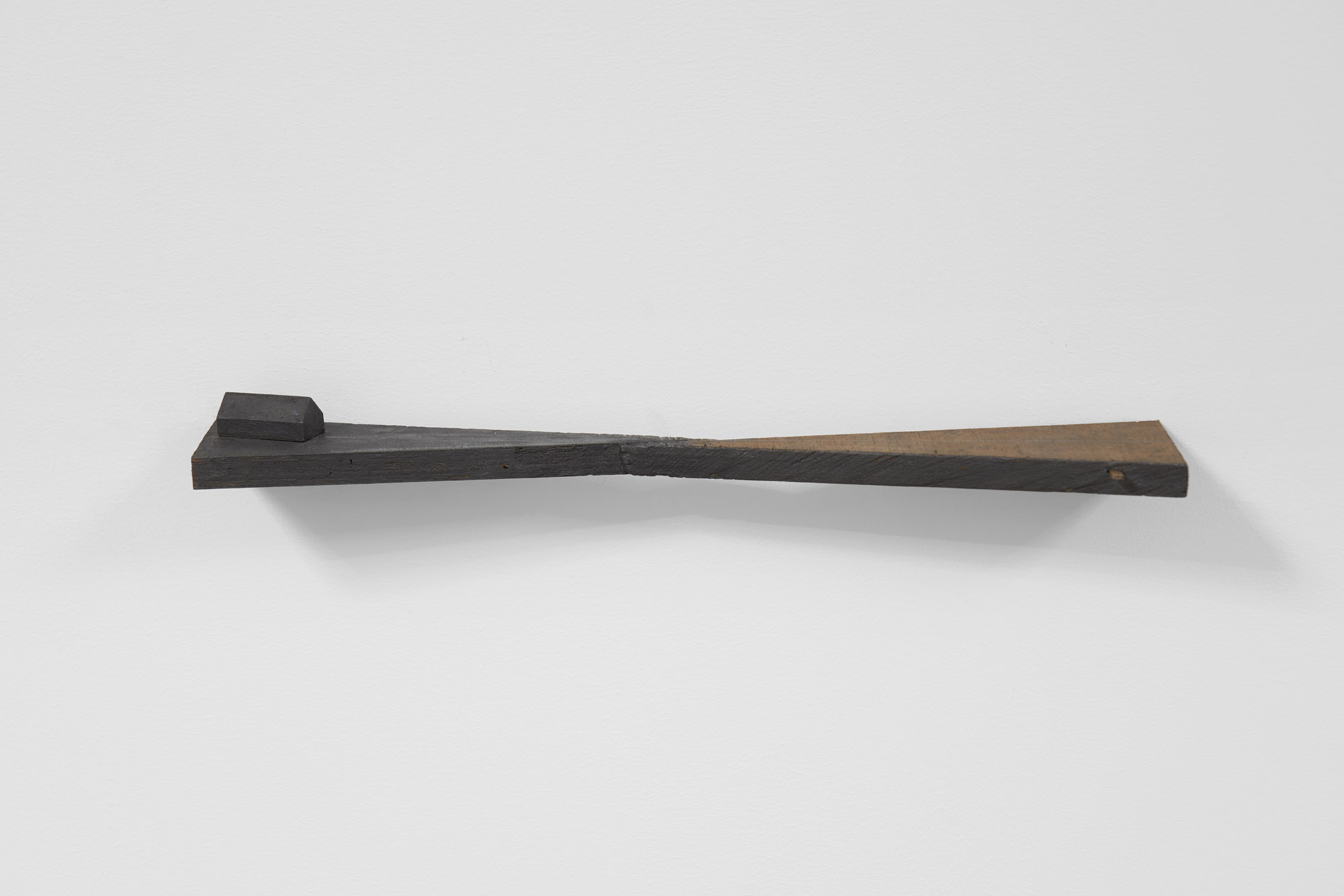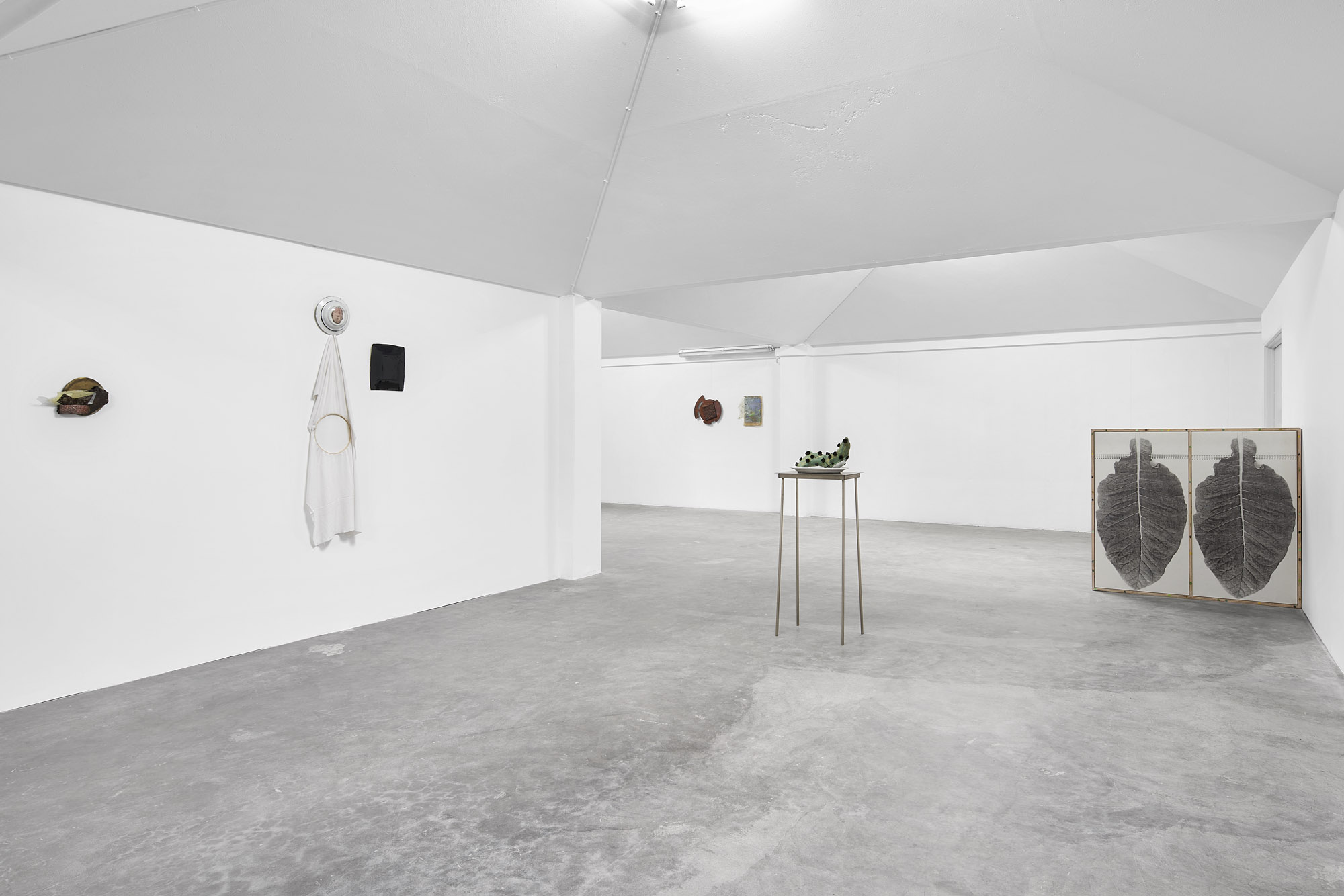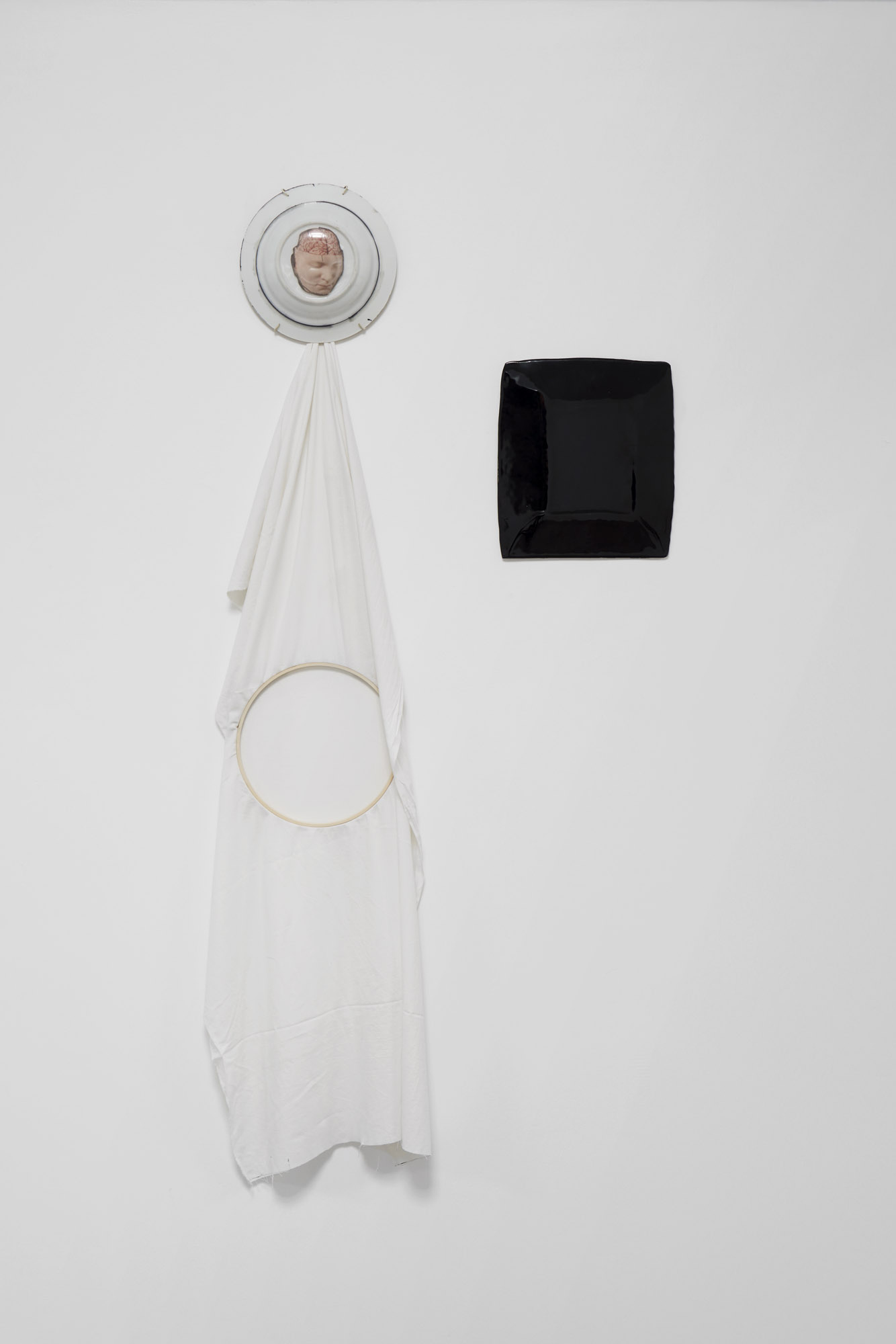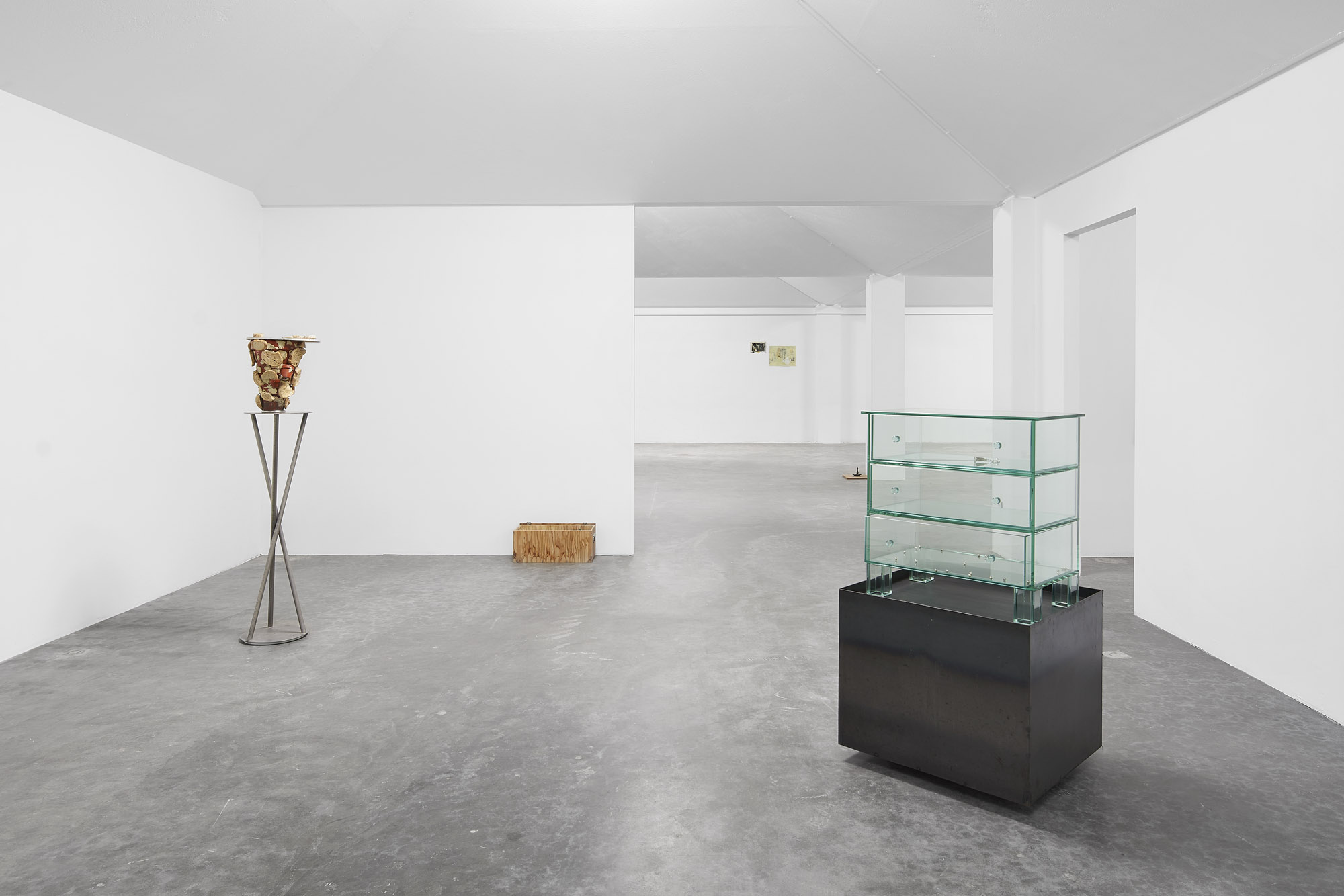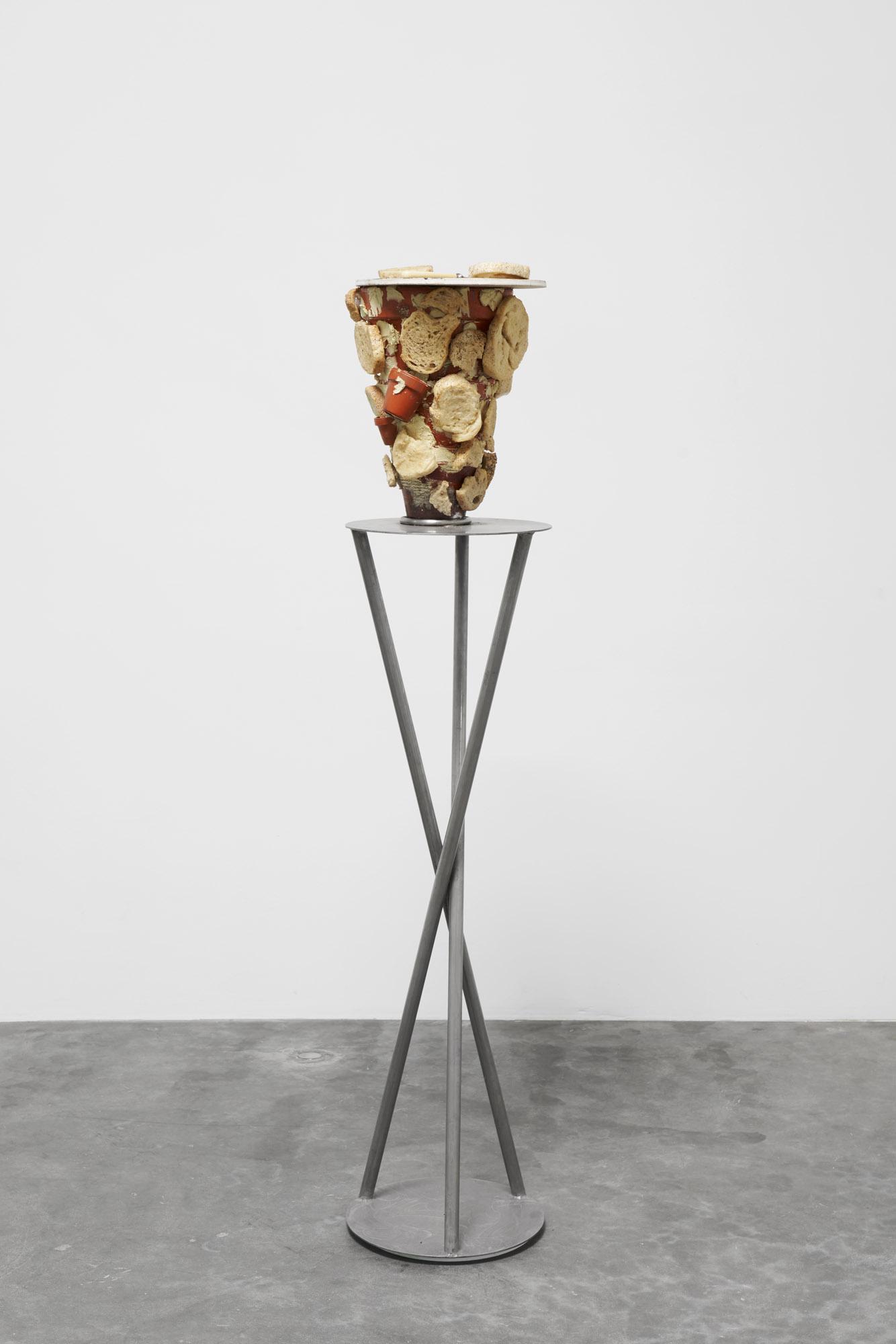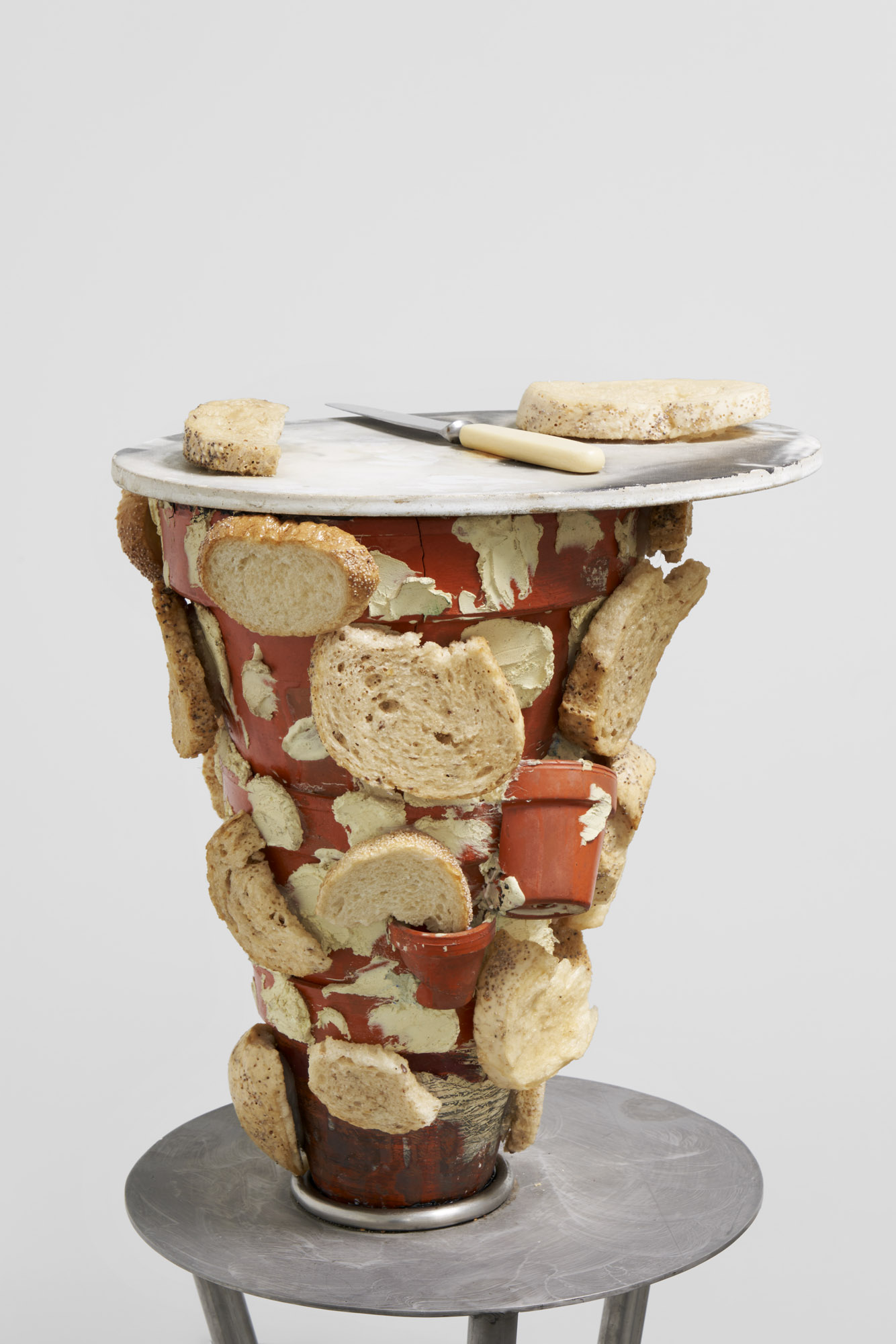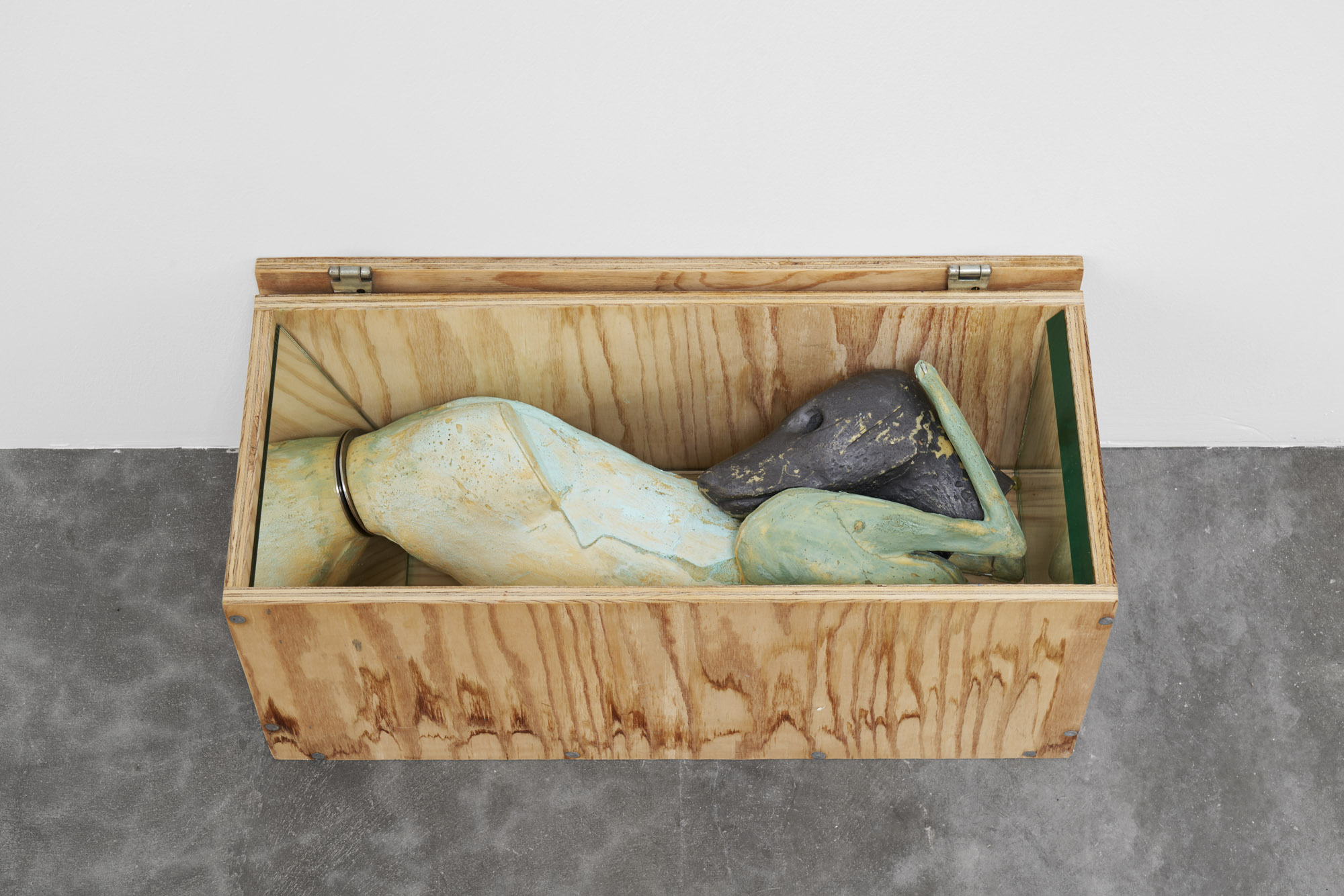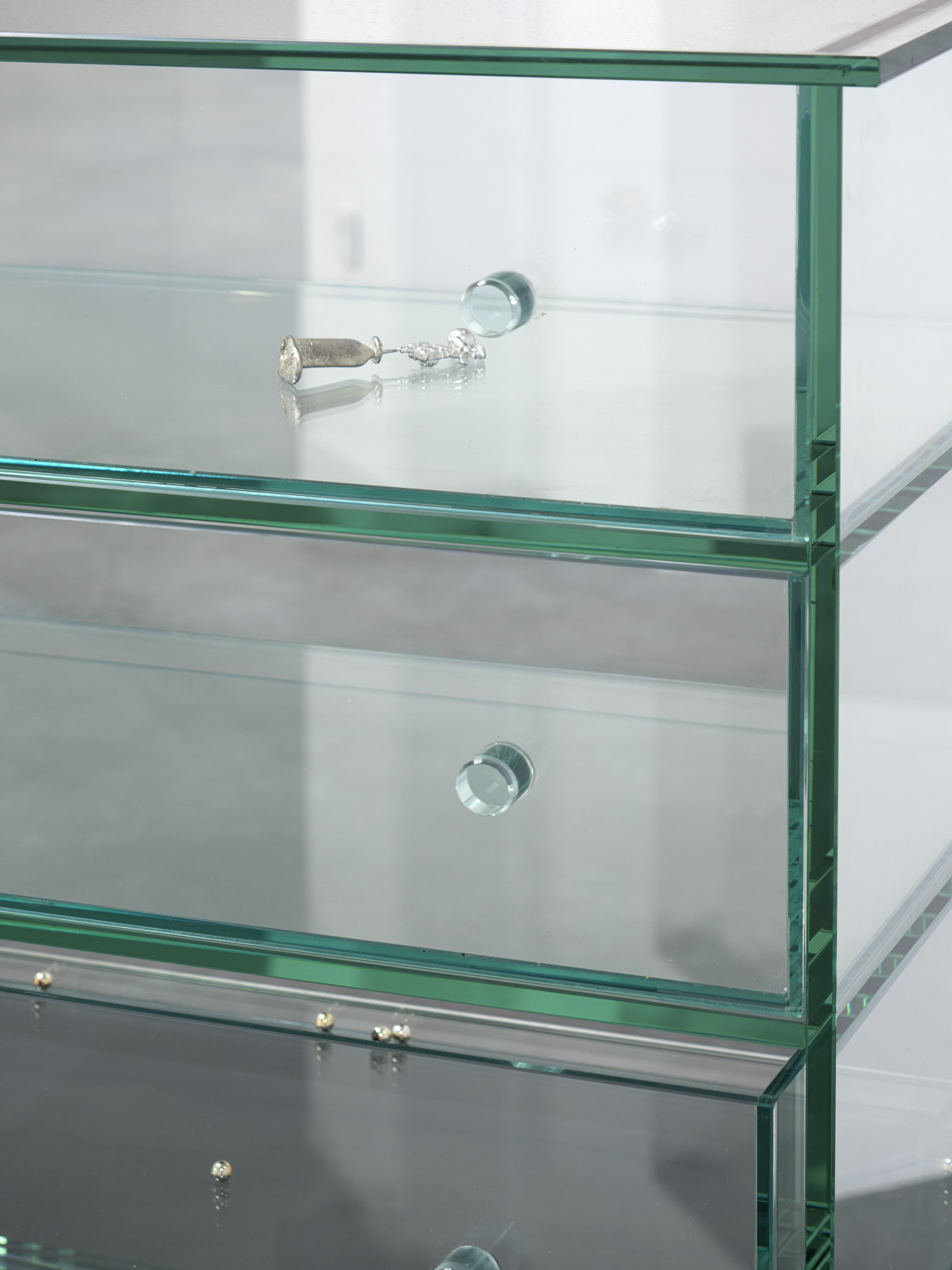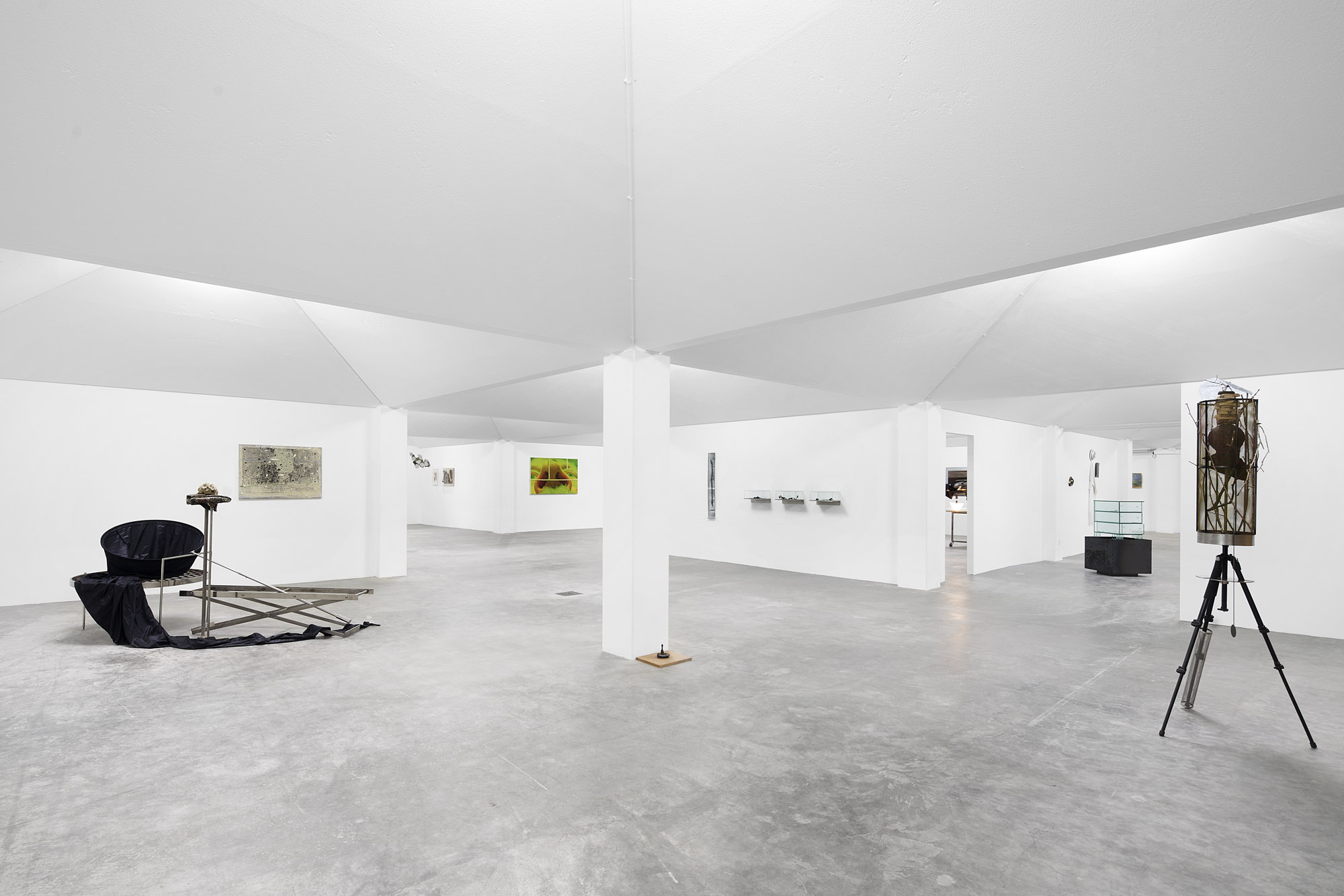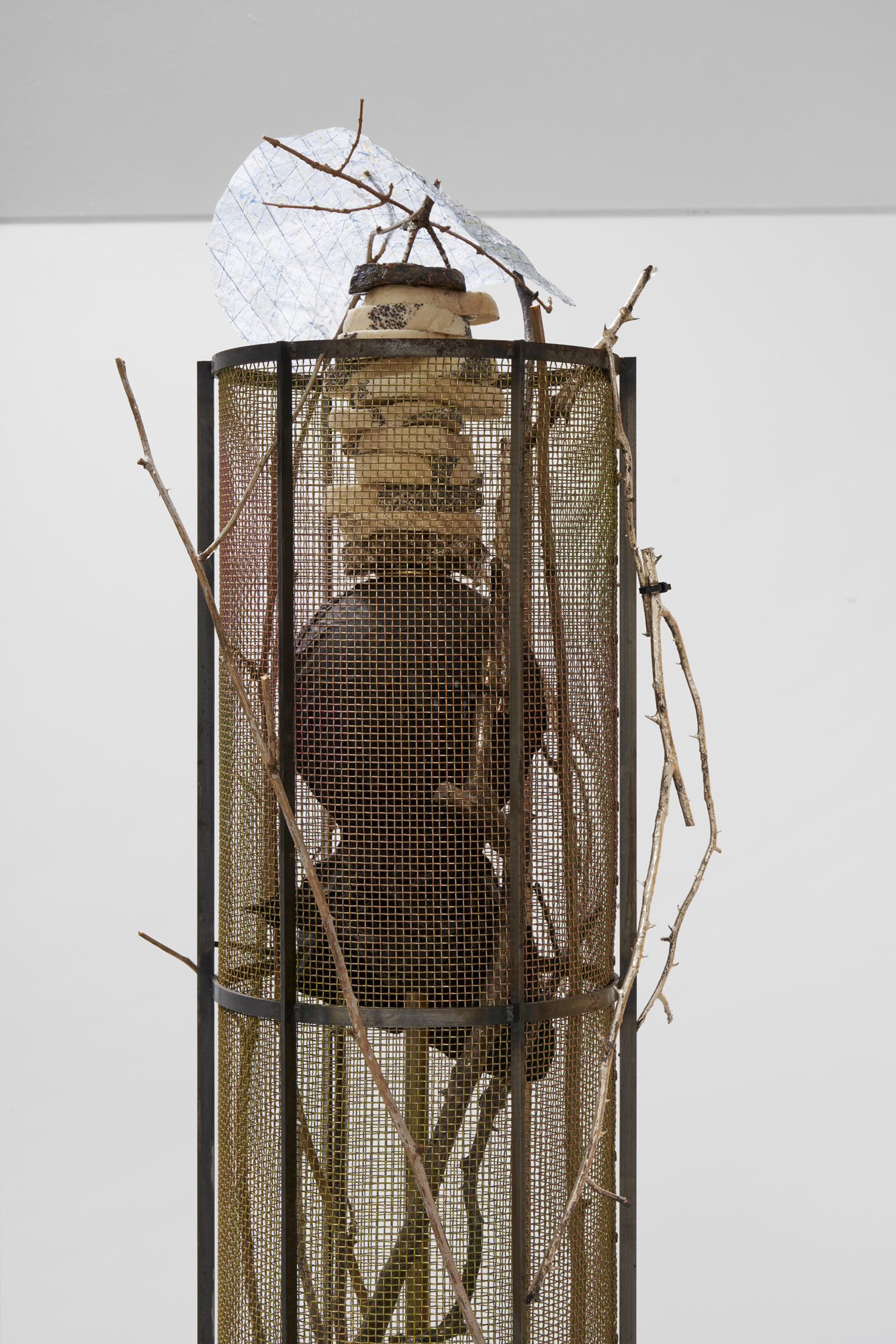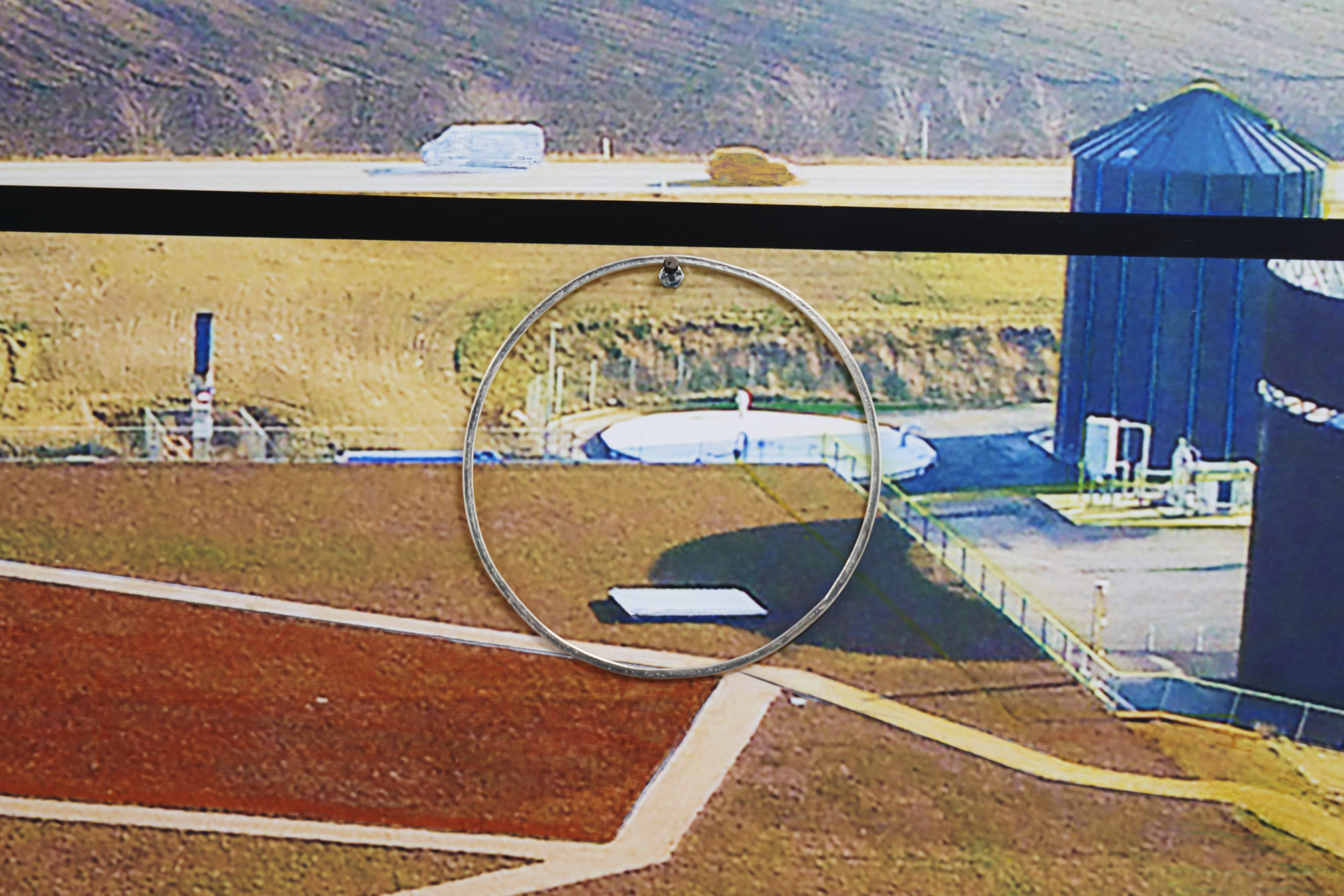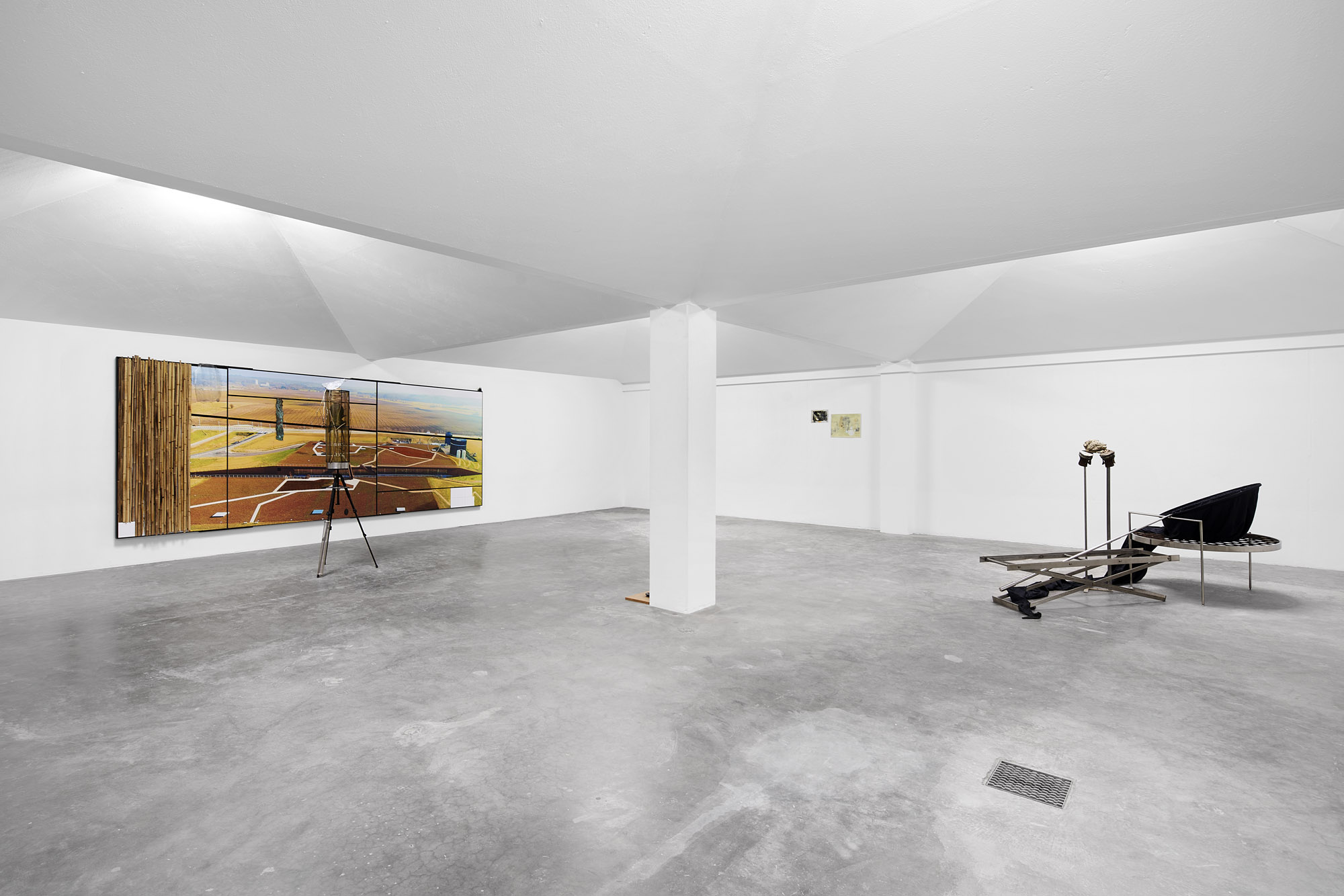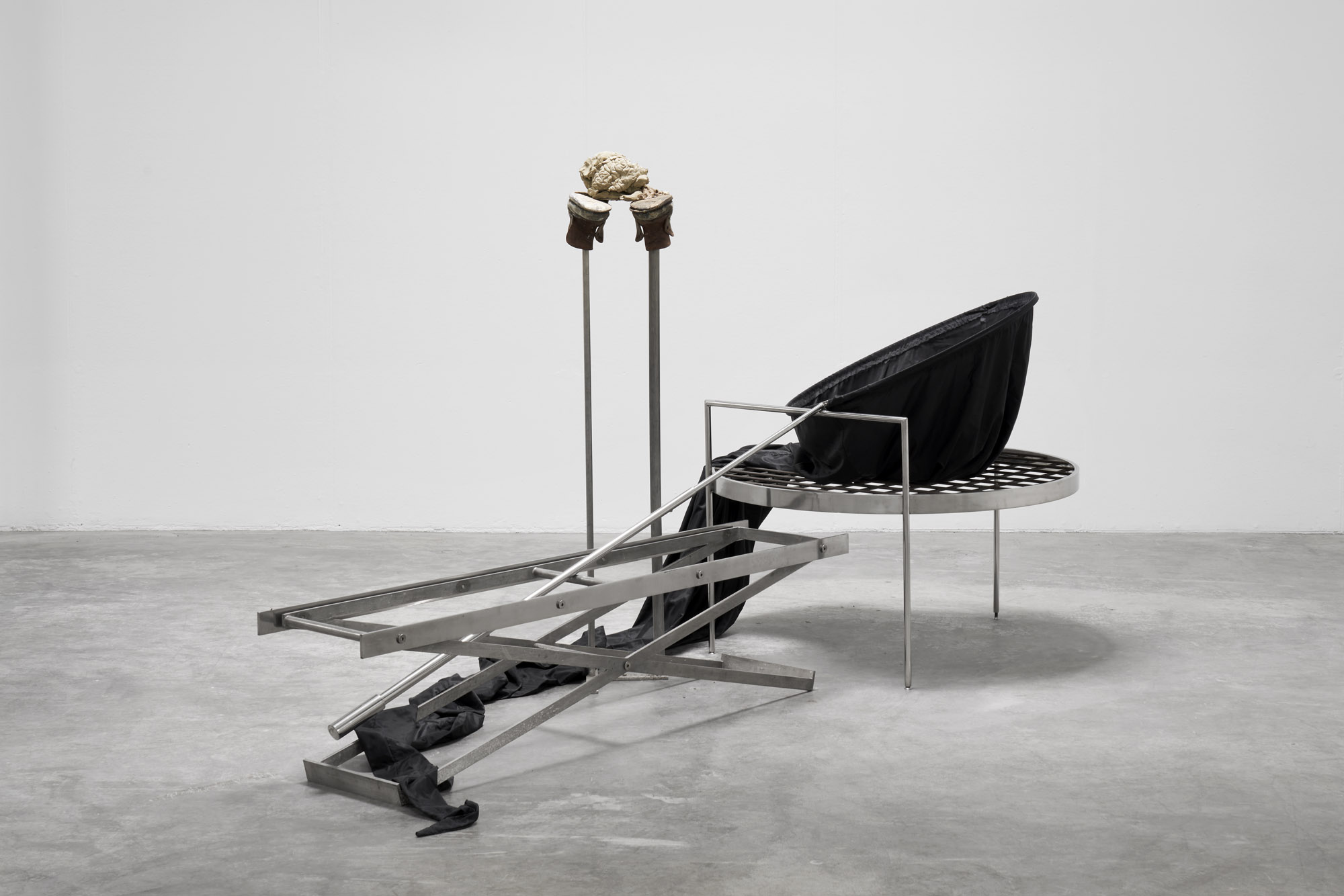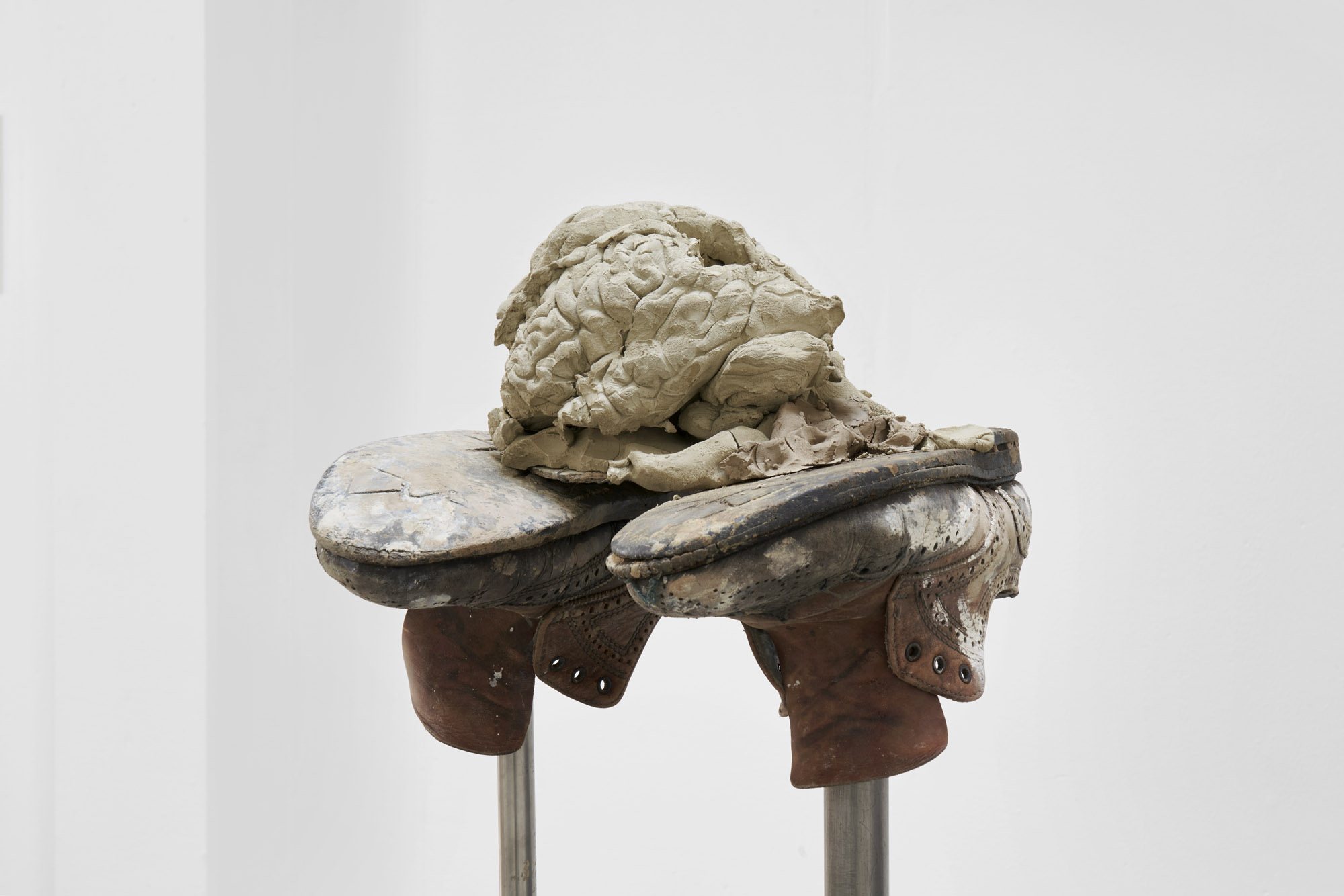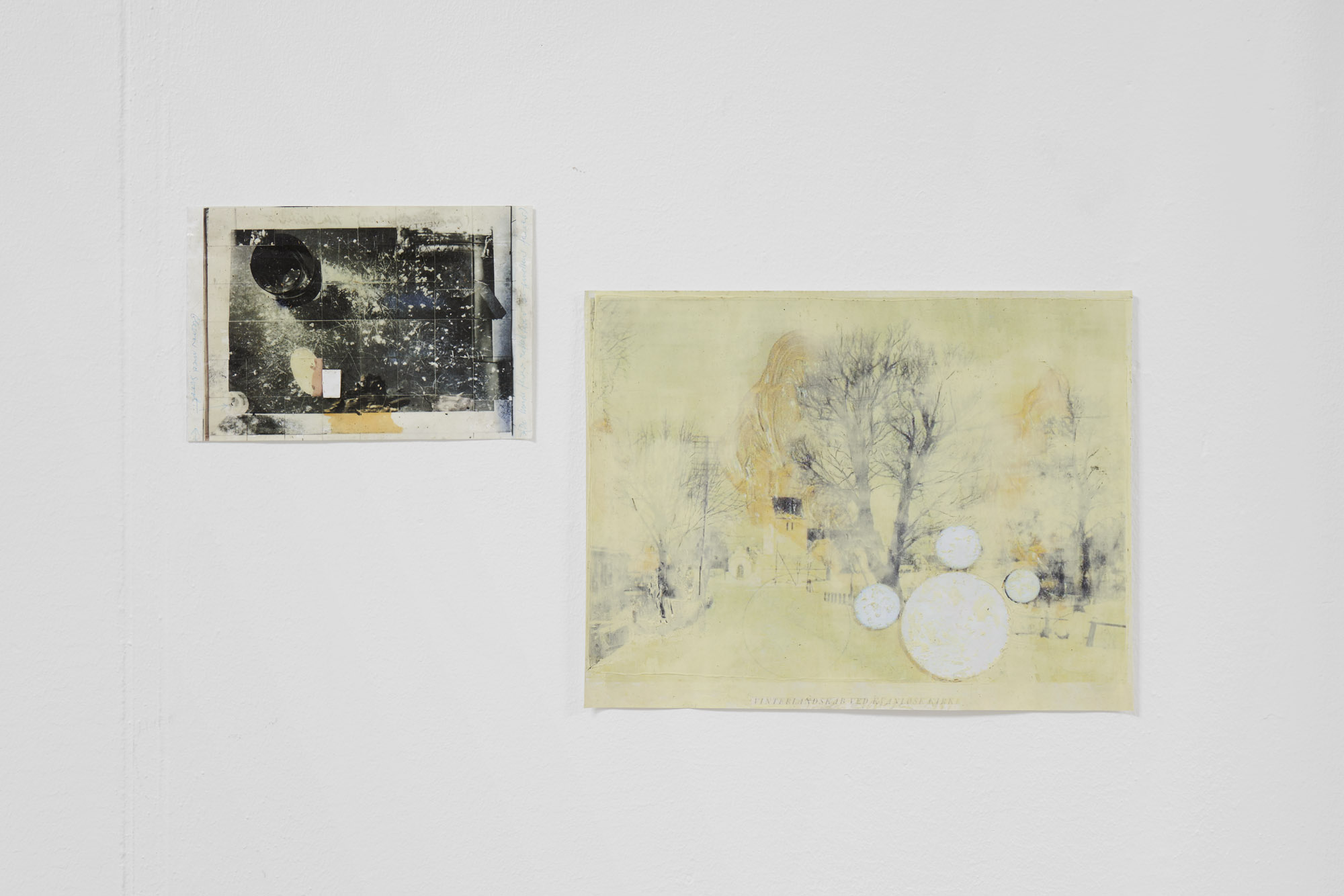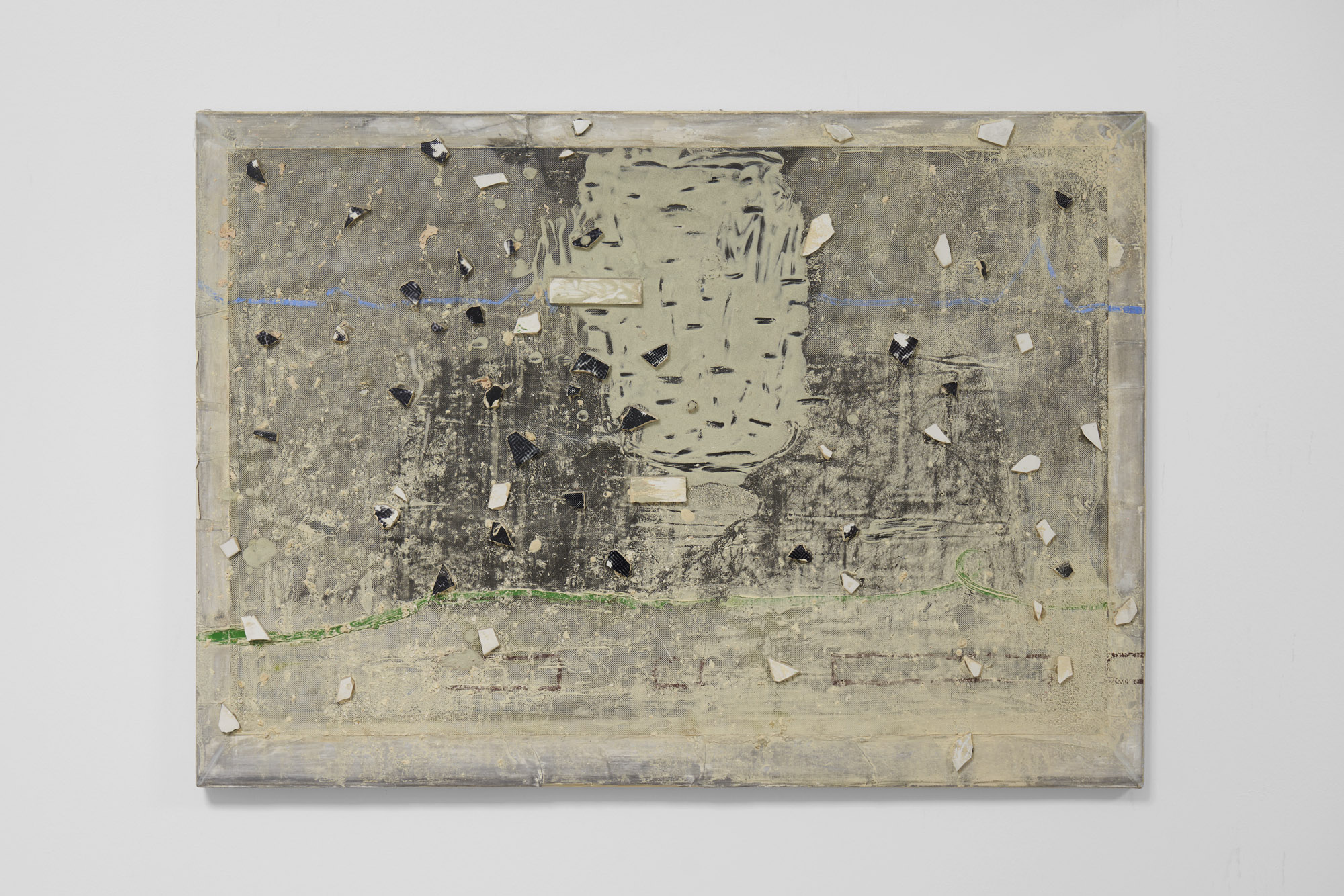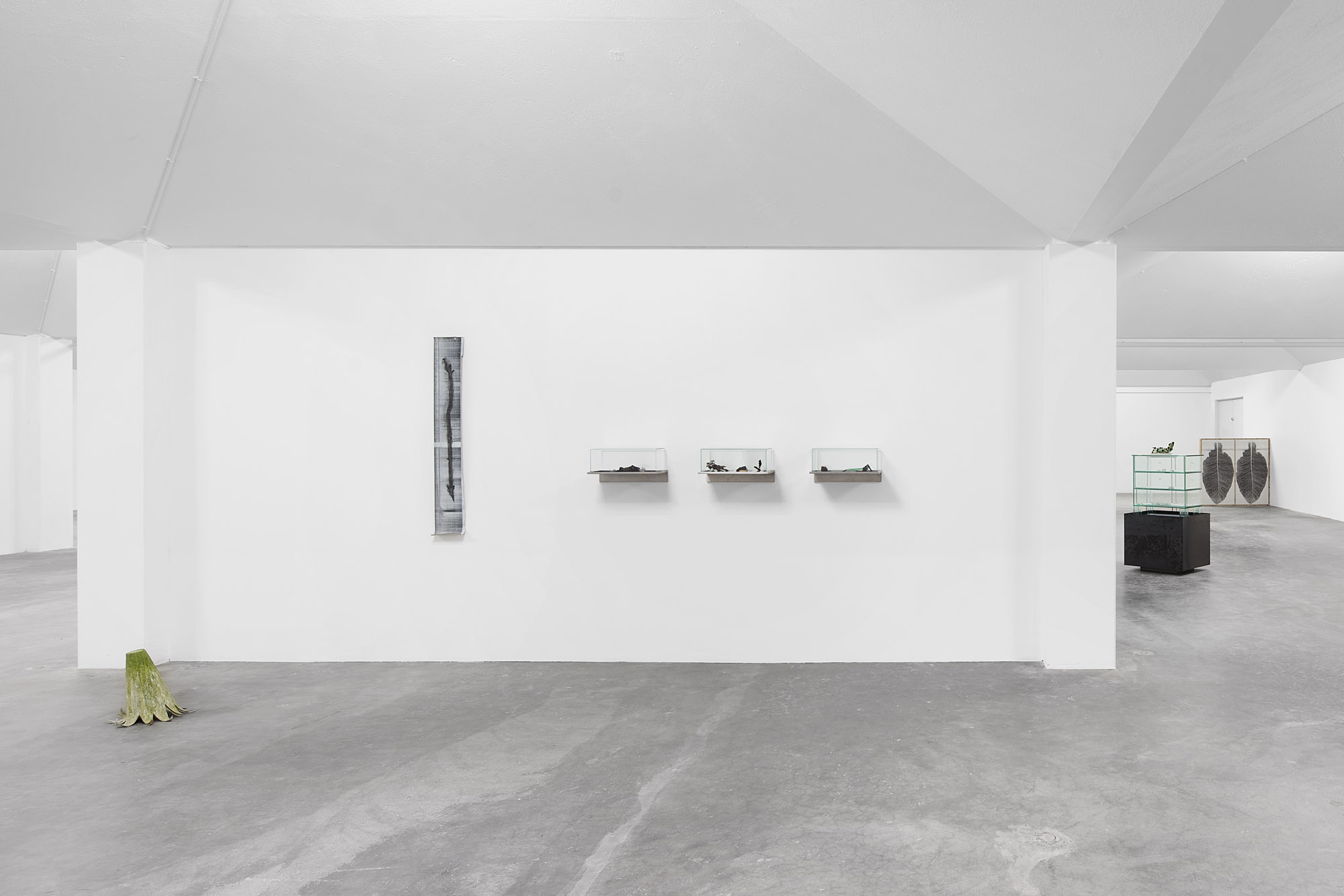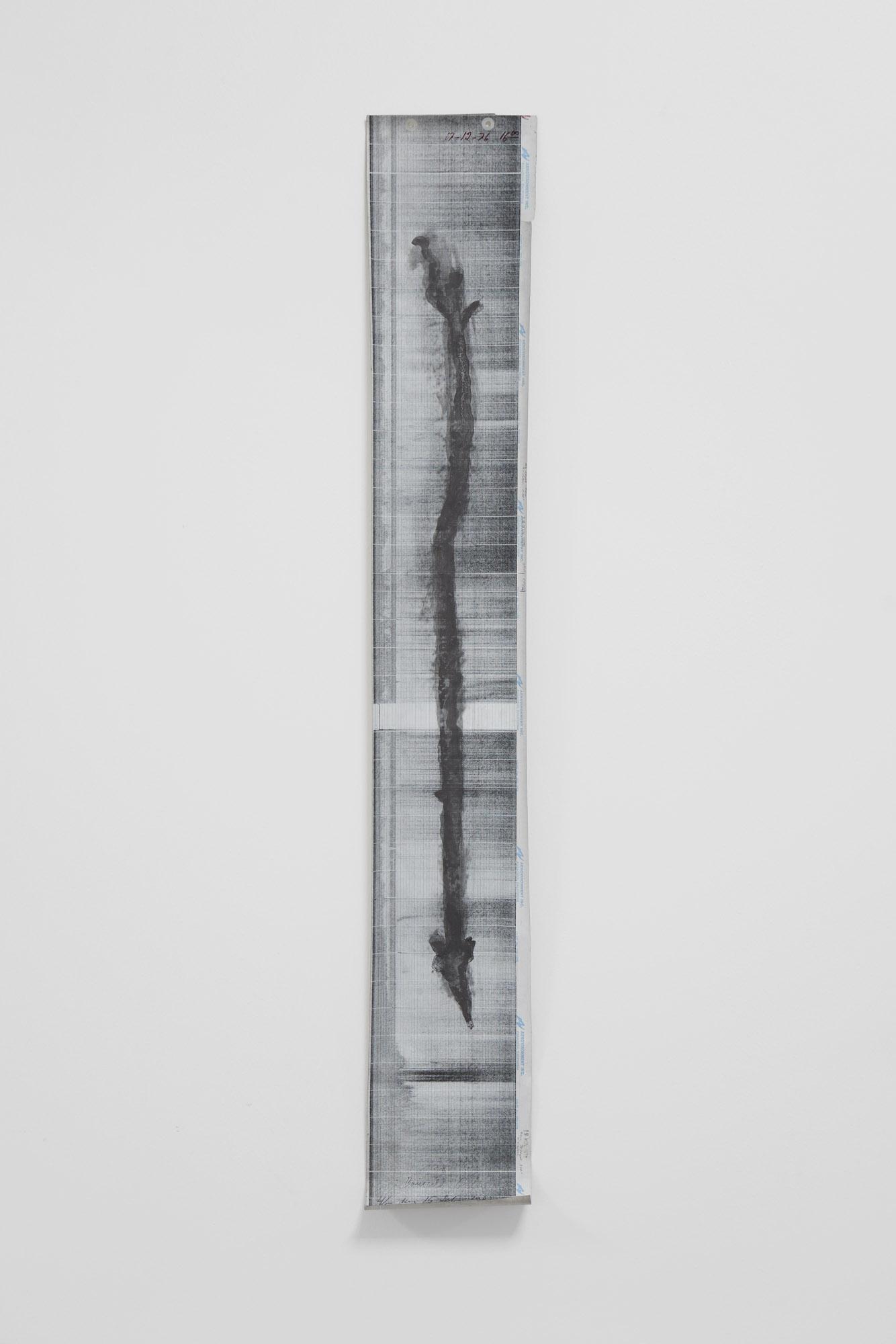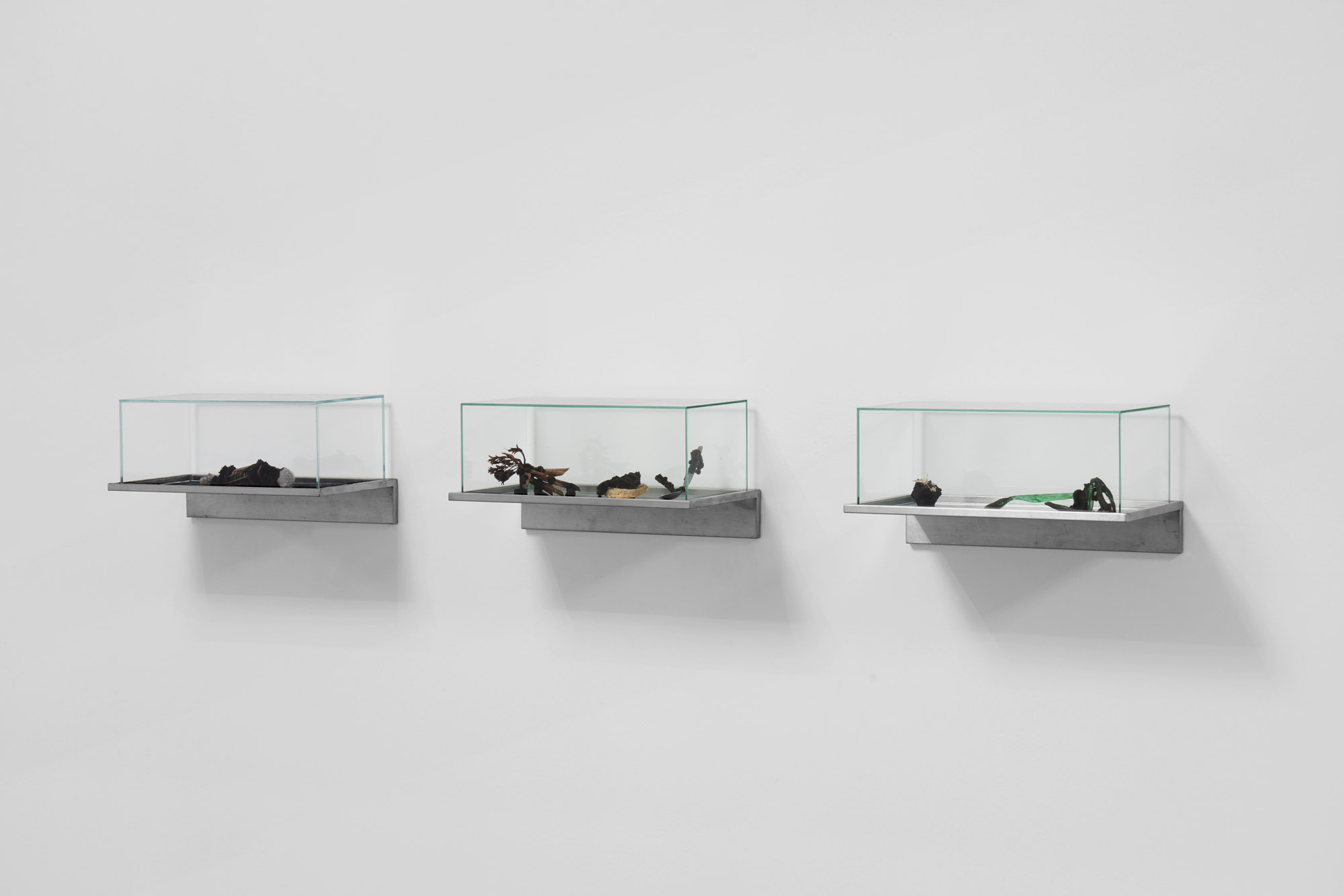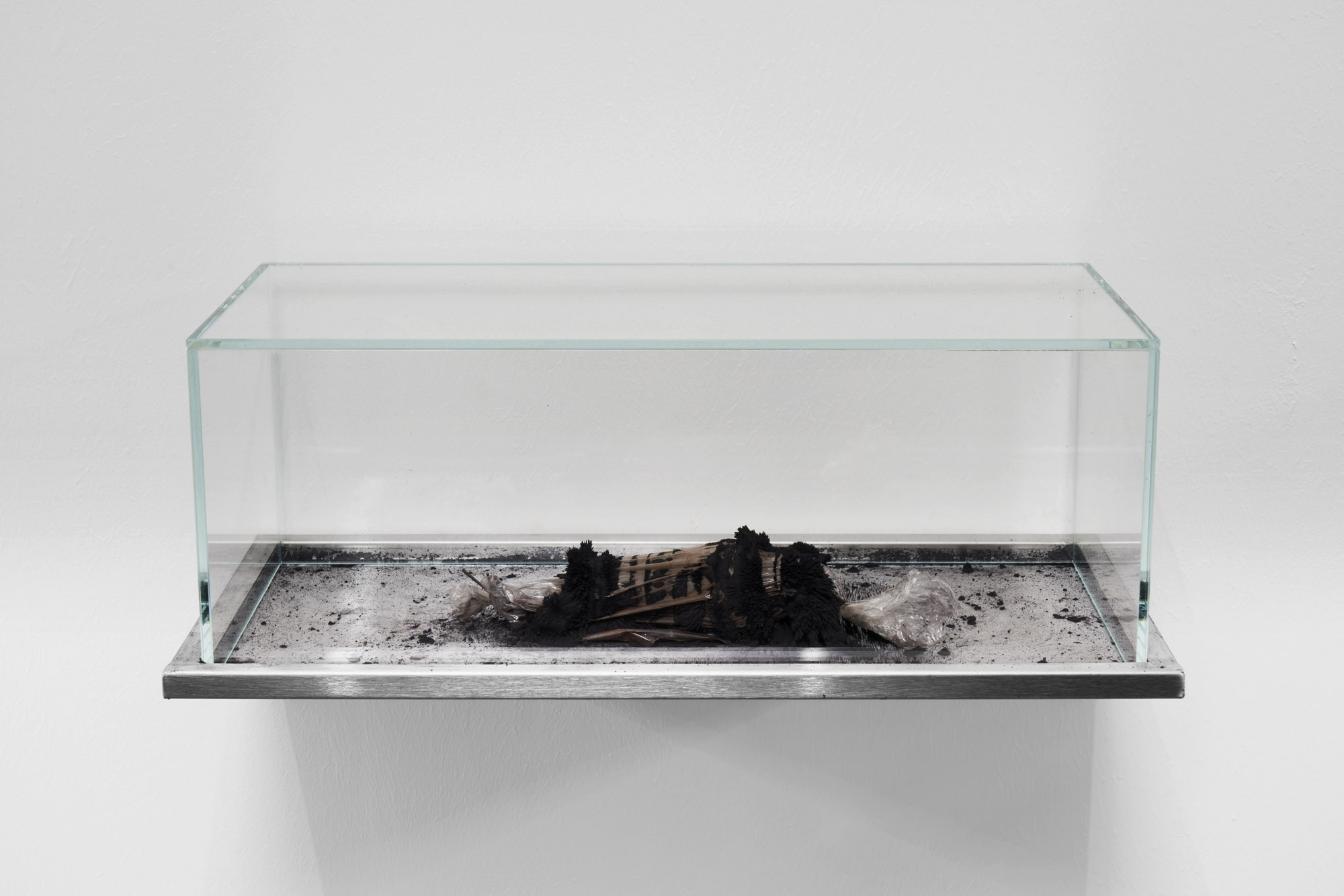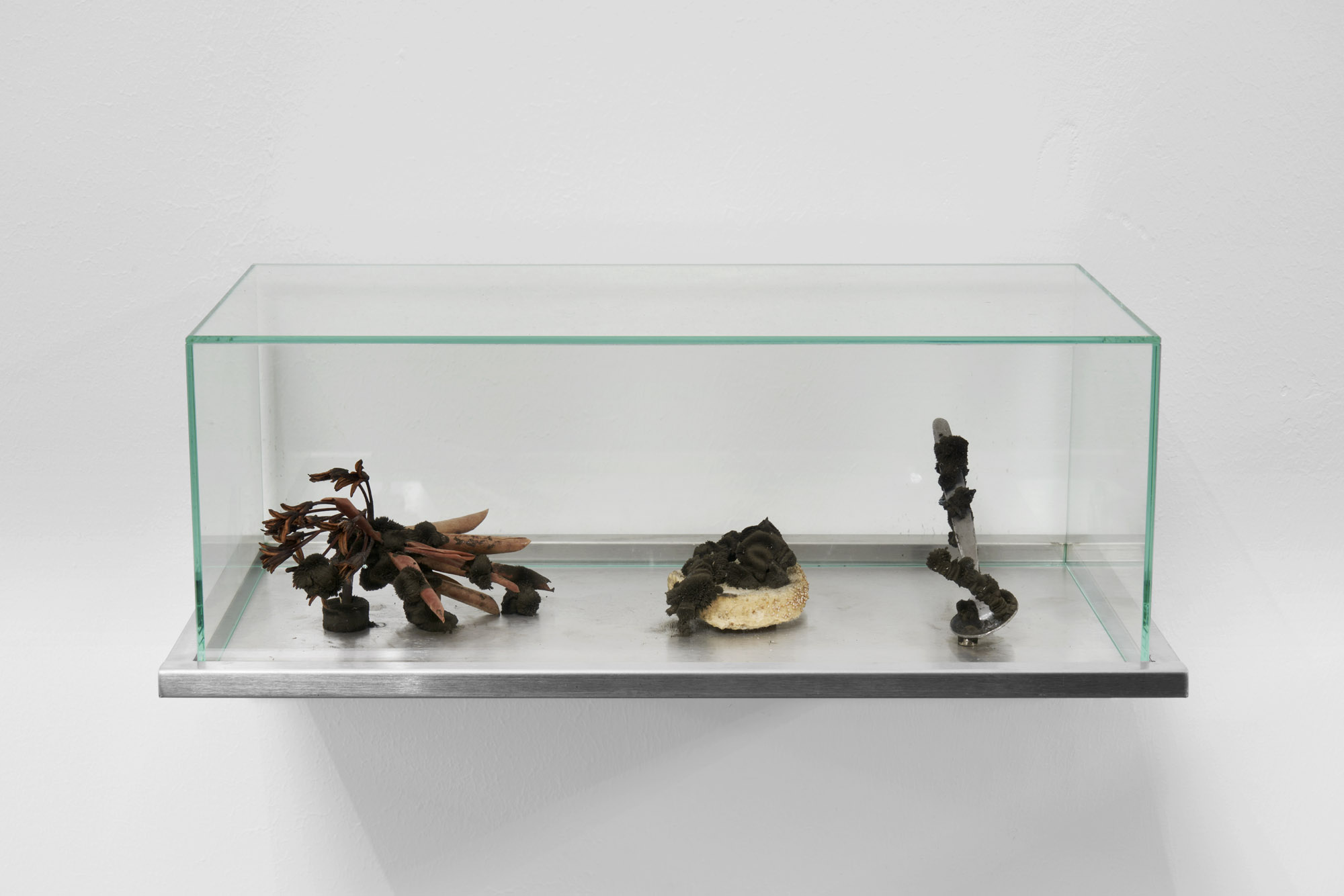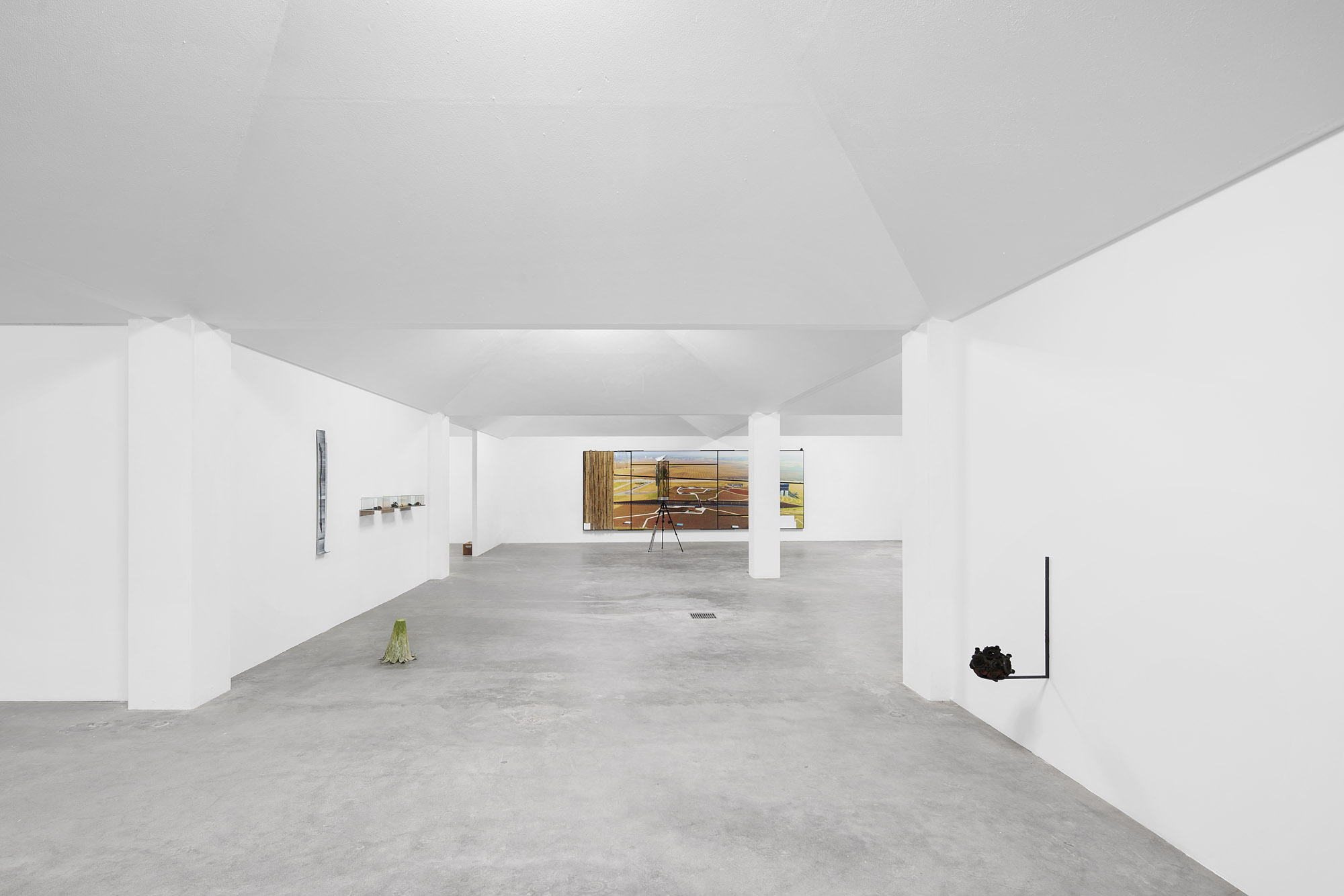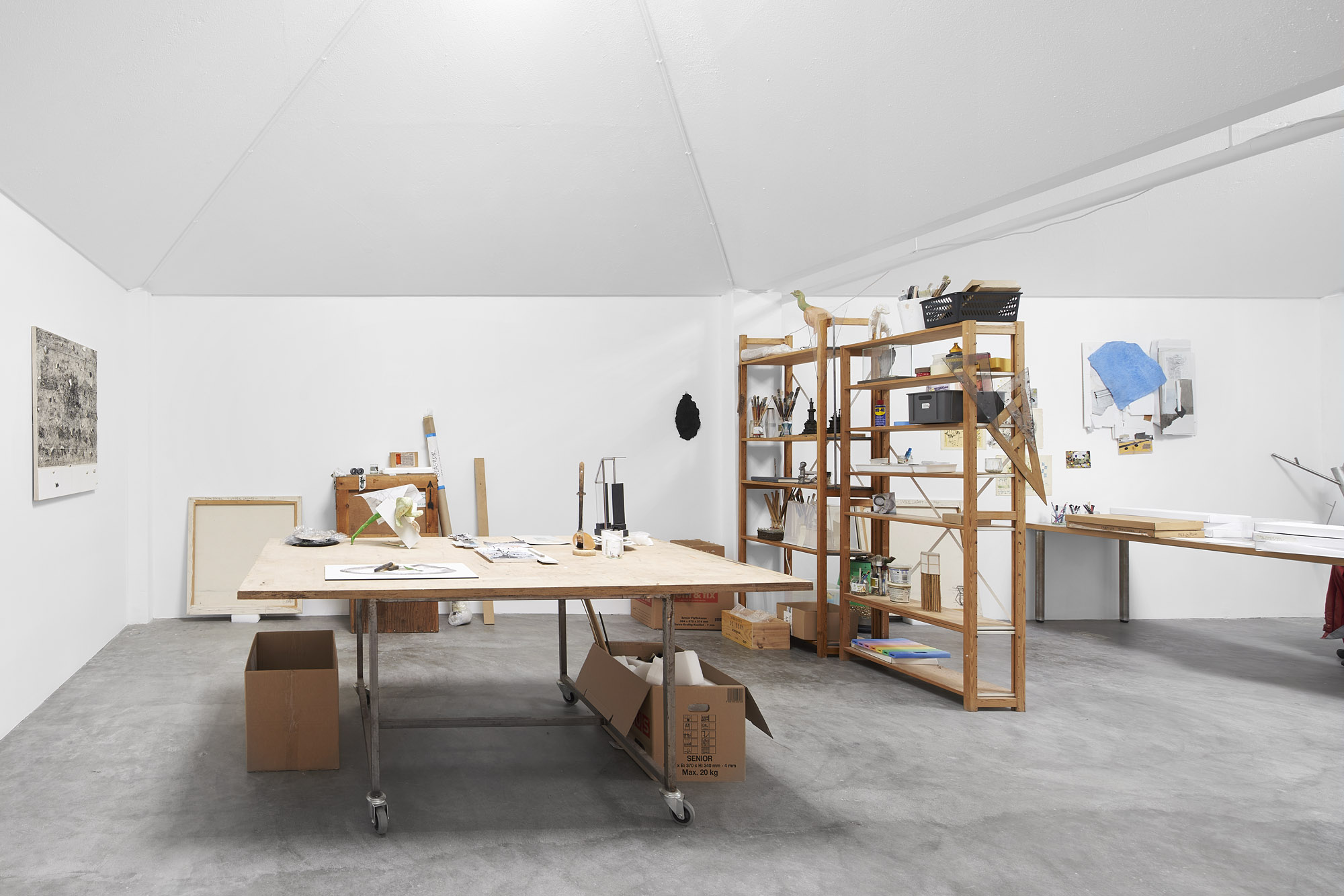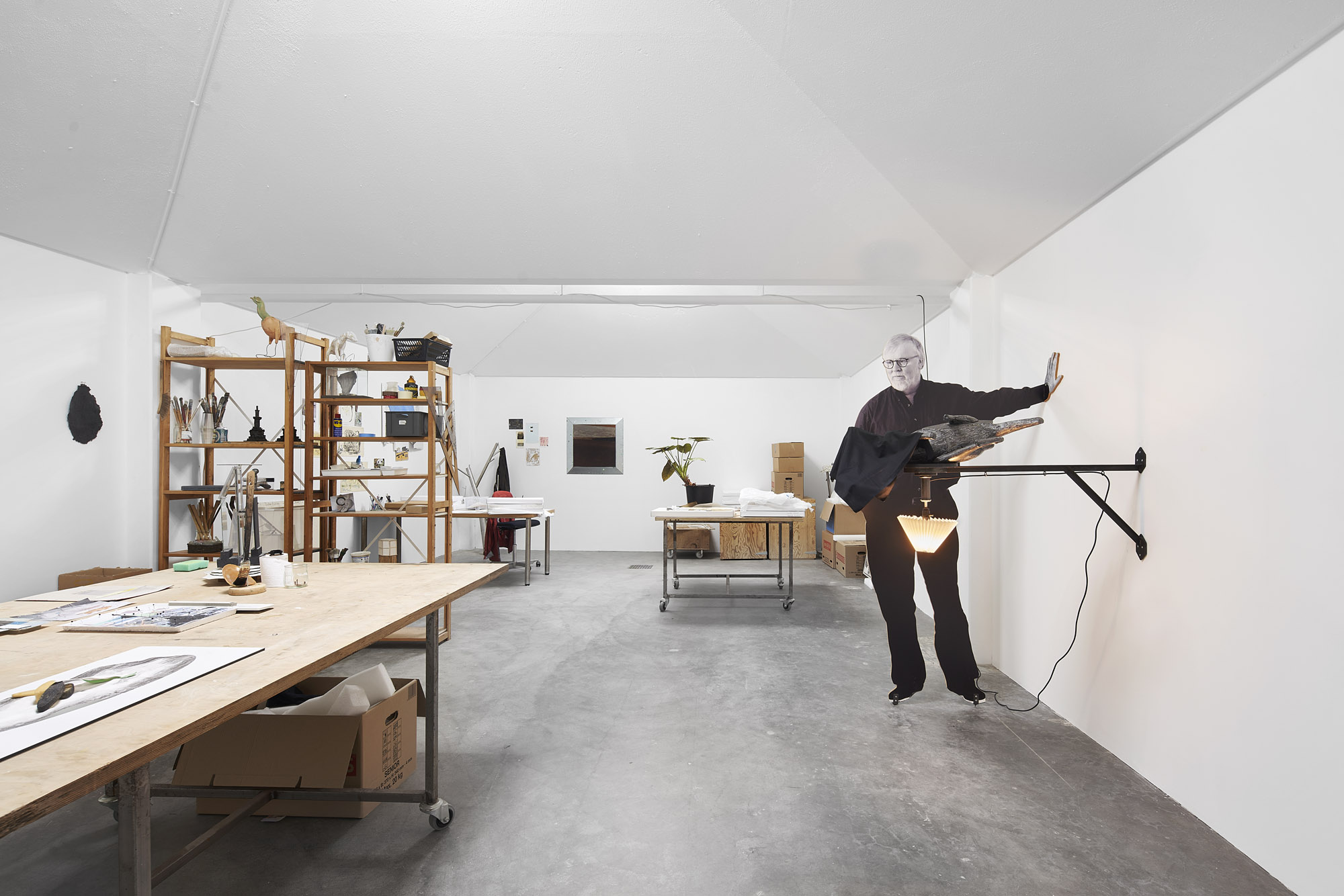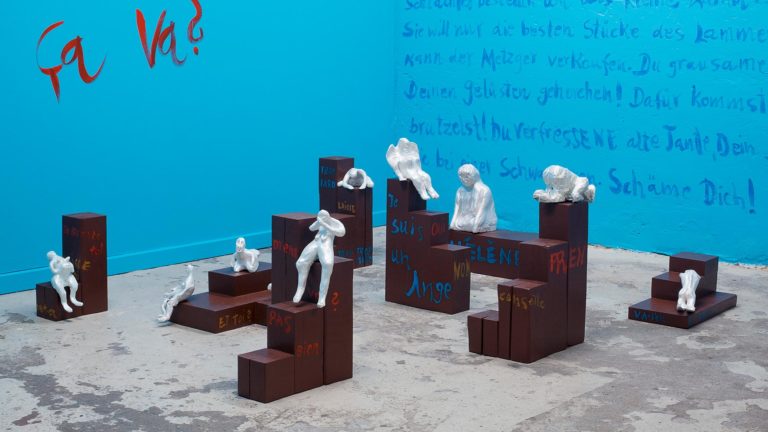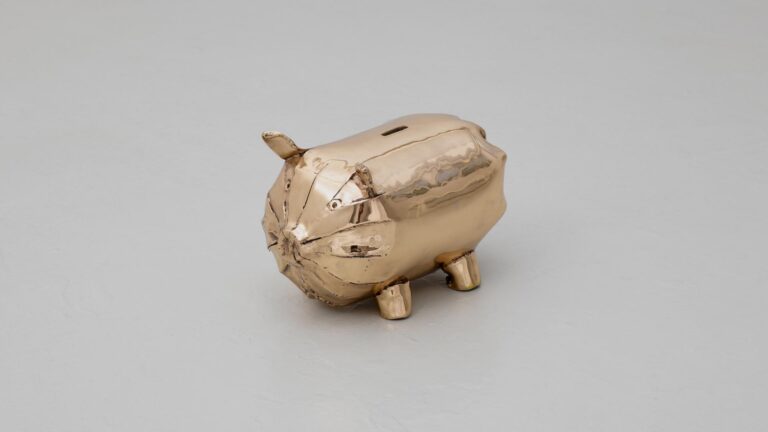Artist: Torben Ebbesen
Exhibition title: Between Yes and No
Venue: Simian, Copenhagen, Denmark
Date: August 27 – October 9, 2022
Photography: GRAYSC / All images copyright and courtesy of the artist and Simian, Copenhagen
Note: Exhibition booklet is available here
Research in opposites
Where to begin with Torben Ebbesen’s encyclopaedic output? From the late sixties to the present day, his works have moved across sculpture, painting, photography, drawing and architecture. They often take the form of constellations or collisions, where incongruous materials, images and signs appear in new connections. The meaning and implications of the works can perhaps be best approached by starting concretely, with the way they are rooted in senses and language.
Underlige aftendufte (Strange evening scents) (2007) is a psychedelic-looking colour photograph which shows a close-up of Ebbesen’s nostrils. Thick vertical and horizontal bamboo sticks are placed across the photograph. How can you read an image like this and still maintain the experience of it as fundamentally weird? The title immediately connects the motif with a specific time of day and associates it with a special sensory logic. It invites us to associate the artist’s nose with the capture of strange scents, whatever these may be. The significant adjective in the title “strange” helps to emphasise the abnormal nature of the situation. It’s almost as if the olfactory strangeness being referred to is transforming the person smelling it, thereby making them strange too? The photograph evokes the impression of a transformative system, where the sensual and the linguistic simultaneously delineate something invisible or ethereal at the limits of understanding. However, the language dimension far from exhausts the work, nor makes its meaning transparent. One noticeably feels that a code is needed to get to the bottom of it. The title perhaps above all gives the work a direction, by emphasising the paradoxical, comically disturbing situation we see before us. It clarifies and underlines the nature of the work as a subversive statement.
Opposite this, the sculpture Se! en stjerne (Look! a star) (2009) – in its title at least – is more inviting. Here language works to connect the strangeness of the object to a change of state, a sudden event. The work appears to be an animal that has been reconfigured and made abstract, transformed into an alien life form. The mysterious creature is placed on a dish and covered magnetically with magnetic dust. The title is of course again very indeterminate. Who is it anyway that speaks: Is the outburst “Look!” addressed to the viewer? Or does it address the animal that itself seems to look up into the air? If the latter is the case, the sensation here too could appear to change the point of view, as the animal has become magnetic and alien. The linguistic utterance and the sensory expression move around each other like two satellites that never quite meet, but which continue to keep the meaning unstable. The reference to a star helps to locate the figure and inscribe it in a visual connection between the earth and outer space. Language also has a temporal effect here, albeit of a different nature than before. When a sudden change occurs, the course of time also changes; time slows down and seconds can feel like minutes or maybe even hours. In an exceptional situation like this, time may seem to stand still.
Many of Ebbesen’s titles are in various ways entangled in senses and time, just as the works are materially and figuratively, of course. It is exciting to think about how language and physics overlap and interfere with each other. A consistent focal point in Ebbesen’s art over many decades is how expressions and ideas define our worldview in different ways. He himself has written: ‘What enables man to go from the sensory to the conceptual and vice versa?’ Does the concept contain the reason for an object’s reality, or do the objects justify the concepts. It is a question that philosophers have tried to clarify for many thousands of years, from Plato to Kant to Wittgenstein, among others, and there is hardly a definitive answer to be found. One can say that Ebbesen’s works help not only to keep the question alive but also to transform it into a kind of poetic quest to get beyond what we already know. One of the characteristics of his art is that it seeks boundaries, where one steps into the unknown. Normally, language helps hold together the world we already know. Ebbesen writes elsewhere: “Language concretises where art abstracts, and opens the spaces of meaning that extend beyond clearly defined realisations.” However, in his titles he himself uses language slightly differently. Here, language is not only concretised meaning or guarantor of communication, but rather a mixture of concrete and abstract, in itself a form of rebus and thus actually a bridge to the undefined. His use of language reinforces the strangeness of the works, or rather draws attention to them as dissonant statements that are also aimed at self-examination.
In the wall installation Navnløse (Nameless) (1996-97), Ebbesen focuses on what happens at the moment that designations, in this case people’s names, fall away. The title apparently has a descriptive function in relation to the work’s image components. It is made up of a large number of oval portrait photographs burned into earthenware, which have been variously processed, blurred, painted over, made grotesque, or otherwise made unrecognisable. The ghostly faces stare out as if they were from another universe. Some of the glances pierce me as if there were no distance at all, and thereby form a spontaneous intimacy, perhaps a bit like the punctum in Roland Barthes’ photo-theory. Their namelessness means that they have no linguistic anchoring in a particular historical or geographical context and therefore seem mysteriously floating, like notes in an abstract score. The work seems to think about what a reproduced person is without identification and context. It is thus also in dialogue with the function of private, family and passport photographs in relation to defining and maintaining identity and memory. It is as if the material treatment of the portraits with sulphur, graphite, varnish, shellac and oil counteracts the anonymising function of the title by giving each of the people their own character and life. They are made into singular existences that insist on being.
What about the reverse situation, where it is a sense and not the language that is missing? This is perhaps expressed in the series Blindt billede (Blind image) (1988-92). Combining blindness and image may at first appear to be a linguistic contradiction, in the sense that visual and pictorial art are usually perceived as identically shaped. Conversely, one can ask if not all images are blind in a certain way? Unless one perceives them as anthropomorphic beings, or photographs looking back, as physical objects they literally cannot see. But perhaps the title should be understood differently, as images of the non-visible, images that metaphorically turn inward? The works contain fired earthenware motifs, worked with sulphur. They move continuously between a representation and an abstraction. The pictures are framed in galvanized iron with a title plate at the bottom, giving them a sturdy prefabricated look. They are alluring because they are indeterminate, seeming to have fallen out of time like some kind of antique sci-fi props or fragments of a dystopian future that does not exist. By calling a painting a blind image, Ebbesen problematises both the function of the painting as a visualisation of something external, and at the same time how we look at and store images in our minds. Something similar seems to be at work in a painting such as Udforsket måne over blind vej (Explored moon over dead end) (1990). It depicts a detailed lunar landscape, implicitly 380,000 km away, juxtaposed with a painted sketch of a road that could be right outside the door. Which phenomena are perceived in our technological age as being close and which as far away? What does it change about the notion of distance when technologies such as telescopes or drones become extensions of the body? Perhaps new visibility is organically linked to new blind spots.
One can also consider whether the reduction of certain sensory channels does not also help to strengthen and transform the other senses – which, for example, Vilém Flusser (another of Ebbesen’s references) has written about at length. In the work Lille kinesisk dyr gemmer sig i skyerne (Small Chinese animal hides in the clouds) (2015), a mobile suspended from the ceiling, the blocking of the gaze immediately leads to an increased attention to tactility. The form is made up of a small, partly abstract animal which is, however, covered with bits of porcelain, effectively making it more or less unreadable. The work title translates the (anti-)visual form without making the two areas symmetrical. It invites one to experience the porcelain parts as floating clouds in a transformation from hard to soft and a shift in scale from small to large. It also inscribes the animal in a narrative, perhaps an H.C. Andersen fairy tale but where the plot is obscured. First of all, it endows the animal with a life and an agency of its own, a will to become invisible or immaterial, like the clouds it apparently hides in. There is a particular tension between the fictional function of the title and the factual concreteness of the form, which sets the work in motion. What does it mean to try to read a form that you cannot access with your eyes? For Ebbesen, it is a question that is not only relevant to the viewer but also in relation to the production of a work: “When you work in three dimensions, you work with darkness – even though you can see what is going on”, he writes. Darkness can be understood both literally and metaphorically. Literally, all three-dimensional form has an inner space, it can be empty or filled, around which the substance is built. Metaphorically, one can say that sculpture not only addresses the viewer’s gaze but also primarily the body, the darkness that one carries around and is situated in. The reading of half-visible things automatically also activates non-visible sides of oneself, for example the back of the body or the underside of one’s feet. In this way, there is darkness on all sides. Enlightenment is perhaps only something we imagine.
Ebbesen’s latest work is called Afrikansk ornitolog, med mærkelig hat, ser på et vandrensningsanlæg (African ornithologist, with strange hat, looking at a water treatment plant) (2022). The title identifies the object assemblage at the front as an African ornithologist and the five-metre-long photograph behind as a sewage treatment plant. This arrangement seems to contain an immediate reflection on vision and seeing. The treatment plant is filmed by a flying drone from a bird’s eye view, while the ornithologist figure, who can be thought of as looking for birds in the landscape, is placed on a camera tripod. The ornithologist in front of the picture initially appears as the primary viewer of the subject and in a way pushes us out into the periphery as secondary viewers. One could also say that it invites you to experience the image vicariously by putting oneself in the place of the ornithologist. This viewing situation seems related to two earlier works by Ebbesen, Formidling og Fortolkning (Mediation and Interpretation) (both 1992). In each of these works, a fox-like plastic figure is placed on the floor in the role of viewer in front of a large photograph on the wall. In Formidling the photograph is a representative motif containing two other foxes, while in Fortolkning it is a semi-abstract image. In Afrikansk ornitolog, med mærkelig hat, ser på et vandrensningsanlæg something similar is happening. By placing a personified object in front of the photograph, it becomes clear that images always contain the gaze of others – whether these others are people, animals or drones. It makes it possible not only to look at the work from the outside, but to look at the work with the work.
The title of the exhibition Between Yes and No is borrowed from a constructivist sculpture that Ebbesen made back in 1978. It can be seen as an homage to Yevgeny Yevtushenko’s poem “The City of Yes and the City of No” (1963, translated into Danish in 1968), which Ebbesen became acquainted with in connection to his preoccupation with Russian avant-garde art. In the poem, I find myself in transit between two totalitarian cities, which are based on affirmation on the one hand and negation on the other. As a response to these ideological or utopian absolutes, the journey’s undecided and infinite form of existence is defended. In his monograph on Ebbesen from 1999, Michael Hübl points out that the title can also be understood in terms of the artist’s dialogue with natural science. He highlights Werner Heisenberg’s uncertainty principle, which states that it is not possible to determine a particle’s position and momentum at the same time. In any case, Between Yes and No points to states of undecidedness, dualism and tension as central aspects of Ebbesen’s work. The works combine incongruous elements not with a view to harmony, but to maintain a displacement of senses and language, from which reality can perhaps be understood from new angles. How do you get from concepts to senses and how from senses to concepts? For Ebbesen, art and science each have a role to play here. They are both forms of production, where the empirical and the speculative go hand in hand and where results are primarily used as a starting point for new models of the world.
-Text by Magnus Thorø Clausen
Torben Ebbesen, born 1945 in Haderslev, Denmark. Educated from The Royal Academy of Fine Arts and The Royal Danish Academy of Fine Arts, School of Design.
Recipient of the Eckersberg Medal, Thorvaldsen Medal, the 3-year work grant from the Danish Arts Foundation as well as the Danish Knights Cross.
Co-founder of the group Ny Abstraktion. Member of Den Frie Udstilling. Professor in painting at University of Gothenburg. Former head of the Danish Arts Foundations Purchasing, Grants and Decorations Committee. Representative of Denmark at the Venice Biennale.
Public commissions include Vejle Hospital, Denmark; Novo Nordisk, Seattle, USA and Copenhagen, Denmark; Copenhagen University College of Engineering, Ballerup, Denmark; University of Karlsruhe, Germany; HTX Technical High School Viby, Aarhus, Denmark; University of Tübingen, Germany; Danish Pedagogical University, Emdrup, Denmark.
Solo exhibitions include: Galleri Per Sten, Copenhagen, Denmark; Galerie Nemo, Eckernförde, Germany; Aarhus Kunstmuseum (ARoS), Denmark; Galerie Basilisk, Copenhagen, Denmark; Galerie Lydia Megert, Bern, Switzerland; Galerie Brigitte March, Stuttgart, Germany; Galleri Wassermann, Munich and Cologne, Germany; Stalke Galleri, Copenhagen, Denmark; Sophineholm, Lyngby, Denmark; Göteborgs Konsthall, Gothenburg, Sweden; The Danish Pavilion, Venice Biennale, Italy; Nordic House, Reykjavik, Iceland; Glyptoteket, Copenhagen, Denmark; Galleri Faurschou, Copenhagen, Denmark; Esbjerg Kunstmuseum, Denmark; Nordjyllands Kunstmuseum (KUNSTEN), Aalborg, Denmark; Kunsthal Nikolaj, Copenhagen, Denmark; KØS Museum, Køge, Denmark; Lüneburger Kunstverein und Kunstraum Tosterglope, Germany.
Amongst others, represented in the following collections and museums: SMK National Gallery of Denmark, Copenhagen, Denmark; KIASMA, Museum of Contemporary Art, Helsinki, Finland; Neue Staatsgalerie, Stuttgart, Germany; Royal Collection of Graphic Art, Copenhagen, Denmark; Moderna Museet, Stockholm, Sweden, New Carlsberg Foundation, Copenhagen, Denmark; Designmuseum Danmark, Copenhagen, Denmark; Sorø Kunstmuseum, Sorø, Denmark; HEART Museum of Contemporary Art, Herning, Denmark; Esbjerg Kunstmuseum, Esbjerg, Denmark; Gothenburg Museum of Art, Gothenburg, Sweden; Kunsthalle Recklinghausen, Recklinghausen, Germany; Tønder Kunstmuseum, Tønder, Denmark; Danish Arts Foundation, Denmark.
Torben Ebbesen, Between Yes and No, 2022, exhibition view, Simian, Copenhagen
Torben Ebbesen, Navnløse (Nameless), 1996-97, steel, faience, sulphur, shellac, oil, acrylic, urethane
Torben Ebbesen, Navnløse (Nameless), 1996-97, steel, faience, sulphur, shellac, oil, acrylic, urethane
Torben Ebbesen, Navnløse (Nameless), 1996-97, steel, faience, sulphur, shellac, oil, acrylic, urethane
Torben Ebbesen, Danish Night Volume, 1996-97, steel, shellac-cardboard, stainless steel, glass tubing with grass snake
Torben Ebbesen, Danish Night Volume, 1996-97, steel, shellac-cardboard, stainless steel, glass tubing with grass snake
Torben Ebbesen, Danish Night Volume, 1996-97, steel, shellac-cardboard, stainless steel, glass tubing with grass snake
Torben Ebbesen, Between Yes and No, 2022, exhibition view, Simian, Copenhagen
Torben Ebbesen, Udkast til skulptur (Proposal for sculpture), 2019, plastic, speakers, magnets, oil stick
Torben Ebbesen, Gentagelse af en fejl (Repetition of a mistake), 2007, transparency film print, dibond, acrylic paint, pen, cling wrap, glass frame
Torben Ebbesen, Pludselig forandring (Sudden change), 2007, photo print, plastic, branch, acrylic paint, wood, silicone, Plexiglass
Torben Ebbesen, Lille kinesisk dyr gemmer sig i skyerne (Small Chinese animal hides in the clouds), 2015, faience, polyurethane, epoxy sculpt
Torben Ebbesen, Between Yes and No, 2022, exhibition view, Simian, Copenhagen
Torben Ebbesen, Between Yes and No, 2022, exhibition view, Simian, Copenhagen
Torben Ebbesen, Underlige aftendufte (Strange evening scents), 2007, UV-print, canvas, bamboo, acrylic paint
Torben Ebbesen, Udkast til Piero della Francescas hat II (Proposal for Piero della Francescas hat II), 2018-19, wood, acrylic paint, glass, hardware, epoxy sculpt, steel, marble, oil stick, faience, magnets, aluminum foil, ink
Torben Ebbesen, Udkast til Piero della Francescas hat III (Proposal for Piero della Francescas hat III), 2018-19, wood, acrylic paint, glass, hardware, epoxy sculpt, steel, slate, oil stick, faience, paper, pencil, magnets, aluminum foil, ink
Torben Ebbesen, Between Yes and No, 2022, exhibition view, Simian, Copenhagen
Torben Ebbesen, Between Yes and No, 2022, exhibition view, Simian, Copenhagen
Torben Ebbesen, Between Yes and No, 2022, exhibition view, Simian, Copenhagen
Torben Ebbesen, Uden titel (Untitled), 2016, plastic, wax, epoxy sculpt
Torben Ebbesen, Særligt måltid (Special meal), 1996, wood, paper commercials, oil paint, canvas
Torben Ebbesen, Between Yes and No, 2022, exhibition view, Simian, Copenhagen
Torben Ebbesen, Between Yes and No, 2022, exhibition view, Simian, Copenhagen
Torben Ebbesen, Blindt billede (Blind image), 1988, faience, wood, sulphur, glue, galvanized steel, brass
Torben Ebbesen, Blindt billede (Blind image), 1990, faience, wood, sulphur, glue, galvanized steel
Torben Ebbesen, Blindt billede (Blind image), 1990, faience, wood, sulphur, glue, galvanized steel
Torben Ebbesen, Dobbelt lever (Double liver), 2005, photo print, paper, wood, acrylic paint, galvanized steel, silicone, glass
Torben Ebbesen, Blindt billede (Blind image), 1988, faience, wood, sulphur, glue, galvanized steel, brass
Torben Ebbesen, Between Yes and No, 2022, exhibition view, Simian, Copenhagen
Torben Ebbesen, Uden titel (Untitled), 1992, faience, wood, oil paint, acrylic paint, galvanized steel
Torben Ebbesen, Melankoli III (Melancholia III), 2000, steel, glass, wood, wax, buttons, aluminum foil, chalk, mirror
Torben Ebbesen, Melankoli III (Melancholia III), 2000, steel, glass, wood, wax, buttons, aluminum foil, chalk, mirror
Torben Ebbesen, Between Yes and No, 2022, exhibition view, Simian, Copenhagen
Torben Ebbesen, Between Yes and No, 2022, exhibition view, Simian, Copenhagen
Torben Ebbesen, Spor efter Pieter Brueghels vandrestok / Traces of Pieter Brueghels walking stick, 2019, grass, Cibachrome print, tripod, steel, mirror, magnet
Torben Ebbesen, Kommentar (Commentary), 1990, electro galvanized steel, speakers, epoxy sculpt
Torben Ebbesen, Kommentar (Commentary), 1990, electro galvanized steel, speakers, epoxy sculpt
Torben Ebbesen, Tomt hus (Empty house), 1995, transparency film print, silicone, map, oil paint, canvas
Torben Ebbesen, Tomt hus (Empty house), 1995, transparency film print, silicone, map, pigment, oil paint, canvas
Torben Ebbesen, Between Yes and No, 2022, exhibition view, Simian, Copenhagen
Torben Ebbesen, Køkkenmatrikel (Kitchen lot), 2022, photo print, Dibond, cardboard, cotton, acrylic paint, pencil, pastels
Torben Ebbesen, Between Yes and No, 2022, exhibition view, Simian, Copenhagen
Torben Ebbesen, Hjernelandskab (Brain landscape), 1987, galvanized steel, wood, silicone, pigment, sulphur, glue, acrylic paint, oil paint, shellac
Torben Ebbesen, Tid/Bredde (Time/width), 2018, watch, coin
Torben Ebbesen, Appliance, 1983, modified plant, various materials
Torben Ebbesen, Udforsket måne over blind vej (Explored moon over dead end), 1990, sulphur, graphite, glue, silicone, wood, oil paint, faience
Torben Ebbesen, Between Yes and No, 2022, exhibition view, Simian, Copenhagen
Torben Ebbesen, Between Yes and No, 2022, exhibition view, Simian, Copenhagen
Torben Ebbesen, Skovbillede (Forest picture), 2010, UV-print, paper, silicone, pastels, wood, oil paint
Torben Ebbesen, Between Yes and No, 2022, exhibition view, Simian, Copenhagen
Torben Ebbesen, Se! En stjerne (Look! A Star), 2009, stainless steel, porcelain, polyurethane, oil paint, magnets, magnet dust
Torben Ebbesen, Hjernelandskab (Brain landscape), 1993, galvanized steel, wood, transparency film print, pencil, acrylic paint, oil paint, paper
Torben Ebbesen, Skulpturdepot (Sculpture depot), 1983, wood, graphite
Torben Ebbesen, Between Yes and No, 2022, exhibition view, Simian, Copenhagen
Torben Ebbesen, Sol (Sun), 1986, galvanized steel, brass, copper, graphite, sulphur, glue, paper, dirt, pencil, water color
Torben Ebbesen, Between Yes and No, 2022, exhibition view, Simian, Copenhagen
Torben Ebbesen, Særligt måltid (Special meal), 1996, terracotta, bread, faience, stainless steel, sulphur, knife
Torben Ebbesen, Særligt måltid (Special meal), 1996, terracotta, bread, faience, stainless steel, sulphur, knife
Torben Ebbesen, Narcissus, 2019, wood, stainless steel, polyurethane, graphite, acrylic paint, glass, mirror
Torben Ebbesen, Eurydikes perler (Pearls of Eurydice), 2000, steel, glass, silver-plated pearls, tin soldier, dedicated to Palle Nielsen
Torben Ebbesen, Eurydikes perler (Pearls of Eurydice), 2000, steel, glass, silver-plated pearls, tin soldier, dedicated to Palle Nielsen
Torben Ebbesen, Between Yes and No, 2022, exhibition view, Simian, Copenhagen
Torben Ebbesen, Afrikansk ornitolog, med mærkelig hat, ser på vandrensningsanlæg (African ornithologist, with strange hat, looking at a water treatment plant), 2022, UV print, plastic, steel, bolts, bamboo, silicone, faience, copper, silver-plated copper, magnets, magnet dust, pencil, pastel chalk, oil stick, color pencil, acrylic paint, tripod, stainless steel, stainless steel mesh, galvanized steel, steel, branches, silver-plated branches, bread, copper-plated bread, silver-plated bread, aluminum foil, polystyrene foam ball, paper
Torben Ebbesen, Afrikansk ornitolog, med mærkelig hat, ser på vandrensningsanlæg (African ornithologist, with strange hat, looking at a water treatment plant), 2022, UV print, plastic, steel, bolts, bamboo, silicone, faience, copper, silver-plated copper, magnets, magnet dust, pencil, pastel chalk, oil stick, color pencil, acrylic paint, tripod, stainless steel, stainless steel mesh, galvanized steel, steel, branches, silver-plated branches, bread, copper-plated bread, silver-plated bread, aluminum foil, polystyrene foam ball, paper
Torben Ebbesen, Afrikansk ornitolog, med mærkelig hat, ser på vandrensningsanlæg (African ornithologist, with strange hat, looking at a water treatment plant), 2022, UV print, plastic, steel, bolts, bamboo, silicone, faience, copper, silver-plated copper, magnets, magnet dust, pencil, pastel chalk, oil stick, color pencil, acrylic paint, tripod, stainless steel, stainless steel mesh, galvanized steel, steel, branches, silver-plated branches, bread, copper-plated bread, silver-plated bread, aluminum foil, polystyrene foam ball, paper
Torben Ebbesen, Afrikansk ornitolog, med mærkelig hat, ser på vandrensningsanlæg (African ornithologist, with strange hat, looking at a water treatment plant), 2022, UV print, plastic, steel, bolts, bamboo, silicone, faience, copper, silver-plated copper, magnets, magnet dust, pencil, pastel chalk, oil stick, color pencil, acrylic paint, tripod, stainless steel, stainless steel mesh, galvanized steel, steel, branches, silver-plated branches, bread, copper-plated bread, silver-plated bread, aluminum foil, polystyrene foam ball, paper
Torben Ebbesen, Between Yes and No, 2022, exhibition view, Simian, Copenhagen
Torben Ebbesen, Uden titel (Hjerne) (Untitled (Brain)), 1994, stainless steel, brass, nylon, shoes, clay, LED light
Torben Ebbesen, Uden titel (Hjerne) (Untitled (Brain)), 1994, stainless steel, brass, nylon, shoes, clay, LED light
Torben Ebbesen, Between Yes and No, 2022, exhibition view, Simian, Copenhagen
Torben Ebbesen, Between Yes and No, 2022, exhibition view, Simian, Copenhagen
Torben Ebbesen, Exploderet vase (Exploded vase), 1996, paper, transparency film print, sulphur, glue, faience
Torben Ebbesen, Uden titel (Untitled), 2009, magnets, magnet dust, wood
Torben Ebbesen, Between Yes and No, 2022, exhibition view, Simian, Copenhagen
Torben Ebbesen, Omvendt plante /Upside down plant, 1984, silicone, pigment, chalk, cardboard
Torben Ebbesen, Brueghels vandrestok (Brueghels walking stick), 1982, humidity measurements on paper, graphite, pencil, pen
Torben Ebbesen, Between Yes and No, 2022, exhibition view, Simian, Copenhagen
Torben Ebbesen, Found in space 1, 2022, glass, steel, magnets, magnet dust, foil, wire
Torben Ebbesen, Found in space 2, 2018, glass, steel, magnets, magnet dust, Rhododendron leaves, bread, spoon
Torben Ebbesen, Found in space 3, 2018, glass, steel, magnets, magnet dust, moth, glasses
Torben Ebbesen, Between Yes and No, 2022, exhibition view, Simian, Copenhagen
Torben Ebbesen, Uden om verden (Surrounding the world), 1999, cast steel, magnets, magnet dust
Torben Ebbesen, Tomt hus (Empty house), 1990, paper, sulphur, graphite, faience, canvas
Torben Ebbesen, Between Yes and No, 2022, exhibition view, Simian, Copenhagen
Torben Ebbesen, Værksted/Indre Hjerne (Studio/Inner brain), 2022, various works and material
Torben Ebbesen, Værksted/Indre Hjerne (Studio/Inner brain), 2022, various works and material
Torben Ebbesen, Værksted/Indre Hjerne (Studio/Inner brain), 2022, various works and material
Torben Ebbesen, Værksted/Indre Hjerne (Studio/Inner brain), 2022, various works and material
Torben Ebbesen, Værksted/Indre Hjerne (Studio/Inner brain), 2022, various works and material
Torben Ebbesen, Værksted/Indre Hjerne (Studio/Inner brain), 2022, various works and material
Torben Ebbesen, Værksted/Indre Hjerne (Studio/Inner brain), 2022, various works and material
Torben Ebbesen, Uden titel (Untitled), 1966, paper, pencil

